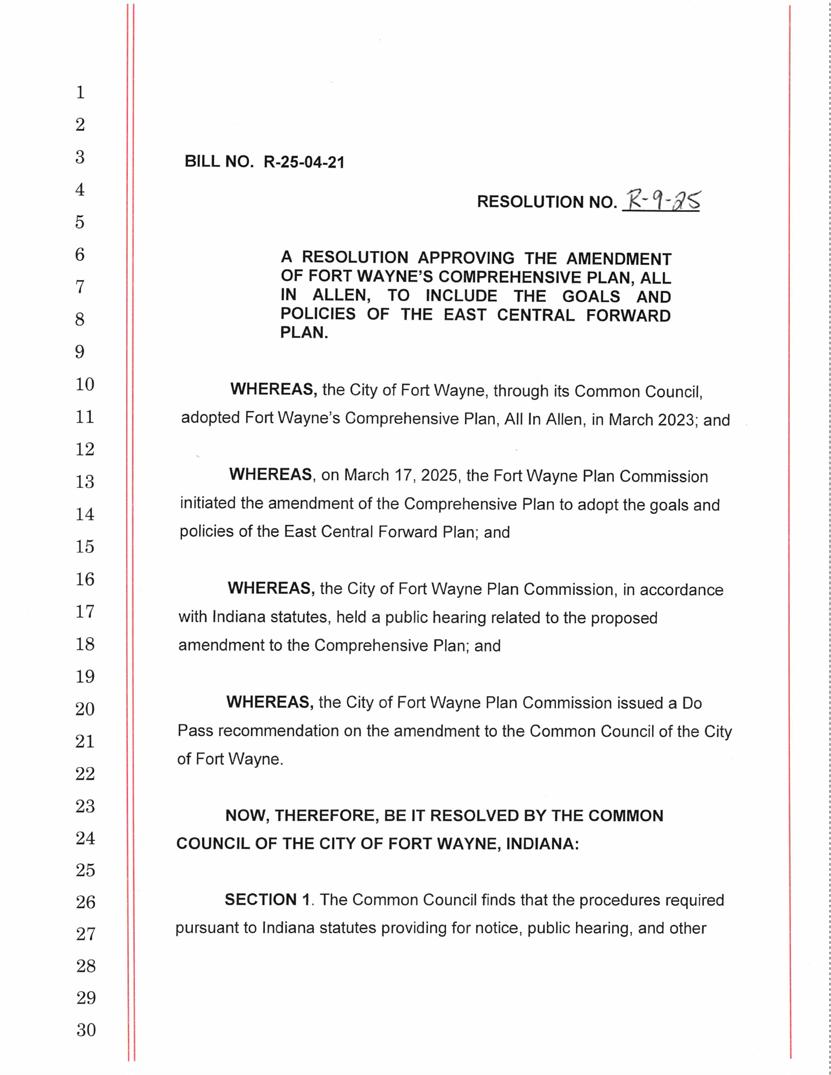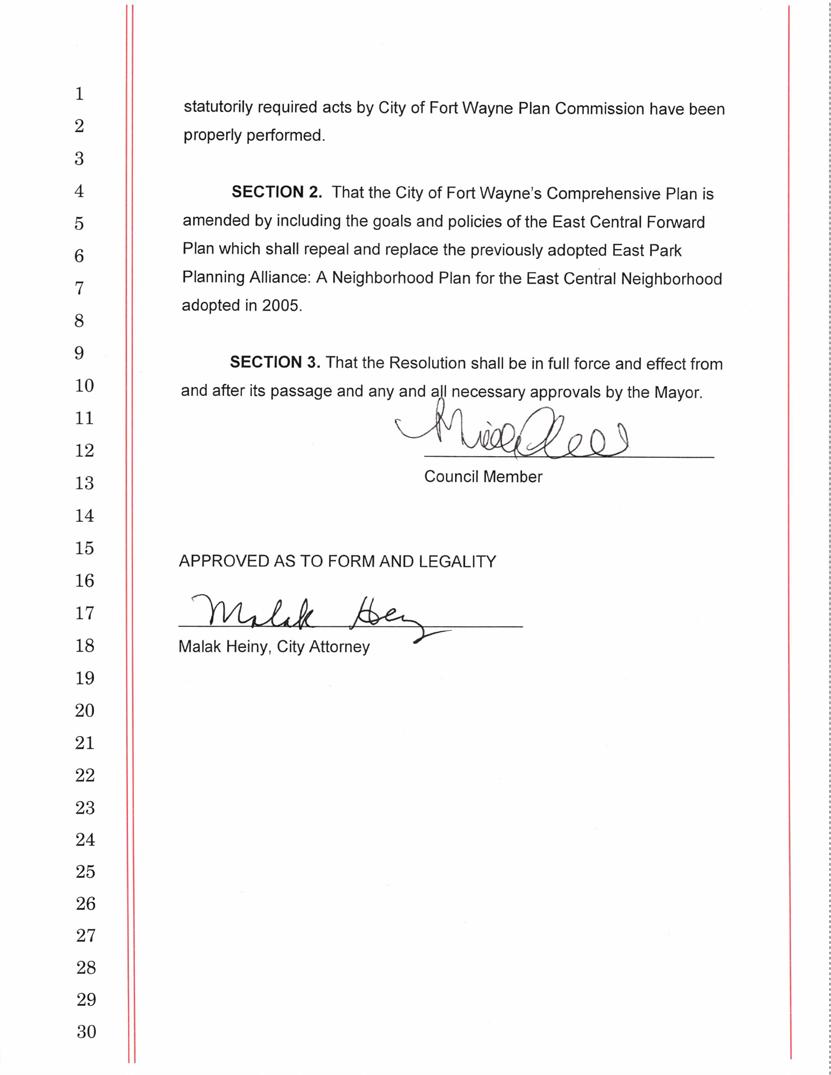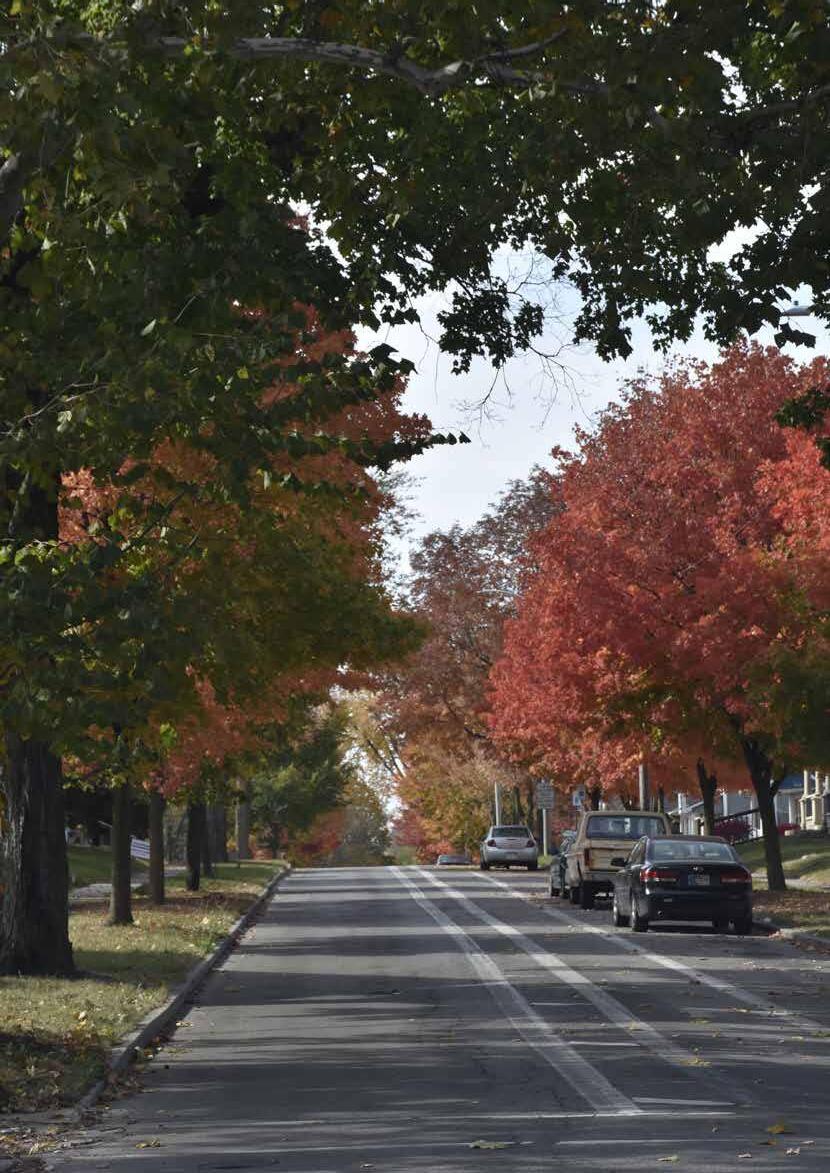
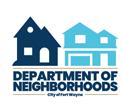
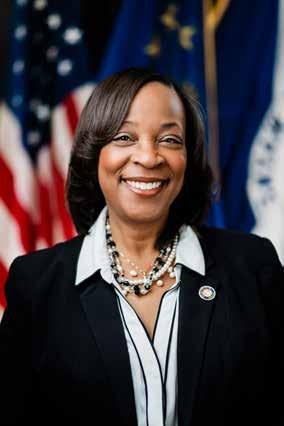




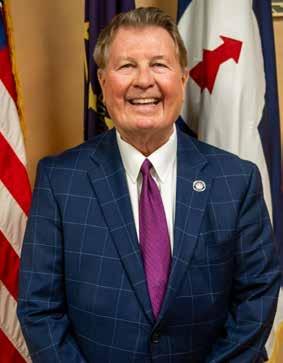
As Mayor of Fort Wayne, I am proud to support the East Central Forward Neighborhood Plan, a vision that enhances the quality of life for all residents. Investing in our neighborhoods is a key priority for my administration because strong, vibrant neighborhoods are essential to the well-being and success of our city. East Central Forward represents a collaborative effort to create a safer, healthier, and more connected neighborhood while honoring the unique history and spirit that makes East Central a special place.
This plan embraces the neighborhood’s stated values: safety, heritage, walkability, housing stability, and wellness. By prioritizing safe streets, accessible sidewalks, and well-maintained public spaces, East Central Forward builds a foundation for community pride and connection. We aim to proactively address public safety through strategic planning, ensuring every resident feels secure in their neighborhood. At the same time, we recognize the importance of preserving East Central’s rich heritage, elevating the stories and places that define the community’s identity.
Walkable neighborhoods are livable, and the plan’s focus on improving pedestrian infrastructure will make it easier for residents to move safely throughout the community. Investing in housing stability is central to our vision, ensuring everyone has access to safe, affordable, and quality homes. Recreation and wellness are equally vital, and this plan envisions parks and community spaces that inspire activity, health, and connection.
Together, we are building a thriving neighborhood. I encourage all residents to take pride in our progress and continue working alongside us to achieve the vision for East Central. Thank you for your dedication and commitment to making Fort Wayne a safe, fun and family-friendly city.
As the Fort Wayne City Councilman for the 5th District, I am honored to support the East Central Forward Plan. Working with engaged and dedicated neighbors, this plan represents the next stage of commitment for investment of time and other resources by the City of Fort Wayne to the residents of the East Central Neighborhood. My sincere thanks goes out to the residents and neighborhood association leadership who selflessly gave of their time to help City staff in the Department of Neighborhoods and others create this plan that will shepherd attention and investment over the next decade.
Now the work of implementation begins.
Through the collaborative planning process, the groundwork has been laid for successful investment and exciting additions to the neighborhood. I look forward to continued engagement and effective implementation.
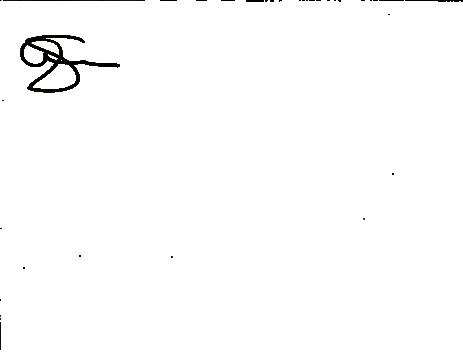

Many people throughout East Central and the City of Fort Wayne have given time and expertise to create this multi-phase neighborhood plan. We greatly appreciate the residents, businesses, community organizations, and other stakeholders who provided their insights, thoughts, and feedback throughout the planning process.
City of Fort Wayne Elected Officials East Central Forward Committee
Sharon Tucker Mayor
Paul Ensley
City Council District 1
Russ Jehl
City Council District 2
Nathan Hartman
City Council District 3
Dr. Scott Myers City Council District 4
Geoff Paddock
City Council District 5
Rohli Booker
City Council District 6
Martin Bender
City Council At Large
Michelle Chambers
City Council At Large
Thomas Freistroffer City Council At Large
City of Fort Wayne Staff
Zoe Auer Fort Wayne City Council
Karl Bandemer Deputy Mayor
Chris Carmichael Property Management
Andy Downs Office of the Mayor
Megan Flohr Fort Wayne City Council
Sherese Fortriede Planning & Policy
Shan Gunawardena Public Works Director
Micky Hall Planning and Policy
Nick Jarrell Public Works
East Central Additional Support
Prof. Suzanne Beyeler Indiana Tech
Cameron Chandler Natl. Society of Black Engineers
Karen Couture Department of Planning Services
Jeff Crane BFA Commercial Photography
Sheila Curry-Campbell Pilgram Baptist Church
Nancy Etro Engineering and Planning Resources
Bernadette Fellows Fmr. Neighborhood Planning Staff
Zach Benedict
Natalie Cryer
Allison Geradot Elise Jones
Maye Johnson
Judy Roy
Elecia Peggins Dan Stoker
Sarah Strimmenos
Kellie Turner
East Central Leadership
Elecia Peggins East Central Neighborhood President
Kellie Turner Fmr. East Central Neighborhood President
Dan Baisden Department Head
Kevin Cobb Engage Fort Wayne Coordinator
Holly Muñoz Resource and Engagement Coordinator
Michael Terronez Neighborhood Planner
Alec Johnson Redevelopment
Kerry Korpela Office of Sustainability
Phil LaBrash Public Works
Nathan Law Planning & Policy
Jodi Leamon Office of Sustainability
Nate Lefever Historic Preservation
Jonathan Leist Community Development Director
Brad Lewis Public Works
Kelly Lundberg Community Development
Chip Gurkin Environmental Protection Agency
Elise Jones Fmr. Greater Fort Wayne Inc.
J.T. King Royal Developments
Megan McConville Engineering and Planning Resources
Garry Morr Fmr. City of Fort Wayne Controller
Ben Roussel Department of Planning Services Director
Nathan Schall Department of Planning Services
Réna Bradley Neighborhood Planner
Megan Grable Neighborhood Planner
Lauren Shank Neighborhood Planner
Steve McDaniel Parks & Recreation Director
James Reitz Public Works
Chanell Ridley Jennings Center Recreation
Chad Shaw Parks & Recreation
Creager Smith
Historic Preservation
Michelle Rupright Public Works
Pat Roller City Controller
Derek Veit Forestry Operations
Patrick Zaharako Public Works Dr. Andrea Robinson Economic Development Director
Allison Vanderhost, EDAC MKM Architecture + Design
Michelle Wood Department of Planning Services
Dylan Wright Natl. Society of Black Engineers
Logan York Miami Tribe of Oklahoma
Connie Haas Zuber Historian
Absentee Landlord
A property owner who does not reside at or near the rental property and is often perceived as less engaged in its maintenance or neighborhood impact.
Adaptive Reuse
The process of reusing an existing building for a purpose other than what it was originally built or designed for.
Affordable Housing
Housing is considered affordable if a family pays no more than 30% of its household income on housing-related costs.
Age Cohort
A group of individuals of the same age or within a defined age range tracked over time for demographic analysis.
Beautification
The action or process of improving the appearance of a person or place.
Block Party
A neighborhood gathering, often held outdoors, designed to build community, celebrate local identity, and engage residents in informal ways.
Building Permits
A type of authorization granted by a government or regulatory body before construction or alteration of a building.
Census Tract
Geographic units used by the U.S. Census Bureau for statistical analysis. Census tracts typically contain 1,200 to 8,000 people and are subdivided into smaller block groups. They do not always align with neighborhood boundaries.
City Beautiful
A design movement from the 1890s to the early 1900s that used grand architecture and beautification to inspire civic pride, encourage moral behavior, and elevate the overall quality of urban life.
Code Violation
An infraction of local building or property maintenance codes, which include issues like unsafe structures, overgrown lots, or illegal occupancy.
Community-Based Organization
A nonprofit or grassroots organization rooted in a particular community, often providing services or advocacy on behalf of residents.
Community Engagement
The process of working with community members and stakeholders to inform, consult, involve, and empower them in the decision-making process.
Complete Street
A street designed and operated to enable safe use and support mobility for all users (cars, bikes, and pedestrians).
Cost Burdened
A household that spends 30% or more of its income on housing costs (including utilities).
Crime Prevention Through Environmental Design (CPTED)
A multidisciplinary approach to reducing criminal behavior by using urban design, maintenance, and social dynamics.
Curb Cuts
A small ramp built into the curb of a sidewalk to make it easier for people using strollers or wheelchairs to pass from the sidewalk to the road.
Deed Restriction
A written agreement in a property’s deed that limits how a property can be used. Demographic Shift
Demographic Shift
A significant change in the composition of a population, such as changes in race, ethnicity, age, or household income over time.
Disinvestment
The process by which public or private sector funding and attention is withdrawn from a neighborhood, often resulting in physical, economic, and social decline.
Economic Leakage
Refers to the flow of money out of a local economy due to spending on goods and services that are produced outside of that economy.
Facade Improvements
Renovations to the exterior of buildings—especially storefronts— to enhance appearance, usability, and appeal to customers and residents.
Flag Stops
A type of public transportation system where buses stop only when requested or people are present at bus stops.
Focus Group
A facilitated discussion with a small, diverse group of people to gather in-depth insights on specific topics or issues.
Food Desert
A census tract that meets both low-income and low-access criteria for healthy and affordable foods.
Green Infrastructure
Natural or nature-based systems (e.g., parks, green roofs, permeable pavement) that improve air and water quality, manage stormwater, and provide habitat for local animals and insects.
Greenspace
An area of grass, trees, or vegetation set aside for recreational or aesthetic purposes.
Health Disparity
A difference in health outcomes between groups, often due to social or economic inequality in defined places.
Health Outcomes
Measures used to assess the health of individuals or populations, such as rates of disease, life expectancy, or mental health indicators.
Highway Speculation
A period when proposed highways created uncertainty that discouraged investment in certain neighborhoods, even if the project was never completed.
Historic Preservation
Any activity that identifies, protects, rehabilitates, or enhances historic resources.
Housing Market Potential Study
A report that analyzes local housing trends and demand to guide future development decisions.
Impervious Surface
A surface (e.g., concrete, asphalt) that prevents water from absorbing into the ground.
Implementation Strategy
A detailed plan that outlines how a recommendation will be carried out, including timelines, responsible parties, and resource needs.
Infill
Adding new building(s) to underused or vacant lands in developed urban areas.
Interactive Mapping Tool
A digital platform that allows users to mark locations, provide input, or report concerns on a neighborhood map to help guide planning decisions.
Land Acknowledgement
A formal statement that recognizes and respects Indigenous Peoples as traditional stewards of the land.
Land Use
The current purpose of a property (e.g., residential, commercial, or agricultural).
Leisure Time Physical Activity
Any physical activity performed during free time that contributes to overall health and fitness (e.g., walking, sports, or recreational exercise).
Listening Tour
A structured engagement activity where officials or community leaders gather public input by visiting and speaking with residents directly, often door-to-door or at community events.
Median Household Income
The annual income earned by households that falls in the middle of a ranked list of all household incomes.
Mixed-Use
A lot or building that contains more than one use, for example, residential and commercial.
Mobile Health Clinic
A traveling healthcare service that provides basic medical care, screenings, or education to communities with limited access to permanent facilities.
Neighborhood Asset
Any feature—physical, social, or institutional—that contributes positively to the quality of life in a community (e.g., parks, community centers, schools).
Neighborhood Commercial Zoning
A zoning classification allowing small-scale commercial uses intended to serve local residential neighborhoods.
Neighborhood Planning Commitee
A group of residents and stakeholders organized to guide and inform the neighborhood planning process, helping ensure community-led decision-making.
Owner Occupied Housing
A home that is lived in by the person or household that owns the property.
Persistent Poverty
A U.S. Census designation for areas with poverty rates of 20% or higher for at least 30 consecutive years.
Place Based Health Improvement Plan
A coordinated strategy to improve health outcomes focused on the specific needs and conditions of a particular geographic area.
Planning Recommendation
A proposed strategy or action that addresses a specific challenge or opportunity identified through community input or data analysis
Plat
A plot of land divided to be owned or sold.
Population Density
The number of people living per unit of area (e.g., per square mile), often used to measure how urban or rural a neighborhood is.
Public Open House
An event where community members are invited to review and comment on plans, proposals, or updates in an informal setting.
Redlining
The discriminatory and now illegal practice of denying loans or insurance based on race or ethnicity.
Renter Occupied Housing
A home lived in by someone who pays a rental payment but does not own the property in which they are living.
Sanborn Insurance Maps
Historical maps used to determine risk associated with insuring properties, often used in practices like redlining.
Summit City Entrepreneur and Enterprise District (SEED)
A City of Fort Wayne program that promotes entrepreneurial initiatives focused on community, economic, and neighborhood development.
Snowball Sampling
A recruiting technique where participants refer other potential participants to a study or initiative.
Social Capital
The networks and relationships among people who live and work in a particular society and enable that society to function effectively.
Social Determinants of Health
The conditions in which people live, work, and age that influence health outcomes and quality of life.
Spot Zoning
The process of singling out a small parcel of land for a use classification different from the surrounding area.
Stakeholder
An individual, group, or organization that has an interest or concern in a particular issue, project, or outcome directly or indirectly impacted by neighborhood planning.
Streetcar Suburb
A residential community whose growth was strongly shaped by streetcar lines.
Survey Instrument
A formal tool used to collect data or feedback from community members, typically through structured questions.
Tax Increment Financing
A financial tool that uses additional property tax revenue generated by new development to fund public infrastructure or other community projects.
Traffic Calming
Tools and methods used to slow down traffic and make the street safer for all users.
Traffic Study
A study used to evaluate a transportation system’s functioning and needs.
Tree Canopy
A measurement of how much area is covered by tree leaves, branches, and stems when viewed from above.
Urban Core
The central area of a city, typically more densely populated and often the economic and cultural hub.
Urban Corridor Zoning
A zoning designation that supports mixed-use, pedestrianoriented development along major urban streets.
Urban Heat Island
The overheating of urban spaces due to heat retention in buildings and paved surfaces.
Vacant Lot
A parcel of land with no existing structure, often resulting from previous demolition and awaiting redevelopment or reuse.
Walkability
The ability to walk to services and destinations within a reasonable distance—often considered a 30-minute or shorter walk.
Wayfinding
Informational signage placed in public areas to help people navigate and identify key locations within a neighborhood or city.
Zoning
Laws that regulate how land can be used (e.g., residential, commercial) and the standards associated with each use.

”East Central Neighborhood honors the lasting impact and influence of our rich history while focusing on the neighborhood’s bright future. The neighborhood is focused on promoting unity, education, advancement, and innovation while connecting residents for sustainable growth.
Elecia Peggins - East Central Neighborhood Association President
East Central Forward is a comprehensive neighborhood planning initiative that articulates a unified vision for the East Central neighborhood of Fort Wayne. Rooted in the community’s long legacy of resilience, diversity and civic pride, this plan establishes a framework to guide growth, investment and neighborhood transformation over the next decade. The East Central Forward plan reflects the aspirations of residents and stakeholders and provides actionable strategies to support a safe, inclusive, and thriving neighborhood.
This plan is designed to:
• Engage residents, stakeholders, and community partners in identifying priorities, challenges, and opportunities for the future of the East Central Neighborhood.
• Establish a shared, community-driven vision that promotes neighborhood revitalization, safety, housing stability, economic opportunity, and quality public spaces.
• Celebrate and elevate East Central’s rich heritage, historic identity, and community leadership as foundational assets.
• Define clear goals and implementation strategies that guide neighborhood, development, public investment, design enhancements, and programmatic initiatives.
• Provide guidance to the East Central Neighborhood, the City of Fort Wayne, decision-makers, public agencies, developers, investors, for-profit corporations and non-profit corporations
WHO DOES IT INCLUDE
• East Central Neighborhood Association
• Residents and community leaders in East Central
• City of Fort Wayne Staff and Departments
• Institutional partners (e.g., Indiana Tech)
• Faith-based organizations, non-profits and foundations in East Central
• Local businesses, investors, and developers
WHAT DOES IT INCLUDE
• Planning Framework (principles, organization, process and timeline)
• Context and Background
• Neighborhood Profile (demographics, health, statistics, traffic, crime and safety, economic development, etc.)
• Strengths and Challenges
• Strategic Recommendations
• Implementation Matrix





The following principles serve as the foundation of East Central Forward, guiding all strategies, actions, and recommendations within the plan. Rooted in the community’s values and priorities, these principles reflect a shared vision for a stronger, more connected, and resilient neighborhood. They respond to both present-day challenges and long-term opportunities, ensuring that East Central remains a place where residents feel safe, supported, and proud to call home.
We believe that all residents deserve to feel safe in their neighborhoods. East Central Forward prioritizes strategies that strengthen public safety, encourage community involvement, and create inviting public spaces. By fostering a greater sense of trust, connection, and visibility, we aim to enhance safety and peace of mind throughout East Central.
East Central’s past is a source of strength and identity. This plan supports efforts to celebrate the neighborhood’s cultural heritage, honor those who have shaped it, and preserve historic places and stories. By elevating community memory, we build pride and support connections to East Central for future generations.
A walkable neighborhood is a livable neighborhood. East Central Forward emphasizes the importance of safe, connected, and accessible pedestrian infrastructure. We prioritize sidewalk improvements near schools, parks, and activity centers to promote healthier lifestyles and improve mobility for people of all ages and abilities.
Stable, quality housing is the heart of a strong neighborhood. East Central Forward promotes housing that is safe, affordable, and well-maintained. Supporting reinvestment in existing homes, responsible infill development, and policies that help residents remain in their homes and build long-term stability.
Access to recreation and wellness resources is essential to community well-being. East Central Forward advocates for the enhancement of parks, trails, and community spaces as hubs for physical activity, connection, and health services. Ensuring that every resident has access to safe, vibrant places to play, gather, and thrive.





East Central Forward is a guiding document developed to support coordinated action and reinvestment in the East Central neighborhood just east of downtown Fort Wayne. This plan reflects a shared community vision informed by the neighborhood’s rich history and lived experience. It includes its role as the city’s first historically Black neighborhood and its journey through periods of growth, disinvestment, and resilience. It is intended to be used by the East Central Neighborhood Association, City of Fort Wayne departments, Allen County departments, nonprofit and for-profit partners, developers, residents, business owners, and other stakeholders whose decisions and efforts impact neighborhood outcomes. It also provides direction for projects and initiatives that can be led or supported to move East Central forward.
East Central Forward outlines a comprehensive yet adaptable framework for neighborhood improvement. The plan is organized around Goals, Strategies, and Action Steps that provide practical, communityinformed pathways to guide investments in safety, housing, connectivity, and well-being. While broad in scope, the plan is intentionally designed to evolve in response to the neighborhood’s changing needs and serve as a foundation for more detailed project planning, engagement, and implementation.
The maps, diagrams, illustrations, and photos included in East Central Forward are intended to communicate key themes and ideas that emerged throughout the planning process. These visual tools help translate complex information into accessible content and reflect the community’s voice during outreach efforts. While they do not guarantee specific outcomes, they represent shared aspirations and provide a visual guide for future planning. The success of this plan depends on continued collaboration, community priorities, available resources, and the sustained engagement of neighborhood partners.
A neighborhood plan is an essential tool that allows local stakeholders to come together to shape the future of their community. Residents, businesses, and institutions can identify a shared vision through the planning process and outline strategies to achieve it. Neighborhood plans help guide growth and development in ways that reflect community priorities. They provide detailed recommendations tailored to the area’s unique needs, something a citywide comprehensive plan cannot fully capture. The last neighborhood plan for East Central was developed in 2005 and much has changed over the past two decades. Updating the plan ensures that it reflects the current realities and aspirations of the community, laying the foundation for thoughtful, inclusive, and sustainable growth.
Portions of East Central Forward made responsible and transparent use of Artificial Intelligence (AI) tools to support specific aspects of the research and writing process. They were employed to assist with language refinement, summarization of data findings. At no point did AI replace the author’s own critical analysis, original ideas, or ethical reflections; rather, AI outputs were carefully reviewed, verified, and contextualized within the broader research conducted in the planning process. The limitations and potential biases inherit in AI-generated content were acknowledged, and extra measures were taken to cross-check accuracy against reliable sources.
Effective neighborhood planning relies on genuine and widespread community participation. East Central Forward was developed through extensive engagement with diverse community stakeholders including residents, local businesses, faith-based and non-profit organizations, foundations, and other community institutions. The engagement strategy utilized a combination of in-person meetings, workshops, door-to-door outreach, and online participation opportunities conducted from 2023 to 2025. Additionally, a neighborhood planning committee composed of East Central residents and organizational representatives guided the overall process.,
Below is an overview of the primary engagement activities and summarized findings:
East Central participated in the first cohort of the City of Fort Wayne’s Department of Neighborhood’s FORTify Neighborhood Accelerator in 2023. The city-led initiative aimed to support neighborhood leaders by providing workshops, mentoring, and resources to strengthen neighborhood advocacy and organization skills.
Through the FORTify Listening Tour resident volunteers, City staff, and local partners conducted door-to-door outreach within the East Central neighborhood. This effort included personal interviews and surveys, resulting in input from over 90 individuals and completion of 43 detailed surveys.
Additional feedback was gathered during the 2023 East Central Block Party, where another 32 surveys and 84 points of community input were collected through interactive project boards. Youth input was specifically encouraged through youth-targeted engagement activities, with 15 children and teenagers contributing their perspectives.
The community feedback obtained from these activities directly informed the key priorities highlighted throughout the East Central Forward neighborhood plan.
Key Neighborhood Priorities: Based on community input, residents identified several key priorities to guide recommendations in the FORTify community engagement process:
Residents expressed a clear desire for cleaner streets, reduced litter, and enhanced greenery including more street trees and flowers.
Safety and Crime Reduction
Safety consistently emerged as a significant concern. Residents frequently emphasized the need for improved street and sidewalk lighting, regular and meaningful interactions with local police, and measures to reduce neighborhood violence.
After experiencing significant demolitions over several decades, residents stressed the importance of developing quality housing opportunities, promoting affordable homeownership, and addressing potential displacement due to rising housing costs from downtown Fort Wayne’s recent growth and expansion.
Neighborhood Infrastructure
Residents prioritized improvements to infrastructure, specifically highlighting the need for repaired sidewalks and alleys, street enhancements, and additional lighting to improve safety and connectivity. Although appreciative of recent improvements, residents felt more action is necessary to improve safety in the neighborhood, and how infrastructure supported could help support those concerns.
Recreation
Community members indicated a strong interest in improved recreational amenities, emphasizing the need for safe play spaces for children, wellmaintained basketball courts, and comfortable seating near playground areas.
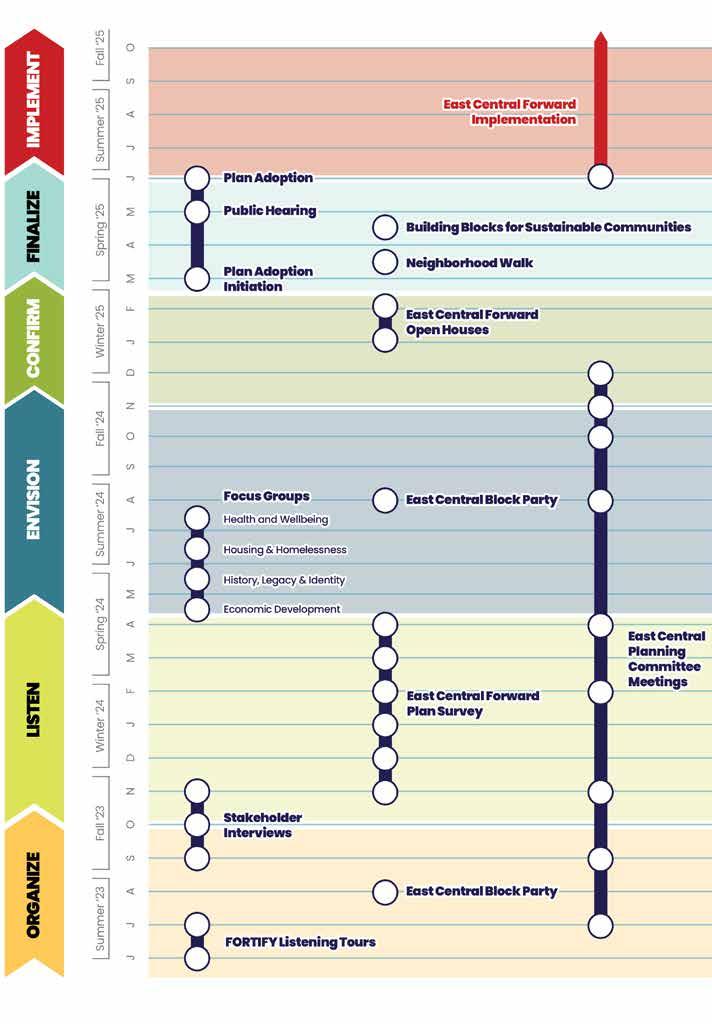
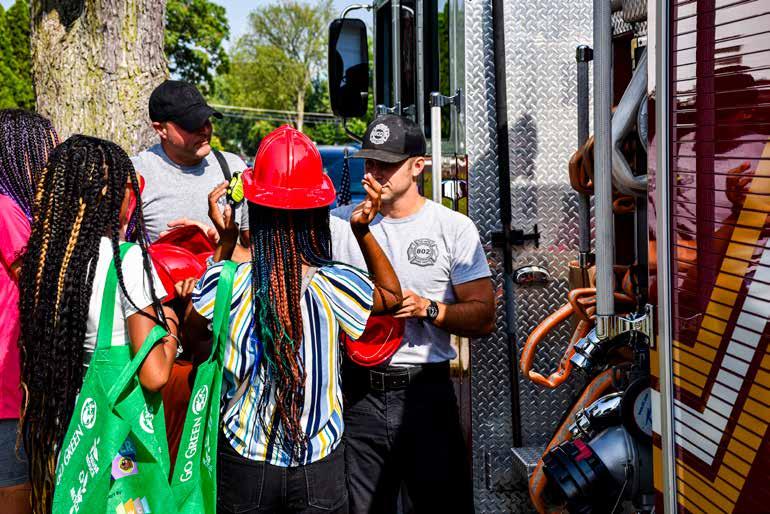
FORTify Block Party and FWFD Department of Neighborhoods
In order to gather diverse and in-depth perspectives directly from those most familiar with the neighborhood, the City of Fort Wayne’s Department of Neighborhoods held over 40 one-hour one-on-one stakeholder interviews in 2024. Each interview began with a series of similar questions, such as (1) what is an important asset or identity about East Central, (2) what brought you to the neighborhood, (3) what do you believe are some opportunities in the neighborhood, and (4) what specific details do you think the East Central Forward neighborhood plan should address. East stakeholder was then given ample time to ask additional questions and provide input that may not have been asked during the sample questions portion of the interview. To ensure a wide variety of stakeholders were asked to participate in the effort, each person interviewed was asked to provide the name of another person who should be contacted within the neighborhood.
Much like the FORTify listening tour, the feedback obtained from these interviews directly informed the key priorities highlighted throughout the East Central Forward neighborhood plan.
Key Neighborhood Priorities: Based on stakeholder input, several key priorities, much of them overlapping with previous input were identified from stakeholder interviews:
Many residents expressed the need for increased street lighting, better sidewalk connectivity, and improved relationships with the Fort Wayne Police Department to address safety concerns consistently raised by stakeholders.
Stakeholders noted they would like to see new, quality housing construction in the neighborhood, and improved maintenance standards for the existing housing stock, particularly to address absentee landlords.
Several stakeholders noted during the interviews that they would like to see improved aesthetics in East Central, specifically well-maintained parks
and gathering spaces, landscaping, cleaner streets and sidewalks, and improved sidewalk conditions to make the neighborhood more accessible.
Many of the stakeholders interviewed noted they would like to see expanded access to recreational and youth-oriented facilities in the neighborhood, either through increased programming at the Jennings Center, or through strategic partnerships at Indiana Tech. An overwhelming emphasis was placed on ensuring the long-term sustainability and viability of the Jennings Center as residents find it the most important asset in the neighborhood and want to see its continued growth.
While most stakeholders noted that the neighborhood alone could not solve the issue of homelessness, many wanted increased collaboration with organizations and institutions to address root causes of homelessness, improved resource availability, and increased effective outreach to vulnerable members of the community.
To ensure that the East Central Forward neighborhood plan reflects the residents’ priorities, the City of Fort Wayne launched a resident survey.
Over 120 surveys were collected during the engagement period through both in-person outreach and online submissions. Residents completed a 25-question survey that explored a wide range of issues facing East Central. In addition to the survey, participants were encouraged to use an interactive online mapping tool to pinpoint specific locations where they would like improvements.
To support these efforts and broaden participation, the City launched EastCentralPlan.com, a dedicated project website. The site served as a central hub for engagement, offering residents access to project updates, meeting announcements, survey links, and interactive tools. Since its launch in Fall 2023, the website has had over 1,500 visitors, showing the strong community interest in shaping the future of the neighborhood.
Feedback gathered through both the survey and mapping tools revealed clear and consistent themes, which have helped shape the priorities of the plan.
Key Neighborhood Priorities: Based on survey responses, several key priorities were identified, many
of which are similar to results from other engagement efforts:
Residents expressed serious concerns about vacant and abandoned homes, poorly maintained properties, and abandoned trailers and vehicles, especially along key corridors like Anthony Boulevard and Washington Boulevard.
Pedestrian Safety, Sidewalks, and Street Lighting
There is a strong demand to improve pedestrian safety by repairing existing sidewalks throughout the neighborhood, upgrading crosswalks to meet ADA accessibility standards, enhancing street lighting, especially on Hanna, Lewis, and Monroe Streets, and connecting East Central to the existing trail network.
Residents raised concerns about poor health outcomes in the neighborhood. Access to healthcare services, including mobile clinics and preventative health education is seen as an essential opportunity to improve community wellness.
Housing affordability, property maintenance, and the need for new housing options are major concerns by residents. While supporting homeownership and holding landlords accountable for property conditions were a priority, an overwhelming number of survey responses wanted to ensure East Central remained affordable and accessible to the community.
Celebrating East Central’s diverse history and cultural legacy is a clear priority. Residents expressed a desire to honor Black and immigrant narratives through public art, signage, and community events. Notably, residents also wanted to celebrate gateway features in the neighborhood, clearly defining the boundaries of East Central, and install public art and historic markers to tell local stories.
Safety improvements throughout East Central are considered critical to the long-term health of the neighborhood. Residents emphasized the need for proactive crime prevention efforts, such as enhanced lighting, and improved environmental design efforts, would help improve safety and security for residents.
Focus groups were essential to the East Central Forward neighborhood planning process, as they offered structured, yet informal settings for residents, local business owners, non-profit representatives, and other stakeholders to openly discuss critical issues facing the East Central neighborhood. These sessions were crucial to deepen understanding of complex concerns and bring together diverse voices in an effort to collaborate between community members and local organizations serving the neighborhood.
The focus group topic areas were inspired by members of the planning committee, who had been reviewing the results of the surveys, listening tours, and stakeholder interviews. Each focus group was led by an outside facilitator, including three by Geoff King of Love Fort Wayne, and one by Zach Benedict of MKM Architecture + Design. This method was preferred to ensure that attendees did not feel dissuaded to share concerns in front of City of Fort Wayne staff or elected officials.
The first of four focus groups was held on May 20th, 2024, at the Community Foundation of Greater Fort Wayne. The key insights gathered from participants at this focus group help shape the recommendations found in this plan:
East Central’s strategic proximity to downtown Fort Wayne positions the neighborhood for significant economic growth, particularly given the abundance of vacant land – much of which is owned by local institutions and churches. Residents see this available land as a catalyst for new development opportunities that could bring needed vibrancy to the area.
A critical need identified by participants in the focus group is the expansion of local food retail and restaurant options. With Indiana Tech students and families seeking more neighborhood amenities, East Central has a prime opportunity to focus on growing these sectors, especially by creating family-friendly destinations and services.
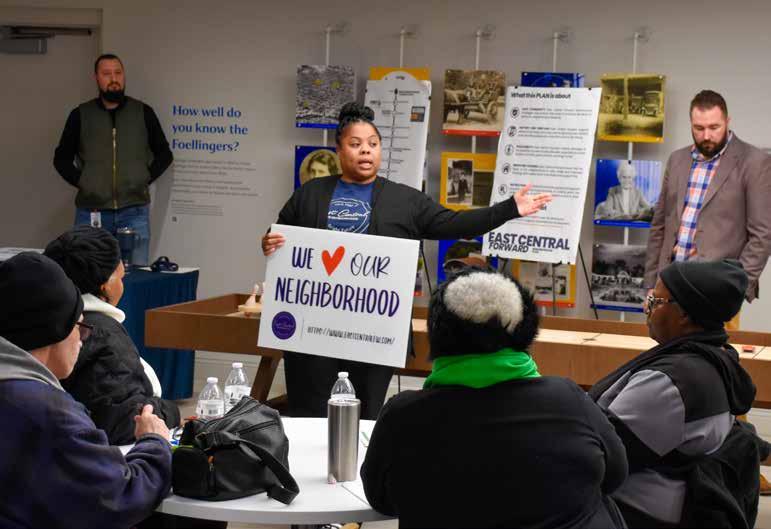
The revitalization of both the Jennings Center and Hanna Homestead parks was another priority. Participants envision both of these spaces as vibrant community hubs that offer expanded programming, promote wellness, and create recreational and wellbeing opportunities for all ages.
However, safety and livability concerns must be addressed first to realize this vision. Residents expressed the importance of improving infrastructure to support walkability, enforcing safe housing standards, and maintaining public cleanliness. In addition, a proactive partnership with existing service organizations is necessary to address the rising homelessness issues, which residents and business owners alike noted are creating safety concerns that could deter future homeowners and businesses from investing in East Central.
East Central’s path forward is clear: strengthen core infrastructure, leverage existing neighborhood assets, build strategic partnerships, and activate available land to drive sustainable, community-centered economic development.
The second of four focus groups focused on preserving East Central’s diverse cultural and historical legacy was held on May 31st, 2024, at MKM Architecture + Design. The key insights gathered from participants at this particular focus group were critical to helping shape recommendations in the plan that are rooted in the core identity of the East Central neighborhood:
Residents who attended emphasized an outsized importance in honoring the East Central neighborhood’s rich history, including the significant contributions of Black, Jewish, Native American and immigrant communities that developed much of the community. Historic preservation was also recognized, not only as a matter of cultural pride but also as essential to strengthen the community’s identity, fostering cohesion and guiding future development.
Participants highlighted the urgent need to restore and protect historic sites in the East Central neighborhood, including the Brighton House, a documented part of the Underground Railroad, and the African American History Museum. These landmarks are seen as vital anchors for community storytelling and neighborhood revitalization.
Residents believe that leveraging East Central’s unique history can attract investment, promote tourism, and inspire a new generation of residents and entrepreneurs
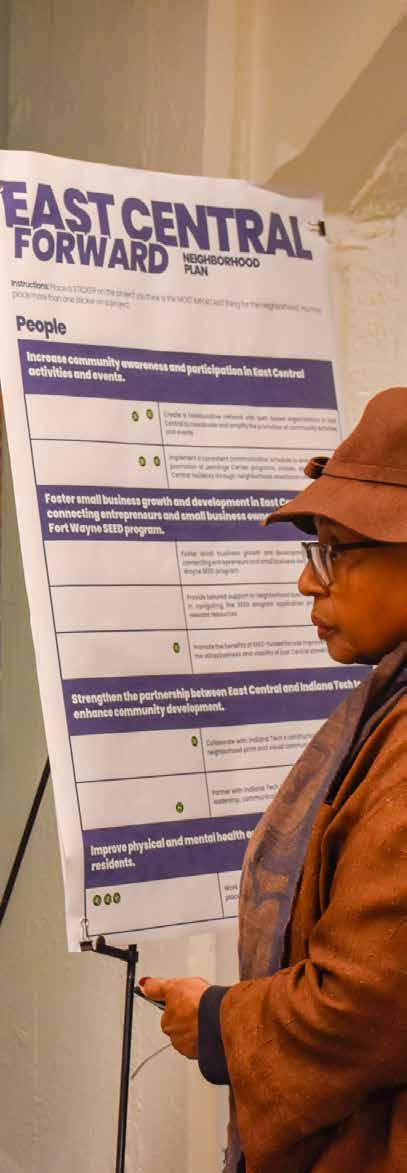

to engage with the neighborhood. Participants in the focus group recommended several steps to advance this, which is outlined in the Recommendations segment of the plan.
East Central’s path forward is clear: Preserving and celebrating East Central’s deep history and unique identity is not just about honoring the past – it is a strategic investment in the neighborhood’s future vitality and long-term resilience.
With significant concerns in previous surveys, listening tours and stakeholder interviews surrounding housing and increased homelessness, the third of four focus groups was held on June 24, 2024, at Indiana Tech to discuss the topic. Several key insights gathered from focus group participants help influence recommendations in the plan:
As East Central continues to change, providing safe, stable, and affordable housing is essential to the longterm vitality of the neighborhood. Several residents identified the need to expand affordable and accessible housing options, particularly for the neighborhood’s aging population. As the neighborhood continues to attract older residents, especially because of its proximity to downtown and nearby service providers, both physical design of homes and supportive services such as independent living skills training
were considered critical for maintaining a strong and inclusive multi-generational neighborhood.
Participants also emphasized the importance of enabling diverse housing development options through proactive policies and zoning reforms, allowing a broad mix of housing types to meet the needs of residents while encouraging neighborhood stability and promoting growth. Most of the group also expressed ongoing concerns about absentee landlords and shared that poor property maintenance and high vacancy rates are holding the neighborhood back from its full potential. Most of those in attendance would like to see property owners held accountable and promote higher standards for rental housing in the neighborhood.
Finally, tackling the issue of homelessness in the neighborhood was discussed. Participants noted that housing insecurity requires a coordinated, comprehensive response. Residents stressed that expanded shelter options, day-centers, street outreach, and integrated social services must be prioritized through city-wide collaboration.
East Central’s path forward is clear: Ensuring accessible, high-quality housing and addressing the increasing concerns surrounding homelessness are fundamental to East Central’s vision for a resilient, inclusive, and thriving future.
The final of four focus groups was centered on addressing the urgent health and wellbeing challenges facing East Central, and was held on June 26th, 2024, at the Foellinger Foundation. Participants in the focus group were keenly aware of the existing challenges facing the 46803-zip code, and stressed that improving access to quality healthcare and an improved built environment must be a top priority in recommendations outlined in the plan:
Participants in the focus group discussed that the best way to address the health needs in the neighborhood is to establish potential partnerships with major healthcare providers, such as Parkview Health and Bowen Health. While constructing a critical access facility would be hard to justify, attendees discussed considering a mobile clinic service at accessible community locations like the Jennings Center. This approach was seen as a practical and immediate solution to reduce barriers to care, particularly for children and residents without reliable transportation.
In addition to clinical services, participants emphasized the critical importance of increasing community awareness around health issues such as diabetes, hypertension, and mental health conditions. Preventative education campaigns and outreach initiatives were recommended to empower residents with knowledge and resources to manage and improve their long-term health outcomes.
Recreational opportunities and mental health support were also highlighted as essential components of holistic wellbeing. Participants encouraged the creation of programs that promote physical activity, community engagement, and access to mental health resources to build a healthier East Central.
East Central’s path forward is clear: Strategic partnerships, expanded healthcare access, preventative education, and wellness programming are all vital to transforming East Central into a community where every resident has an opportunity to live their lives to the fullest.
On August 10th of 2024, the Department of Neighborhoods joined the East Central Block Party at Hanna Homestead Park to provide an opportunity for residents to share their voice. Residents were able to enjoy live music, public art, street dancing, free food, as well as a chance to meet neighbors and provide more guidance to the East Central Forward plan. The discussions were
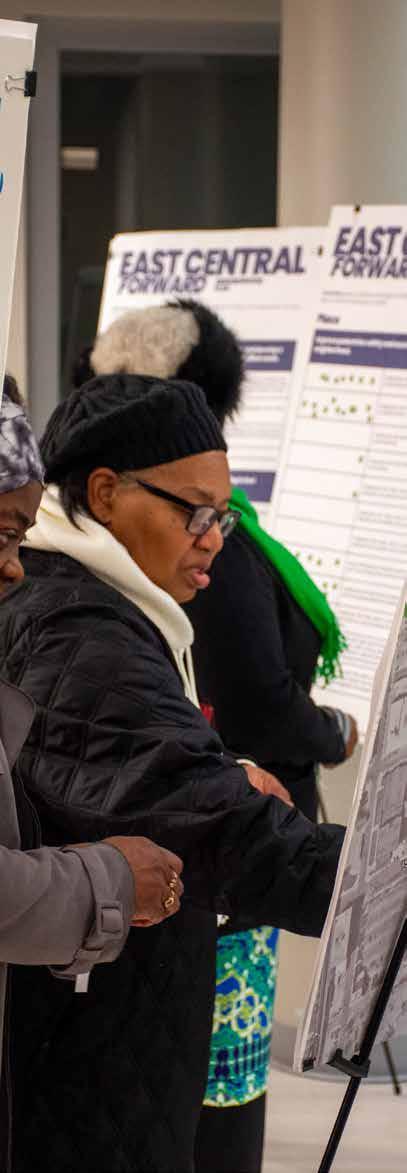
Residents Prioritizing Plan Strategies
positive, with residents expressing the deep value they have for their community and Hanna Homestead Park. This event also showcased the multigenerational roots of residents, telling stories of the old baseball diamond, swing sets, and the longevity of their family ties to the park. The block party engagement helped to narrow the scope of priorities that the community had established in previous engagement, and ultimately shaped the strategy that focus on housing, parks, safety, and community.
On February 19 and 20, 2025, two public open houses were held at MKM Architecture + Design located in the southern half of East Central, and the Foellinger Foundation located in the northern half of the neighborhood. The goal of these two events was to have members of the community review the recommendations outlined in the East Central Forward plan and provide additional community feedback. More than 75 residents attended the two events, engaging with staff from the City’s Department of Neighborhoods, in addition to members of the East Central planning committee. Overall, community members expressed strong support for the proposed recommendations, validating the direction of the plan.
Attendees also offered suggestions to strengthen specific action steps, ensuring that the implementation strategies outlined in the plan are both realistic and responsive to neighborhood priorities
Councilman Geoff Paddock and neighborhood leaders hosted a neighborhood walk on April 25, 2025. The walk hosted city division leaders, local religious congregation members, and other interested residents, and toured key points of interest. Common concerns included dilapidated alleys, high crime intersections, and houses with consistent code violations. Several homes were known concerns to the code enforcement officers in attendance, and the group discussed limitations of what could be done without beginning the process of demolition due to inheritance issues. The group agreed that demolition should be avoided, if possible, to preserve a viable home in a neighborhood with as many vacant lots as East Central. Several homes were also flagged as either currently or previously being occupied by upwards of a dozen squatters. The intersection of South Hanna Street & East Lewis Street was toured and concerns with persistent high crime were discussed with FWPD leadership present. Certain
alleys in poor condition were flagged for investigation into possible repairs.
In early spring 2025, the City of Fort Wayne Department of Neighborhoods was awarded the Environmental Protection Agency grant Building Blocks for Sustainable Communities. The grant focuses on a collaboration between a community and agency, in this case the City of Fort Wayne and the East Central Neighborhood, and engages the community to identify strategies for building environmental resilience. The grant in the 2025 cycle focused on extreme heat resilience, a natural continuation of the work of the City to map the urban heat island through a grant with the National Oceanic and Atmospheric Administration (NOAA) and this neighborhood plan.
Community engagement included a pilot youth engagement portion, in which Indiana Tech’s National Society of Black Engineers collaborated with the Department of Neighborhoods and Professor Beyeler, head of the Environmental Science & Sustainability Program at Indiana Tech. The students visited the Jennings Center, a community center located in the East Central Neighborhood, and taught the students about extreme heat, did site visits to two parks, and walked the neighborhood. The results of the students’ engagement will be featured in a larger community engagement event in July 2025, in which the East Central Neighborhood will be informed about the risks of extreme heat and asked to provide input on how best to address this climate resiliency issue in their own neighborhood.
The students identified the following primary concerns and opportunities:
Indiana Tech & Jennings Center students identified an increased tree canopy as a major opportunity to reduce heat islands in their community. In particular, they wanted increased tree canopy along major corridors, near and in neighborhood parks, and along streets surrounding the Jennings Center.
Students identified how cooling the pond at Lakeside Park is and identified a desire for a water feature or recreational water infrastructure in their own neighborhood.
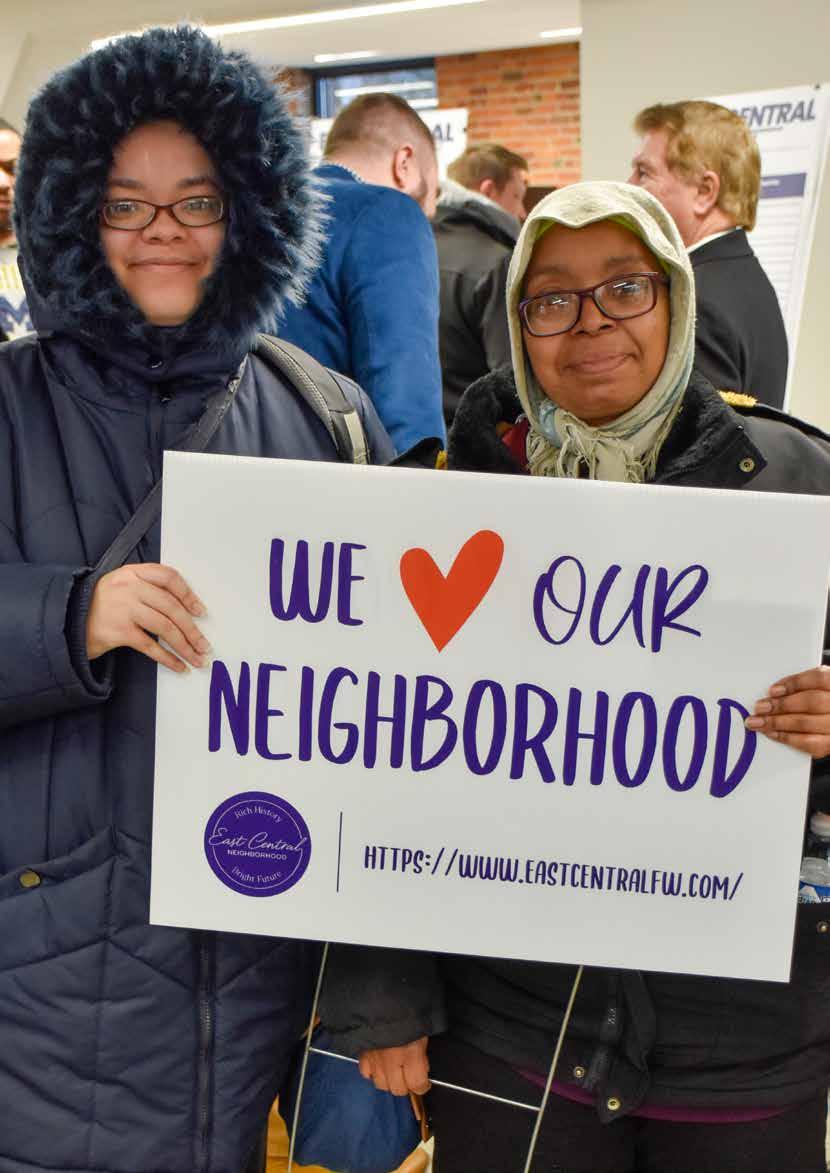
“We Love Our Neighborhood”
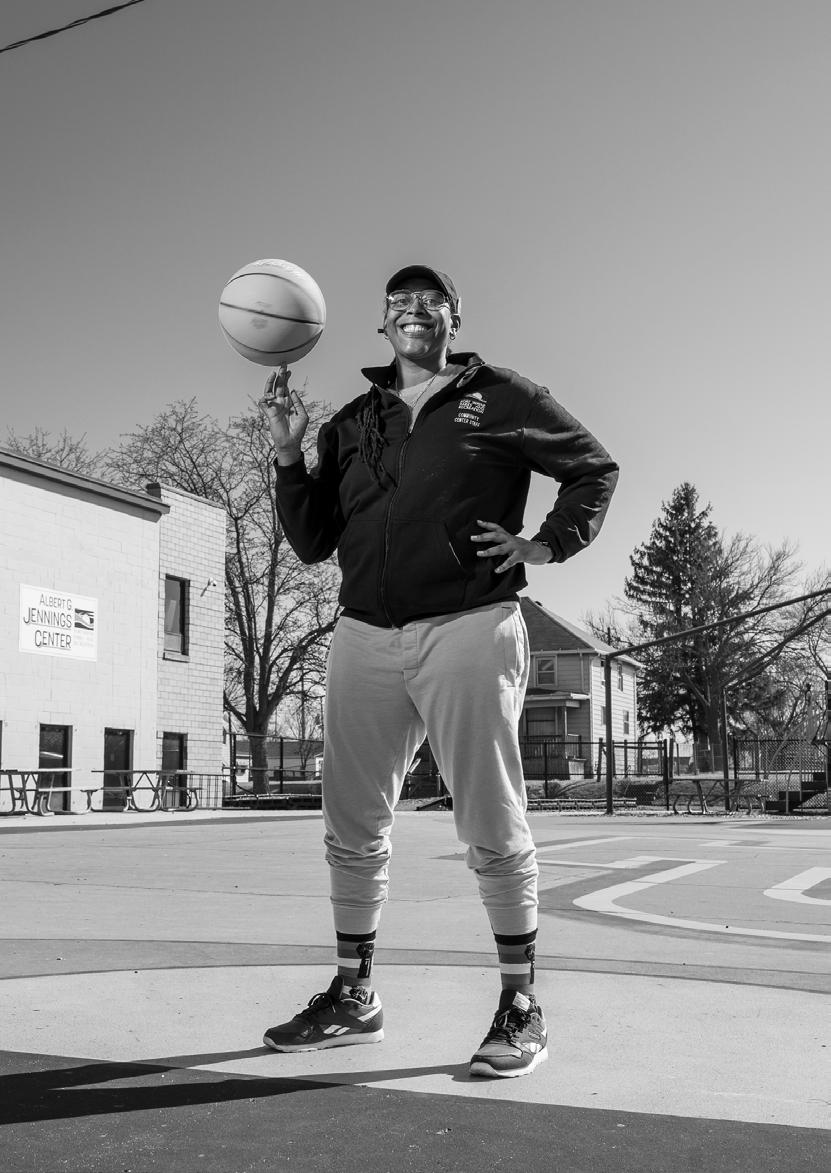
”In East Central Fort Wayne, I see a vision of growth and responsibility for our youth. To re-create generational wealth while thriving within their own community.





Written By: Connie Haas Zuber, Local Historian, Fort Wayne
Edited By: Logan York, kaakiihsitaakia/ Tribal Historic Preservation Officer, Miami Tribe of Oklahoma
The neighborhood we know as East Central is where the big events of the world have been happening — to the land itself and to the people who live on it — for a very long time.
From geological history, through human history, including precontact history and the years of European colonization, blooming into the ongoing great American experiment, as George Washington called it, what Fort Wayne now knows as East Central was and is a place where things happen, people’s lives are lived, and the world grew and changed into the one we know today.
Three dramatic and significant events frame how the years played out before there was a central Fort Wayne to provide a setting for an East Central Neighborhood.
The first happened as the Ice Age was ending and gives East Central a starring role in how Fort Wayne earned its nickname as The Summit City.
The East Central Neighborhood encompasses within its boundaries evidence of events from more than ten thousand years ago when the last glaciers were melting and receding northeast away from Northeast Indiana.
East Central includes land south of the Maumee River that was beneath Glacial Lake Maumee, the giant lake created 12,000 or so years ago as the last glacier to cover this area retreated and melted before forming Lake Erie. It also includes parts of the Fort Wayne Moraine, the ridge of soil and rocks the glacier pushed before it that formed the wall that held back the lake waters — until it couldn’t
Written By: Connie Haas Zuber | Edited By: Logan York
anymore. Around what is now the confluence of our three rivers, the moraine was overtopped and failed, releasing an unthinkably huge torrent of icy water west toward what is now Huntington. The resulting outflow channel was wide. Maps show the breach in the moraine stretching from a southern edge along what is now the East Wayne/East Berry corridor in East Central to its northern edge almost out to North Side High School. It’s long, too, stretching west past the Eagle Marsh area to Huntington and the Wabash River. The glaciers and outflow left a continental divide that canal surveyors measured, giving Fort Wayne its nickname of Summit City.
Animals and people came here to live as the ice retreated, as they followed the ice toward livable land everywhere on the continent. East Central was high ground, a good place to hunt and make shelter but still conveniently close to the river for water, finding food and transportation, so people would likely have camped or settled here. The archaeological evidence of precontact and European cities in the area of East Central is undiscovered, which is not surprising, given that the city of Fort Wayne was built up over any sites before archaeology became a scientific discipline. When Indiana’s founding scientific archaeologist Dr. Glenn A. Black did his Allen County Archaeological Survey in 1936, he identified sites mostly outside the city limits. His work confirmed that prehistoric and historically familiar native American peoples lived in the county.
Myaamia is the correct spelling of the “Miami,” although often referred to this way, including in our local middle school.
Kiihkayonki is often, even in the City seal, misspelled as Kekionga, and that it is often mistakenly attributed to mean “blackberry patch.” This is according to experts and language speakers at the Myaamia Center at Miami University.
The Myaamia people had been in residence here since early in their history as a people with what became their largest and best-known settlement called Kiihkayonki. Kiihkayonki, on the opposite bank of the Maumee River from East Central, was the heart of a cluster of native settlements at the three rivers and in this area during historical times. Though none of the settlements were centered in East Central, people lived in the area. The area was the home of native peoples in agrarian permanent villages for 1,000 years before European contact.
The portage was owned by the Myaamia people, specifically one person named Tacumwah.
Northwest Confederacy is often incorrectly referred to as the “Miami Confederacy,” because these were Miami homelands, but other tribes were also in the area. The Confederacy was co-led by Little Turtle (Mihšihkinaahkwa), Blue Jacket, and Buckongehelas. It is referred to as “Taawaawa siipiiwi alliance” by the Myaamia today.
During the era of contact with Europeans, which began in the late 1600s, French missionaries, soldiers and fur trappers were the first Europeans to be active here. The portage between the Maumee River and the Little River in southwest Allen County (which leads to the Wabash and on to the Mississippi) created by the glacial torrent was a key link for the French between their North American footholds in Quebec and Louisiana. Once the French, who ceded their control of this area to
the British after a war, and then the British, who lost the Revolutionary War to the American colonists, ceded their control, the Americans invaded and claimed the lands previously occupied by the Northwest Confederacy. In 1790, when American troops invaded Kiihkayonki, it was a large and cosmopolitan native city with many hundreds if not thousands of residents, well supplied with crops from its fertile fields along the rivers and at the center of a network of communication links.
East Central became part of the site of the 1790 attack on Kiihkayonki by U.S. Gen. Josiah Harmar, who sent four companies into battle through East Central into Kiihkayonki only to be decisively beaten by the natives led by Little Turtle. The surviving Americans, who lost 183 soldiers that day, retreated as they had attacked, through the forest of East Central.
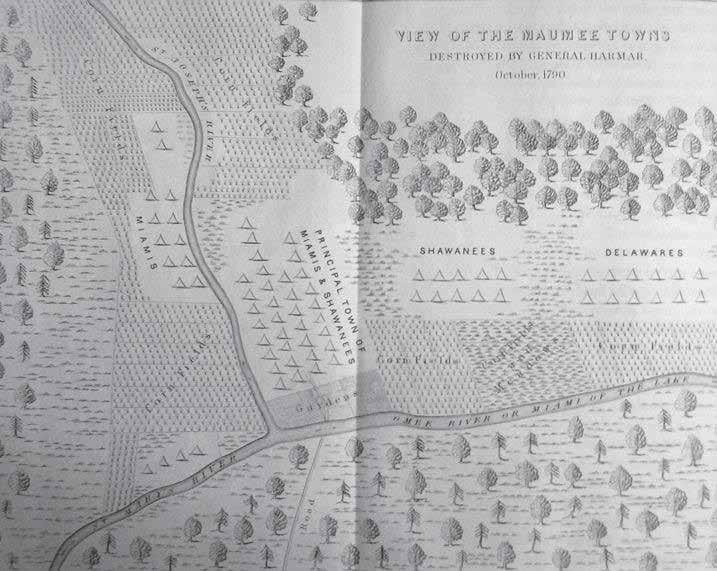





The outcome four years later was very different. Gen. Anthony Wayne had won the Battle of Fallen Timbers near Maumee, Ohio, and he marched his troops toward Kiihkayonki but chose the higher land of East Central to build a fort. Kiihkayonki still existed across the rivers. He dedicated the first Fort Wayne, which was built in East Central at what is now the corner of Clay and Berry Streets, purposely on the fourth anniversary of Harmar’s defeat, well aware of the symbolism of the date and its location across the river from Kiihkayonki. The battle of Fallen Timbers was waged, this one with roughly 500 Native troops and 2,000 American troops present. 84 men died, 44 of whom were Americans. The British troops, which had previously supported and promised to support the Native troops, locked the retreating Native troops out of the British fort. When the Northwest Confederacy (Taawaawa siipiiwi alliance) realized that they no longer had British support against the invading American troops, they concluded that they could not win the war and the confederacy broke. Later, the Myaamia surrendered at the Treaty of Greenville.
The second and third Forts Wayne, built to replace the hastily built and decaying original, were also built in East Central in the area of what is now Old Fort Park, directly next to current Fire Station 1, at the northwest corner of E Main Street and Clay Street. The final 1815 fort was decommissioned in 1819.
Current day Harmar Street is a reference back to the history of Harmar’s Defeat, and the Coombs Street bridge crosses the Maumee at Harmar’s Ford.
The forts changed the East Central landscape because the American military not only felled trees to build them, but it also cleared a large area around its forts for a clear view of approaching friends or foes and a good field of fire. About four square miles were cleared around the 1815 fort. The clearing provided a striking view of the beautiful and promising place the Americans had won control of after the Native peoples had fought for nearly 200 years to protect their homeland from the invasion and wars following the arrival of the French, the British, and finally the Americans.
The process of change from a Native village to a military outpost to a city began slowly, given the location’s isolation and distant connections
Written By: Connie Haas Zuber | Edited By: Logan York
to even the nearest European settlements. The wheels of change began to spin in the 1820s and accelerated in the 1830s when the roots of East Central were planted. Federal regulations that made land sales possible had been established, and Allen County was created in 1823, the same year land was bought and platted as the Original Plat of Fort Wayne. Plats define streets, alleys, and lots on undeveloped land as a necessary first step to selling and building on it.
By 1825, after being home to thousands of people when a Native settlement, Fort Wayne had not quite 200 permanent White residents. Their first
In 1780, French officer Augustin de La Balme led a raid on the Myaamia town of Kiihkayonki, seizing British supplies and briefly occupying the settlement under the French flag. La Balme left a small detachment to guard the captured supplies in Kiihkayonki, and marched his main force toward the Eel River. La Balme was ambushed on November 5, 1780, by Myaamia warriors led by Little Turtle. The Myaamia surrounded and overwhelmed the Frenchled troops, killing most of them—including La Balme—and dismantling the expedition in a swift and decisive defeat.
George Rogers Clark’s campaigns in the area referred to as the Northwest during the late 1770s and 1780s aimed to weaken British influence and secure American claims to the region, resulting in key victories for the Americans such as the capture of Fort Sackville. Though Clark achieved early victories, in 1786, Clark was ordered to lead an expedition to capture the Myaamia village of Kiihkayonki. As the troops faced severe supply shortages and a mutiny broke out, Clark abandoned the campaign and retreated.
In 1791, U.S. Governor Arthur St. Clair led a military campaign to assert control over Kiihkayonki, advancing from Fort Washington to the Wabash River near Myaamia villages. On November 4, Native forces led by Little Turtle, Blue Jacket, and Buckongahelas decisively defeated St. Clair’s army in what became the most devastating loss in U.S. military history to Native American forces.
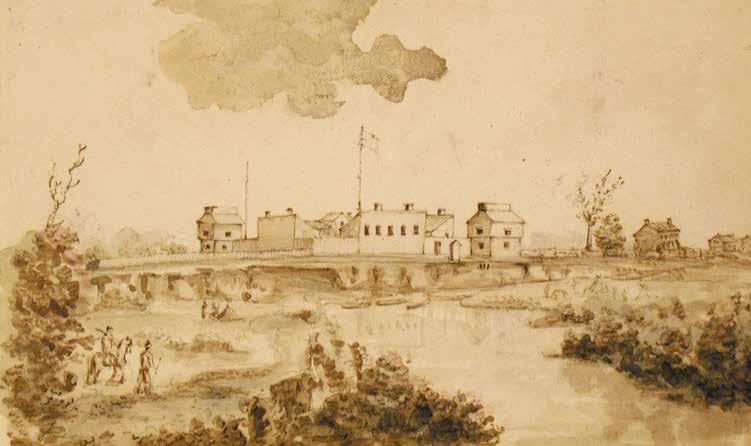
Fort Wayne, 1816, by Major Francis
Historic Fort Wayne civic interest was the Wabash-Erie Canal, which ran through East Central along the south bank of the Maumee River. After several years of discussion, politicking and arranging of finances, construction began in 1832.
The Original Plat only went as far east as Barr Street, but the second and third plats added to the east side of the new town and are now part of East Central. Fort Wayne welcomed its second plat, the County Addition (two blocks either side of Lafayette from Superior to Berry Street) in 1830 and Taber’s Addition (along the canal where Main, Berry, Clay and Monroe Streets dead-ended into it), in 1835.
In 1837, Samuel Hanna, an East Central resident who was a part of every important development in the town’s formative years and who made a considerable part of his fortune as a land speculator and developer, began platting and developing the east side on a large scale. In a series of plats, he laid out lots, alleys, and streets stretching from Calhoun Street south of the existing plats all the way east to Harmar Street, north up to the Maumee River, and as far south as Lewis Street. His own estate was where Hanna Homestead Park is today. He also platted land he owned south of Lewis Street and in other parts of Fort Wayne, but nowhere is his footprint as large as in East Central.
Kentucky-born Hanna, who arrived here from Ohio in 1819, is recognized for his work as a civic leader, elected official and circuit court judge, as well as an active entrepreneur who saw to it that land was developed and plank roads, then the canal and then the railroads were built to connect Fort Wayne with the world. He should also be remembered for the start he gave to the East Central neighborhood. He died in 1866, leaving his heirs to plat even more of the neighborhood and city.
Hanna singlehandedly platted more lots in his first plat than there were people in Fort Wayne at the time, and that was after the County and Taber additions had added 100 other lots. None of the plats were misguided, though. By 1840, when the town of Fort Wayne upped its official status to city, the population had exploded to 2,000. Houses were lining the new streets of East Central as far east as Harmar Street and as far south as Lewis Street, and businesses were in place conveniently close to the canal.
The canal was driving the early growth of the city and the neighborhood, attracting both residents and businesses. Hanna wasn’t the only person of civic renown to live in East Central in its early years. Thomas Tigar, editor of the city’s first newspaper,





lived on Berry between Clay and Canal streets. F. Perry Randall’s handsome mansion with its impressive gardens was at the northeast corner of Wayne and Lafayette streets. Randall came to Fort Wayne in 1838 and served multiple terms as mayor.
The story of longtime Madison Street resident Henry C. Niemeyer is a good example of how East Central grew. Born in Germany in 1816, he emigrated to the US in 1836 and joined other German immigrants to help build the canal when the section from Fort Wayne to Huntington was under construction. His 1904 obituary in the Fort Wayne Weekly JournalGazette notes that he saved his earnings and bought a farm in Adams Township. An 1860 plat map shows 40 acres in the township’s southwest corner owned by him. By 1878, though, those 40 acres belonged to the adjoining farm. Henry had moved into town.
His obituary says he spent time as a canal boat captain and became a teamster when the canal business faded and railroads took over. The first city directory is dated 1858, and the earliest city directory listing that includes him is 1860, when he is listed as a teamster living at 157 Madison Street, which is probably the house to the east of what is now 705 after the addressing of city properties was changed in 1902. He and his wife Caroline (they married in 1849) stayed on Madison Street through years of his work as a teamster, with occasional listings showing him working for local lime, stone, and cement yards or lumber yards along the canal. His address changed in 1872 to 153 Madison Street (now 705 after the addressing change in 1902), which is likely when he and Caroline built the Italianate brick 705 Madison Street and moved their growing family into it. According to the 1880 Census, they had four sons and two daughters, the youngest of whom was 6 in 1880.
Caroline died in 1901, followed by Henry in 1904, after which their youngest son Ernest raised his family in the home. Ernest, a salesman for the George DeWald Company, and his wife Louise were still listed as living there in the 1950 city directory, though by 1952 their son Ernest Jr. was listed as living with them. Ernest died in 1953. In 1954, Ernest Jr. and Louise were still on Madison Street, but the 1956 city directory has them moved out of the neighborhood onto Lake Avenue. The stately brick Italianate house at 705 Madison Street was in the Niemeyer family for more than 80 years. Several other brick Italianate homes very similar to 705 are
Written By: Connie Haas Zuber | Edited By: Logan York
in the few blocks nearby. Any one of them could have an equally compelling story.
The story of the early years of Fort Wayne’s free black community, centered in the Hanna’s First Addition area of East Central, shows how Indiana’s ban on slavery and then the federal Fugitive Slave Act affected where free black people chose to live. Black people had lived in the Fort Wayne area since colonial times, with connections to other free black settlements in other counties and states. By 1850, the number of black or multi-racial residents in Wayne Township had increased from 14 in 1840 to 81. An 1831 state law required “colored persons” to post a bond of $500 as a guarantee against becoming public charge and as a pledge of good behavior, but it was rarely enforced. The free blacks who came to Fort Wayne ranged from illiterate, hard-working farmers to skilled tradesmen who ran successful businesses and owned property and whose whole families were educated and literate.
Several of the families were active in the Fort Wayne free black community in the 1840s and 1850s, contributing to the formation of the Turner Chapel African Methodist Episcopal Church in 1849, the first of more than 100 black congregations formed here. The Turner Chapel Church has always been in East Central. But the 1850 Fugitive Slave Act and tensions that led to the Civil War were making a difference in Indiana, which saw an overall decline in its free black population through the Civil War. Allen County’s decline was among the most dramatic, with the population falling to 37 by 1870. Many of the families had moved on to more welcoming places. George Fisher lived out his life here, dying in 1884 as an “esteemed citizen,” according to a news story announcing his death in the October 23 Journal Gazette. He had moved to Fort Wayne in 1846 and attracted the notice of Judge Samuel Hanna, who appreciated his intellect and gave him a lot in East Central for his home and helped him establish his plastering business. Fisher’s obituary recounted his role in the establishment of Turner Chapel and praised his philanthropic work in the community.
The purchase of a large estate to establish Concordia College by St. Paul’s Evangelical Lutheran Church, founded in 1837 and soon located on Barr Street at the west end of Madison Street, may have accelerated East Central’s eastward development. The church bought “Woodlawn,” the country estate of Col. Marshall S. Wines in 1848. In
1860, Chute’s Homestead Addition was platted south of Maumee Road along Division, Walnut, Ohio and Elm streets. In 1863, Comparet’s Addition was platted from Harmar to University Street west of the university grounds north of Maumee Road. The College Addition was platted in 1864 north of Maumee Road along College and Walton (now Anthony) to Wayne Street.
East Central also claims a series of firsts and important founding for the City of Fort Wayne:
1848: City’s first telegraph line between Toledo and Evansville follows the canal route through town.
1848: St. Mary’s Catholic Church founded on Lafayette Street south of Jefferson Street.
1852: The city’s first railroad locomotive is unloaded from a canal boat at the north end of Lafayette and placed on tracks laid down Lafayette to deliver it to the railroad being built on the south edge of East Central. Those tracks were in place until 1857.
1853: The city’s first public school established on the east side of Lafayette between Main and Berry in the old McJunkin school building. A west-side school opened at the same time at Wayne and Ewing streets. The next school to open, Clay School at Clay and Washington, was in 1857.
1856: The Wabash Railway is completed through Fort Wayne — and East Central — to Lafayette.
1857: The beginnings of the famous Pennsylvania Railroad shops at Lafayette and the Pennsy tracks are dated to this year when the Fort Wayne firm of Jones, Bass & Co. sold its foundry and machine shops to the Pennsylvania Railroad.
1860: Maj. Samuel Lewis filed the first plat in Fort Wayne that has the north-south streets running true north and south instead at the angle of the original downtown streets, which were already established when the Original Plat was drawn. The Lewis Addition goes south from Lewis Street between Lafayette and Hanna to Lasselle Street.
1863: Old Fort Park, at the northwest corner of Clay Street and East Main Street becomes Fort Wayne’s first public park.
The Civil War dominated the nation, Indiana, and
Fort Wayne from April 1861 through April 1965, when the Union defeated the Confederacy. Fort Wayne entered the war years with many demonstrations of support for the Union cause, but the city and area had significant numbers of supporters for the Confederacy too, and the federal draft was very unpopular. However, the city’s transportation and manufacturing resources gave it a valued role in the war effort and brought money into the local economy.
Historians remember the Civil War as the turning point in Fort Wayne’s history from town, with the familiar “small town” hallmarks, to city, with the city-style bustle, hustle and more impersonal ways of getting things done. In East Central, those turning point changes matured the neighborhood from a place that was filling out with homes and related businesses to a magnet for commerce and industry. The neighborhood’s residential heart persisted and filled out, but along the railway lines on the north and south borders of East Central, large commercial and industrial concerns dominated the landscape. By the land-use logic of the day, the people who lived in the heart of the neighborhood then had an easy walk to work in any of the industries.
From the late 1860s until the 1910s, developers continued to file generally smaller plats for residential subdivisions, preparing the last available areas in East Central for building homes. The exception was the large Eliza Hanna Seniors Addition of 1873, which added 250 lots in an area bounded by Lewis Street on the north, both sides of Harmar and Ohio streets on the west and east, and a railroad track on the south. Neighborhood commercial development followed the plats all over the neighborhood, with grocery stores, bakeries, butcher shops, beauty salons, barber shops, churches, and public schools dotting the East Central streets. Harmar Elementary School opened at Harmar and East Jefferson in 1866. Maumee Road became a commercial strip, as did Lafayette Street. Hanna, Washington, Jefferson, Wayne and Lewis were the second tier of commercial streets, remaining mostly residential.
Four East Central properties protected as Local Historic Districts date from this period of neighborhood residential and commercial development.
Jesse and Ione White House, a gabled ell cottage built c. 1890 at 1223 Summit St. Protected for its





connection with the 20th Century life and work of the Rev. White, who was a significant local civil rights leader also known and respected more widely.
Bostick-Keim House, a Queen Anne home built 1888 at 429 E. Wayne St. Protected for its intact architecture and connection to Fort Wayne’s commercial history through builders John and Louisa Bostick. John had a successful business as a second-generation merchant tailor. After the Bosticks, the Keim family owned the house for more than 70 years.
Moellering Building, a Queen Anne/Neoclassical commercial warehouse built c. 1889 at 1301-1309 S. Lafayette St. Protected for how it embodies its architectural style and for how it represents the development of the city as an example of the Moellering Company’s brick and stone company’s expertise and quality products. It was built by Henry Wehrenberg’s company.
Doubleday Building, a Craftsman commercial building built 1916 at 437-441 E. Berry St. Protected for how it demonstrates the environment in an era of the city’s development characterized by builders’ and developers’ use of this architectural style. Its historical name is the Western Newspaper Union Building, and it is now known as the Hall Arts Center, owned by Arts United.
The dominant change, though, was the arrival of industries, which no longer were focused on the downtown canal landings. They were taking
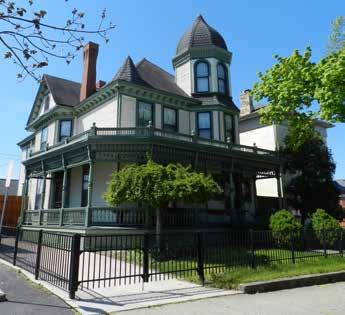
Bostick-Keim House City Historic Preservation Office
Written By: Connie Haas Zuber | Edited By: Logan York
advantage of the miles of railroad access on the north and south boundaries of East Central. The change did not happen overnight, but it did proceed steadily. The Sanborn Fire Insurance Company maps provide a good guide to the changes.
In 1885, the maps show four big industries present along the tracks on the north side of East Central stretching from Clay to Schick streets. They include a furniture factory, a box factory, a cooperage manufacturer and the City Carriage Works. The 1890 maps show five in roughly the same area: the cooperage manufacturer, one designated simply “manufacturing,” a heavy hardware warehouse, a pipe and supply company, and a bottling works.
By 1902, the industrial development has spread out to the east and south in East Central. The north area has added a washing machine manufacturer, a shirtwaist factory, a box factory, a woodworking company, a mattress factory, Wayne Oil Tank Company, a large greenhouse, and a cigar factory. To the east but still along the northern band of tracks, the maps show a mattress factory, a sawmill and box factory, a foundry, a handle company, and a leather and heel company in the still-industrial area near the Coombs Street bridge. Along the neighborhood’s south band of railroad tracks are a coal and wood yard, a warehouse, a novelty company, a plaster company, an ice cream factory, a wholesale grocery warehouse, and a contractor in addition to the Pennsylvania Railroad shops. A blacksmith and wagon shop is listed on Maumee Road along with the more traditionally neighborhood commercial shops.
In 1918, the north area has added a broom factory, and the Coombs Street area has added a warehouse and the Maumee Valley Coal Company. Wayne Oil Tank and Pump Company, the major local company that was founded downtown in East Central in 1887, has moved to a larger property also in East Central. To the east along the northern tracks, Henry Franke’s wood products company, a junkyard, an ice company, a lumber yard, and a sawmill had joined the existing businesses. Along the south tracks in 1918 were a grocery warehouse, the machine shop for the Bowser pump company, an oil company distribution facility, a lumberyard and planing facility, Fort Wayne Building Supply, W.K. Noble Machine Co., and the fully built-out Pennsylvania Railroad shops, stretching from Lafayette to Francis streets along the tracks, which had been elevated over Lafayette and Hanna
streets in a project co-funded by the Pennsylvania and Wabash railroads and city beginning in 1910.
Wayne Oil Tank, later and better known as Wayne Pump, was part of a trio of Fort Wayne companies that made this city a center of pump manufacturing for the nation. The others were Bowser Pump, located further south on Creighton Avenue, and
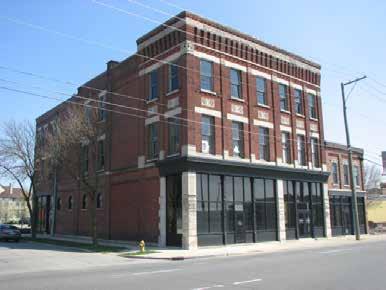
Moellering Building
City Historic Preservation Office
Tokheim, the last to be incorporated, located east of Anthony Boulevard near its intersection with New Haven Avenue. Wayne Pump’s engineers invented the machinery that measured and displayed the cost of the fuel pumped as well as the quantity, but the company found it needed to convince the marketplace that this was a useful function. It hired local agency Bonsib Advertising who coined the catchphrase “Fill ’er up!” and developed a marketing plan that worked. The new pump was a success.
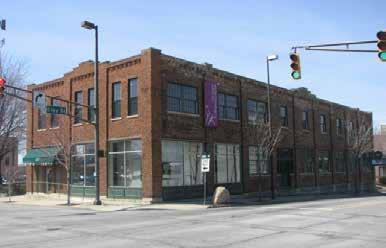
Doubleday Building
City Historic Preservation Office
The option to walk to work was both necessary and welcome at this time, even once two different trolley bus lines ran east-west through East Central on Main Street, Washington Boulevard and Lewis Street beginning in the 1870s. But not all industry is welcome as a neighbor. It was the noise, smoke, and dirtiness of industry that triggered the development of Fort Wayne’s first suburbs, northeast in Lakeside and south in Williams Woodland and South Wayne, after the Civil War and into the Gilded Age. The people who kept on living in the city neighborhoods had to deal not only with furniture and pump manufacturers but also foundries and, worst of all, stockyards, meat packers, and fertilizer plants. East Central had some of each. Stockyards were along both the north and south railroad lines. In 1922, East Central residents undoubtedly sided with their East Side neighbors further east and helped pack a City Council public hearing fighting the establishment of yet another stockyard on Roy Street. In 1906, East Central citizens were pressuring the city to close the Bash Fertilizer plant, part of the Bash Packing Co. facility just north of the Nickel Plate tracks at the north end of Hanover Street. The company had already been fined for creating a nuisance several times, according to newspaper reports, so the council formed a special committee of two council members, the mayor, and a board of health representative to go check for themselves.
“The stench drove us away,” one of the councilmen reported. The property is marked as “Vacant except for storage” 12 years later on the 1918 Sanborn map.
East Central underwent other changes after the Civil War also.
The changing number of stables indicates the neighborhood’s growth and then a different kind of neighborhood being built. Sanborn maps indicate stables on lots, so stables can be counted. In 1890, East Central had 312 stables, nearly all of them behind residences. The neighborhood had grown by 1902 and had 387 stables — and a livery. But in 1918 the number of stables had fallen to 212 as many former stables had become either garages for cars or residences along alleys. By 1918, new neighborhoods were not being built with stables.
The neighborhood’s black population also began to rebound as hard times in the South and the hope for manufacturing jobs in a city pushed black Southerners north. In the South, 80 percent of black people were sharecropper farmers. The economic depressions of the 1870s and 1890s forced tens of





thousands of farmers off the land, followed by years of crop failures in the 1910s. The South’s Jim Crow laws institutionalized discrimination, and the active Ku Klux Klan terrorized black people, with black men lynched in the South an average of two per week from 1880 to 1910. In addition, laborers were needed in the North, where black workers were used to break strikes and to meet the needs of World War I production. Fort Wayne’s black population doubled from 1900 to 1910, reaching 572, which was still less than 1 percent of the city’s total population.
The earliest arrivals found Fort Wayne offered an imperfect but real freedom to live wherever they could afford to and to take whatever job they could find, according to local people interviewed.
One of those black citizens was William Warfield, widely recognized as the city’s leading black citizen, a man born in Kentucky who had arrived in Fort Wayne at age 20 in 1890. He had attended a seminary in Washington, D.C., and was certified to teach, but that was not what he wanted to do. He
worked as a waiter in a hotel restaurant for a while, married Anna Underwood in 1898, and spent most of his life self-employed, working odd jobs and as a janitor and investing in and managing property. In April 1909 he and Anna and their two children moved into a 21-room house at 450 E. Douglas Ave., which became their home and a rooming house. It was a top-quality facility, catering to local people, touring performers and dining car staff for the Pennsylvania Railroad, with which he had a
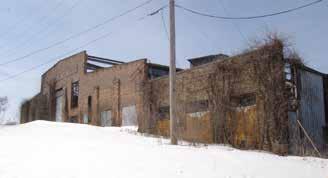
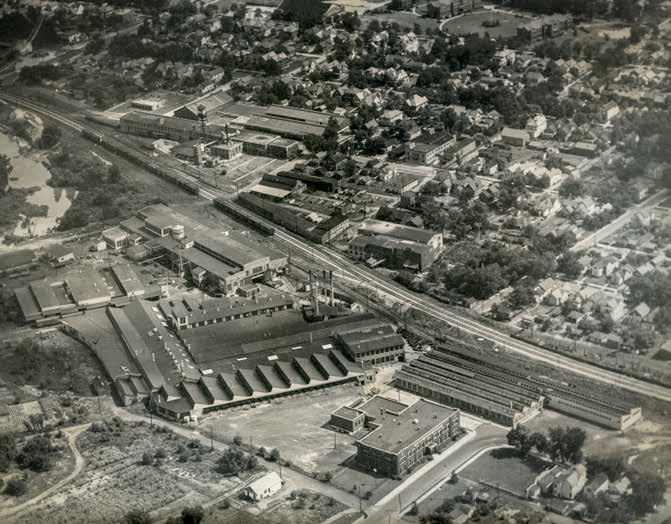
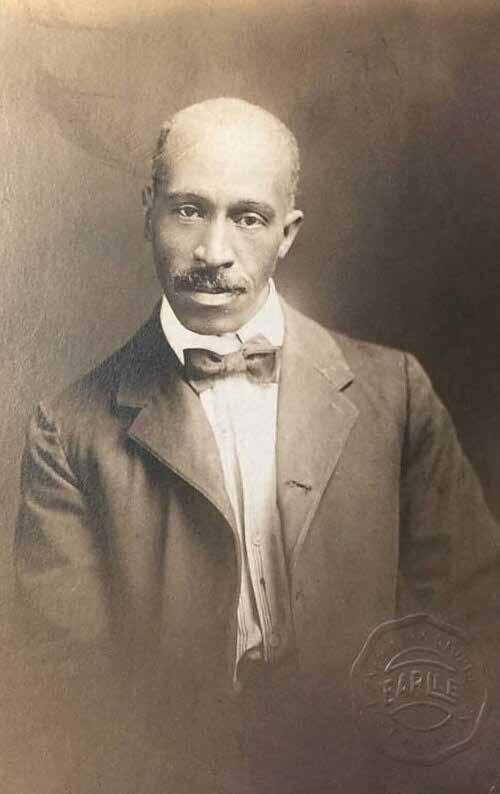
William Warfield
Allen County Public Library
contract. He also had properties on Brackenridge and Calhoun streets and a farm on Bass Road, among other properties. He was a voracious reader, writer, poet, and composer. He wrote the song, “We Love Old Fort Wayne,” which played from the Lincoln Tower Bank building when it opened in 1930. He published Fort Wayne’s first black newspaper, The Vindicator. He also kept daily diaries from 1909 until his death in 1936. These priceless records of his life are filled with his commentary and records of what was happening every day. They are in the collection of Fort Wayne’s African/African American Historical Society Museum. Some have been digitized and are available on the Allen County Public Library website.
World War I was the beginning of a cascade of events that changed the world and left East Central with very different resources and prospects. East Central’s growth up until the 20th Century was largely based on what Fort Wayne people were doing in and for Fort Wayne, which included welcoming a lot of immigrants and founding a lot of businesses and industries. In the 20th Century, events and social forces elsewhere in the nation and the world had direct impacts on Fort Wayne and East Central.
In the first two decades of the new century, East Central maintained its status as a respectable neighborhood of better, though not fancy, housing. It had the full range of neighborhood amenities: shops and personal services of all kinds, streetcars, hospitals, churches, schools, Hayden Park and near access to the Barr Street Market. But glimmers of change were appearing. As earlier German immigrants raised their standard of living, they usually moved east toward the fringes of the city. Their departures left room for newer immigrants, who at this time were from Southern and Eastern Europe, Italians and Greeks. At the same time, the exodus of black people from the American South continued, who increasingly clustered around the Turner Chapel AME Church at Francis and Wayne Streets, leaving The Flats at the north end of Calhoun Street where many had first settled in the 1910s.
World War I was a faraway concern during the years of American neutrality beginning in 1914, but it became an active concern when the U.S. declared war on Germany in 1917. East Central, of course, contributed soldiers to the cause and saw its workers’ jobs change to production for the war. Harmar School was one of the three city sites where young men selected in the 1917 draft lottery were called to report for examination and mustering in. The Pennsylvania Railroad shops were an important wartime manufacturing plant. White, but not black, women were brought in as workers because of a shortage of men. Germanborn, unnaturalized residents who had to register as “alien enemies” had to receive a special permit to be close to the shops (or the Bowser plant or the Bass Foundry) or to work in any of them. The Pennsylvania shops were the site of the first group migration of Southern blacks to Fort Wayne in 1917 when workers went on strike, despite the wartime





production status. The railroad recruited black workers to replace them, housing them on site for the duration of the strike. The black workers lost their jobs when the strike was resolved, but many of them chose to stay in Fort Wayne and likely East Central.
That group migration was one part of The Great Migration of the early 20th Century. which continued to accelerate. By 1920, Fort Wayne’s black population had more than doubled again to 1,454.
After the war, during the Roaring Twenties, Fort Wayne boomed. Building, industry, home ownership, and the savings rate for individuals all skyrocketed. Two of the East Central properties designated as Local Historical Districts were built in the 1920s.

Turner Chapel AME Church
City Historic Preservation Office
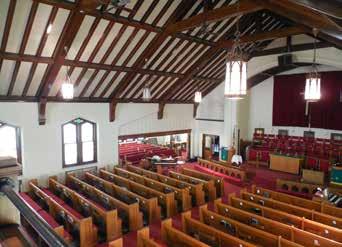
Turner Chapel AME Church
City Historic Preservation Office
Written By: Connie Haas Zuber | Edited By: Logan York
Macbeth House and Office, a Craftsman bungalow built c. 1924 at 419 E. Wayne. Protected for its connection to the history of an early female physician, Dr. Bertha Macbeth, who worked out of a home office on the east side of the bungalow. Also protected for the integrity of its architecture as an excellent example of the Craftsman bungalow type and one of the few examples of a home-office in town.
Calvary United Brethren Church/Turner Chapel AME Church, a Gothic Revival church built in 1927 at 836 E. Jefferson. Protected for its architectural integrity as an excellent example of a Gothic Revival church as it was constructed for its original users the Calvary United Brethren congregation. Also protected for its association with significant events in local history including the establishment of the African Methodist Episcopal church and its role in the work for civil rights for its time as the home of Turner Chapel AME Church. Turner Chapel, at an earlier location also in East Central, was the first black church established in Fort Wayne in 1849 and moved into this building in 1965. Turner Chapel was one of the city’s Freedom Schools during the 1969 boycott of the city’s segregated public schools.
Black folks living in Fort Wayne shared the Roaring Twenties’ prosperity to a degree, certainly in comparison to life in the Deep South, which was dealing with the collapse of its agricultural economy and maintained its discriminatory Jim Crow laws while failing to curb the abuses of the Ku Klux Klan. In Fort Wayne, blacks were at least able to find seasonal jobs in construction, and black men, but not women, could get some jobs in manufacturing. However, barriers to employment and difficulties finding housing were going up. In the 1920s deeds attached to new homes began to have restrictive covenants forbidding sales to blacks, though few if any new homes were being built in East Central, and many landlords were refusing to rent to black people.
The job market had severe restrictions, too. Less than two percent of the workforce at the 10 largest manufacturing plants was black. The list of other employers willing to hire blacks was small, though it did include Western Newspaper Union, in East Central. However, the jobs available to black people were the most entry-level and lowest paying.
After World War I, black people living in Fort Wayne were increasingly concentrated in East Central, though working-class white families including
white migrants from rural areas and European immigrants also moved in. However, as white families assimilated to Fort Wayne and improved their standard of living, they could move to other neighborhoods if they chose. Black people were far more restricted on any opportunity to move out of East Central. In 1920, 48 percent of the city’s black population lived in the neighborhood. In 1930, the percentage of the city’s black residents in East Central had grown to 56, and in 1940, it was 63. As a percentage of the neighborhood population, though, it was still small: 3 percent in 1920 and 4.5 percent in 1940. Beginning in the 1920s, the two blocks of Lafayette Street from Lewis to Brackenridge streets became a downtownesque commercial space for the black community, which was shut out of the regular city downtown by segregation. As many as 30 businesses lined the street, including an upscale night club, restaurants and taverns, fraternal organization clubrooms, barber and beauty shops, a rooming house and hotel, a doctor’s office, and a record shop. During World War II, a portion of the Moellering Building, 1301 Lafayette, served as the Black Servicemen’s USO Club because they were not welcome in the white servicemen’s club on Harrison Street downtown. The Avenue flourished for more than 40 years, until being erased by the forces of redevelopment and integration.
As the East End industries continued to grow, East Central was becoming a residential area for working class people of both races and all ethnic backgrounds in its area from Maumee Avenue to as far south as Pontiac Street. Among the other neighborhood changes of the years between the two world wars, Fort Wayne’s red light district moved to East Central, settling in along Hayden Street. White flight was beginning.
In 1928, clusters of black residents in East Central were identified from Lewis Street south to the Pennsylvania railroad between Clinton and Hanna streets, along Eliza and Hayden streets from Francis to Winter streets, along Erie (now Berry) Street and Washington Boulevard between Hanna and King streets and from Liberty Street to Washington Boulevard between Canal and Hanover streets.
The Great Depression of the 1930s then added burdens to the entire nation and city with some specific challenges for East Central. The federal government’s effort to help banks and other lending institutions recover and begin mortgage
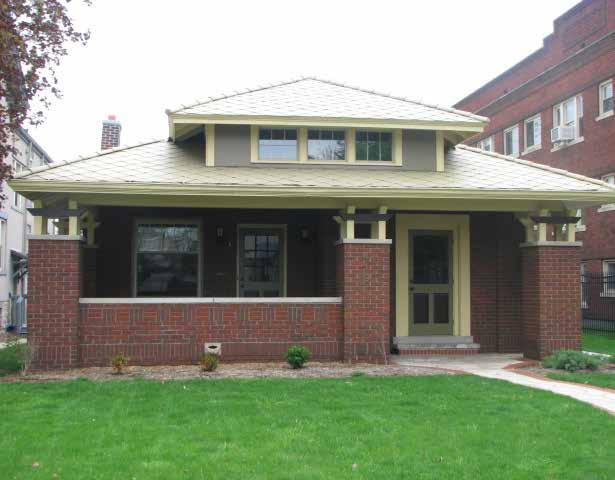
lending again with some promise of success is how redlining maps were created in 1933. They were based on analysis of each of the cities they covered and ranked areas by risk of lending from Best through Still Desirable to Definitely Declining and Hazardous. Neighborhoods with black residents were automatically marked Hazardous. East Central south of Lewis Street (except for east of about Winter Street) was Hazardous, and the rest was Definitely Declining except for a few blocks north of Hayden Park, which were Hazardous. In 1934, the Federal Housing Administration (FHA) began insuring home mortgages, but only in allwhite neighborhoods. In 1938, Congress created the Federal National Mortgage Association (Fannie Mae) to increase the availability of low-cost mortgages, but guidelines severely limited their availability to black homebuyers. None of these three federal programs helped neighborhoods like East Central.
East Central residents were determined to do what they could in the face of federal discrimination. A small group formed the first Eastside Neighborhood Association in 1936 to encourage black residents to take an interest in the neighborhood, promote home ownership, and make the neighborhood more acceptable to whites. After some cleanup projects and other programs, the association disbanded about two years later. The community’s churches were playing a major leadership role by the 1940s, with seven of the city’s largest black





churches in East Central. The larger black churches had well trained pastors who were active in civic life. Pastors of smaller congregations, of which East Central had several, were likely to have less training and to need other full-time jobs to support themselves.
A new community-based project made a significant difference for the neighborhood beginning in 1920. A group of concerned local black residents formed the Fort Wayne Community Association that year and decided to open a community center to pursue their mission of supporting and bettering the lives of the city’s fast-growing black population in a non-partisan and non-sectarian way. The Phyllis Wheatley Social Center was founded on Wallace Street but moved soon to East Central on East Douglas Street, settling in at 436-438 E. Douglas. Through the 1930s and into the 1940s, the center functioned as the center of the black neighborhood community with social, recreational, educational, and vocational programs for youth and adults. During the Depression it was a critical support for black families in the area. As the Center navigated the work of serving its community, it soon affiliated with the national Urban League and increasingly dealt with employment, housing, education, and social concerns.
Elma Alsup, who grew up and lived during her adult life on Brackenridge Street within a block of the Center, trained as a social worker and began working there soon after it opened. She devoted more than 25 years to the center and its program participants. She worked with youth and adults with social groups and educational and recreational programs, establishing clubs that lasted into the 2000s.
World War II, which the U.S. entered in December 1941, turned attention from the ongoing catastrophe of the Depression to the crisis of war. On the home front, East Central dealt with wartime employment amidst discrimination. Practically every plant in Fort Wayne switched over to the production of war materiel. Wayne Pump in East Central built bombs and related items. The Great Migration continued. Fort Wayne was growing fast, and 20 percent of its growth was black migrants. Its black population doubled during the war. In 1950, black people were 4 percent of the city’s new, larger population. Because the labor shortage was so severe, black men could get industrial jobs during the war, but they rarely got upper-level jobs. A 1944 study found
Written By: Connie Haas Zuber | Edited By: Logan York
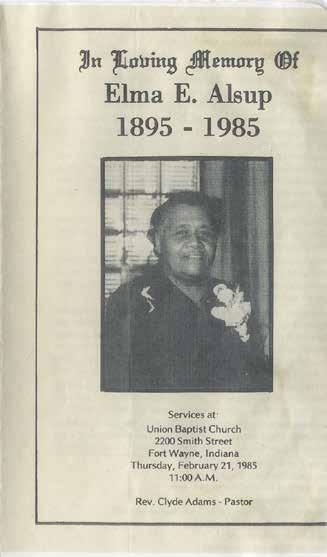
that 44 percent of Fort Wayne’s black employees were engaged in war production. Black community leaders, including the Wheatley Center staff, worked to get more local industries to hire black workers and to promote black workers to upper-level jobs, which was helped by the 1941 Fair Employment Act. Beyond the tragedies of lives disrupted and lost during military service, the wartime economy helped black families in Fort Wayne, which means it helped East Central.
After World War II, America and Fort Wayne fought for a new postwar footing and then accelerated into a future that paid very little attention to urban core neighborhoods like East Central. East Central’s residents still lived their lives, pursued their jobs and careers, and raised their families as they
always had, but the tides of the times were flowing out in the suburbs, not in the city’s oldest, most central neighborhoods. Government attention was focused on suburban development and interstate highway construction. Families whose standards of living were improving with the postwar economic boom decided they wanted larger, newer homes on bigger lots and moved further away from the old downtown neighborhoods. And white flight continued as black families continued to migrate north from the South and were steered into East Central by landlords and real estate agents who also steered white sellers and buyers out.
The most sympathetic attention paid to the needs of East Central continued to come from its churches, whose pastors were leaders in local civil rights work, and community agencies like the Phyllis Wheatley Center, which handed off its recreational and social youth programs to the Fort Wayne Parks Department’s McCulloch Center (also in East Central) in 1946 and became the Fort Wayne
Urban League, focusing entirely on the social, economic, educational, and political issues that were determining the fate of Fort Wayne’s and East Central’s black residents. Government attention at the time tended to have words like “blight,” “economic development,” and “redevelopment” attached to it. Inspired — and frustrated — by the gap between what the government considered doing and the neighborhood needs they experienced, East Central residents stepped up into advocacy and leadership roles as never before. And they kept stepping up over years of working with different city administrations, different federal programs and different non-profits wanting to help the neighborhood with their programs and needing neighborhood support to get funding.
In these circumstances, more East Central residents faced poverty, more lived in dilapidated and overcrowded housing, and more were black. Unscrupulous absentee landlords raised rents, and banks following redlining maps refused loans
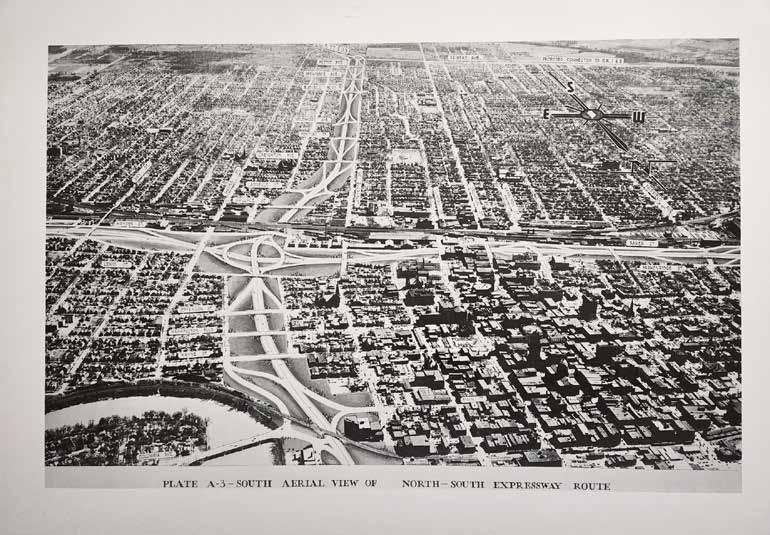





to potential homebuyers and to homeowners wanting to improve their properties. Services and institutions left — churches, a hospital, schools. The number of neighborhood general merchandise stores peaked in 1950 and fell by a third by 1970 and by two thirds by 1981. Retail service stores like restaurants and barber and beauty shops also peaked in 1950 and dropped steadily thereafter. The number of neighborhood grocery stores had peaked in 1920, dropping by half by 1960 and by 60 percent by 1980. The number of practicing physicians peaked in 1940, and by 2005 only two were left in the neighborhood. By 1960, black people were half of East Central’s population, equal to 45 percent of the city’s black population. Between 1970 and 2000, East Central lost more than half of its population, dropping from 7,752 to 3,441 residents. Between 1984 and 2004 more than 500 structures were demolished.
The postwar period kicked off with a shock in 1946 when the city government proposed the Anthony Wayne Parkway project that would have put a multi-lane highway north-south through East Central in place of Francis and Monroe Streets and east-west along Brackenridge Street. After intense community discussion, including criticism of demolishing so many homes during a housing shortage and awkward questions about where the displaced black residents would move, the proposal was rejected in a November 1947 referendum vote. Similar freeway plans threatened the neighborhood and were defeated three more times, in the early and mid-1960s and again in the 1970s.
The 1950s saw three major traffic projects. The “Berry Street Blockade” was eliminated by taking 40 acres between where Berry Street then ended at Monroe Street and building a curving connection to Erie Street, which then ended at Francis Street. Erie Street was renamed Berry Street. Washington Boulevard and Jefferson Boulevard/Maumee Avenue were made into high-volume, one-way thoroughfares from downtown to the U.S. 30 Bypass, losing a large part of Hayden Park in the process of improving the connection of Jefferson Boulevard and Maumee Avenue. Lafayette Street was redone into a similar high-volume, one-way thoroughfare on East Central’s west side. These thoroughfare projects created barriers between sections of the neighborhood and made the streets less desirable for residences.
In the 1960s, redevelopment projects changed the cut-off northern parts of East Central, but the rest of the neighborhood was passed over for other redevelopment work, which was directed to neighborhoods further south on the logic that it was better not to risk a project in the worstcase neighborhood and wiser to strengthen the surrounding areas. On East Central’s northern edge, though, industrial land that had once been along the canal was cleared for construction of the Three Rivers Apartments that opened in 1965.
“The racial issue in Fort Wayne was openly discussed. A local attorney named Henry Hasley purchased a series of radio broadcasts prior to the referendum and during the mayoral election of 1947. Every night following the popular Amos & Andy show, Hasley’s message was designed to raise fears about racial mixing by pointing out that the expressways would go through the central city and that many families from that area would soon be moving into their neighborhood. Then what would happen Hasley would ask his listeners, to the value of your property.” (Clark p. 647)
The eastern edge of the Main Street Project, which cleared commercial blocks to build the CityCounty Building, Freimann Square, the Performing Arts Center (now Arts United Center), and Fire Station No. 1, touched the East Central boundary.
The challenges for East Central in the 1960s were rooted in segregation, discrimination, and housing deterioration. The neighborhood was burdened with the effects of having absentee landlords, too little code enforcement, a lack of political clout, and a high crime rate and burden of vice. In response, residents banded together in 1964 and formed the East Central Neighborhood Association.
Neighborhood cleanups and fund-raisers went well, and soon enough the association was working with the city toward housing rehabilitation investment and fielding interest from community groups that wanted to help. The East Wayne Street Center opened in 1965 as a neighborhood service center after its sponsoring group, Crescent Avenue EUB Church, determined the neighborhood association would be interested and supportive. The Center would open the city’s first Head Start program, in addition to its other educational and support programs. East Central Improvement Inc. had been working on housing rehabilitation, but in 1973 it was replaced by Lincoln Life Improved Housing, another outside group that the neighborhood
association was responsible to monitor and work with while gladly supporting its mission. The association was also working with the City of Fort Wayne, particularly its community planning and redevelopment departments, in hopes of receiving federal grants for neighborhood improvement and redevelopment projects. However, years of effort were frustrated by changes in federal programs and funding and in local mayoral administrations. Progress was very slow, information was difficult to get, and the relationship between the neighborhood volunteers and public officials was strained. Relationships among neighbors were
In the 1960s and early 1970s, Fort Wayne schools experienced deep racial imbalances, with Hanna, Harmar, and McCulloch Elementary schools having over 90% Black enrollment. A 1969 boycott by Black families led to the creation of Freedom Schools in churches, which brought national attention and forced a compromise with Fort Wayne Community Schools. Tensions remained high into the 1970s, culminating in student clashes at Northrop High School in 1973 that temporarily closed the school.
strained, too, and the struggles were the topics of many newspaper articles. Finally, by 1974 the neighborhood was seeing some progress with appraisals moving forward for the project that had finally been approved and funded, and necessary demolitions were underway. Lincoln Life Improved Housing had rehabbed 15 homes that now had low-income people living in them, and it was working on 15 more. The city had contracts signed for $100,000 of curb, sidewalk, and alley work in the neighborhood.
It was progress, but it had been very hard-won. The neighborhood association lost some leaders and many members and spent the next few years weakened but still working. Racial tensions, which the association had attempted to temper with its commitment to being non-sectarian and non-partisan, had flared and complicated the neighborhood’s relationship with the city and the residents’ relationships with each other. East Central was a stage for some of Fort Wayne’s most dramatic civil rights events of the late 1960s and 1970s. In 1969, Turner Chapel AME Church was one of

Fire Station 1
Univ. of North Texas, Fire Museum of Texas





the Freedom Schools organized by the Fort Wayne Urban League and Fort Wayne Ministerial Alliance which educated 1,300 students withdrawn for 10 days from Hanna, Harmar, McCulloch, and Smart elementary schools to protest segregation in city schools. Disorder broke out in the neighborhood after the death of Dr. Martin Luther King Jr. in 1968, and in the summer of 1970, several buildings were set on fire and a number of storefront windows on Lewis Street were broken out.
A combination of factors around the 1975 federal legislation that created the Community Development Block Grant program gave the association and the neighborhood new energy. The contributing factors included an overall lessening of racial tension and the association’s success in addressing residents’ dislike of one part of how Lincoln Life Improved Housing was working in East Central. The association worked with the LLIH group to adjust its process, and the conflict was ended by giving the resident the ability to choose whether to initiate participation rather than being solicited to participate.
The availability of Community Development Block Grants and the difference between how they involved neighborhood representation compared to the earlier Neighborhood Development Program, which had proved deeply unsatisfying, was invigorating to the city and the neighborhood. East Central was excited that the program could fund code enforcement efforts as well as housing rehabilitation, but it almost lost the opportunity when the Lebamoff administration went first to the citizen group working with Lincoln Life Improved Housing for support rather than the neighborhood association. Once that confusion was corrected, work began to identify a project and seek funding. The Summit Street project finally happened in 1976 bringing ornamental streetlights, new sidewalks, and street resurfacing and parking pads off the alley to accommodate no parking on the street. East Central Park opened at Coombs and Cochrane streets with basketball and tennis courts and picnic and play equipment in 1978. In 1980, East Central Towers opened on land that had been cleared but not developed in the 1970s as a Neighborhood Development Program project that was never completed.
Through the rest of the 20th century and into the new century, the ebb and flow of neighborhood association involvement, resident leadership
and the varying interest and resources of city government, business and community groups continued. In the 1970s, the association led a successful fight to prevent the location of a new correctional facility in East Central. In 1979, the neighborhood lost its fight to save Harmar School, which had been closed in 1977, from demolition. Hanna School was also closed in 1977, followed by the closing of McCulloch School in 1982, the last of the neighborhood schools. Recessions in the 1980s caused General Electric to close its Winter Street plant. In 1991, Arts United opened the Hall Arts Center at Clay and Berry in the former Western Newspaper Union building, housing Artlink, the Fort Wayne Dance Collective, and ARCH. Also in 1991, Foellinger Foundation opened its new home diagonally across that intersection. In 1998, the African/African American Historical Society was founded by a small group of concerned people, moving into its permanent home at 436 E. Douglas Avenue the next year and beginning work to open as a museum. Between 1997 and 2002, the East Central Housing Corporation, an outgrowth of the East Wayne Street Center, worked with the Fort Wayne Neighborhood Housing Partnership to build 18 new houses carefully designed to harmonize with the neighborhood’s existing home styles on Liberty Street and nearby blocks. Beginning in the 1990s and into the 2000s, Fort Wayne had increasing immigration from Southeast Asian and African countries, increasing its diversity. East Central shared in that increase when a mosque opened on Chute Street. In 2002, some East Central residents participated in a research visit to Boston to meet residents of the famous Dudley Street restoration project. From 2003 to 2005, East Central residents worked with Fort Wayne Community Development and Planning staff to craft a neighborhood plan, that was adopted in 2005. Now they are working on the next-generation East Central Forward plan.
Throughout the struggles and victories, large and small, East Central has remained a neighborhood where people carry on living, working, and raising families. For all the problems, its residents have organized to address as they seek solutions, it has been home to success stories, many of them commemorated in the Marsha Smiley Collection, housed online in The Genealogy Center’s portion of the Allen County Public Library website. Of the many worthy examples of people who grew up in, lived in or passed through East Central as part of full, successful lives, enjoy these great examples:
Roosevelt Barnes Sr., moved to Fort Wayne from Alabama in 1943, established a home and family on Madison Street in East Central and built a home building business dedicated to enabling black families to own their own modern, upscale homes. His family lived in East Central until he built a new home for them in 1965 in Southern Heights, the neighborhood he fought to develop in southern Fort Wayne.
Al Stiles, a Florida native who moved to Fort Wayne in 1971 to raise a family after a career as a touring dancer, singer, and songwriter. He lived on Summit Street in East Central, serving Fort Wayne as founder of The Talent Factory, a labor union leader, and entrepreneur of his shoeshine business. He also served on the East Central planning committee.
Bonnie J. Andrews, who moved from the west side of town to East Central in 1965, is one of the white East Central residents who immediately joined the neighborhood association and stayed active. A McCulloch Street resident, she was the longtime secretary and was president in 2001 when she led what she described as a polite walkout of a meeting with Mayor Graham Richard about a Redevelopment Commission proposal to designate a large swath of the neighborhood as blighted. In the end, the designation was not made.
Harold and Hana Stith, Harold Stith, a Virginia native who began a successful professional boxing career as a lightweight while in the Army, saw his career ended with an injury and moved with his wife Hana, a Fort Wayne native, back to her hometown, where he became the city’s first black plumbing contractor and a leading supporter of youth community programs and sports, including boxing. Hana finished her college education at St. Francis College and became a teacher in 1960, one of the first black people hired by Fort Wayne Community Schools. She taught for more than 30 years. She was also active in community and civic work. She was a founder of the African/African American Historical Society and opened its museum in 2000, becoming the society’s president and curator of the museum. She served 12 years on the city Redevelopment Commission, in addition to terms on the Metropolitan Human Relations Commission, and the Fort Wayne Board of Safety. The Stiths lived on East Douglas Street in East Central before having Roosevelt Barnes Sr. built them a new home in Southern Heights.
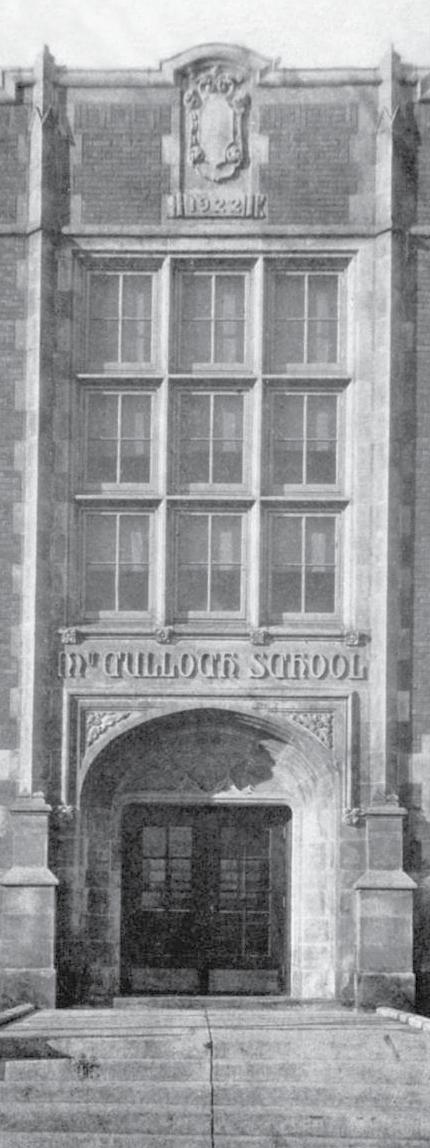

Since change is inevitable, we must direct change rather than simply continue to go through it.
Reppard Horne - Executive Director East Wayne Street Center (quote from Gill Scott-Heron)





The 1975 East Central Sketch Plan, developed under Mayor Ivan Lebamoff, represented a pivotal shift in planning for the East Central neighborhood and the City of Fort Wayne, as neighborhood-specific plans were rare then. Rather than focusing solely on land use and zoning, the Plan addressed systematic issues such as racial segregation, poverty, housing abandonment, and economic disinvestment. It emphasized the need for housing rehabilitation, community development initiatives, and strengthening the East Central neighborhood association to build long-term resilience for residents.
The Plan’s emphasis on grassroots engagement and physical revitalization laid the necessary groundwork for future efforts. One significant outcome was the Summit Street project, which brought new streetlights, sidewalks, parking pads, and street resurfacing to a portion of the neighborhood.
Highway planning efforts from the 1940s through the 1970s significantly impacted the East Central neighborhood. The 1946 Highway Plan for Fort Wayne proposed the development of the Anthony Wayne Expressway, an expansive highway
intended to modernize regional transportation, but at the cost of disrupting established neighborhoods across the city. In 1947, Fort Wayne voters decisively rejected the proposed highway that would have cut through East Central and displaced nearly 1,500 structures and a significant number of Fort Wayne’s Black residents. Several attempts were made in the 1950s and 60s to reconsider the construction of a highway in the neighborhood. However, all attempts would fail. Later transportation investments along Jefferson, Washington, Maumee, and Anthony would reinforce physical divisions in the neighborhood.
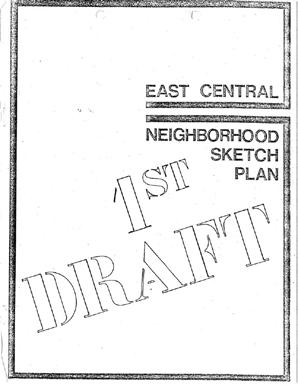
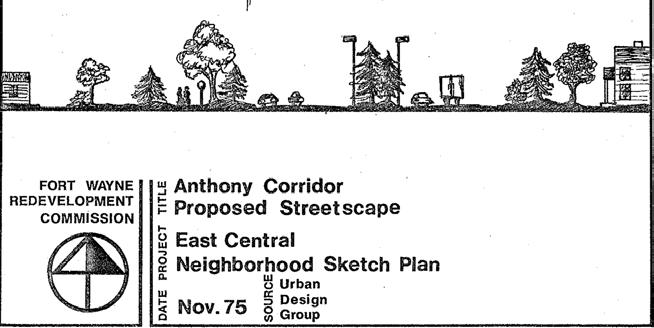
Subsequent studies – the 1973 East-West Highway Feasibility Study and the 1976 Anthony Boulevard Feasibility Study – proposed upgrades threatening East Central’s stability. While these plans acknowledged the risk of displacement and the loss of historic structures, they often framed them as necessary trade-offs for improved traffic flow. Over time, East Central endured lasting impacts of these plans, such as fragmented community connections, increased traffic volumes, and housing abandonment due to highway construction speculation.
The 1976 City of Fort Wayne Cultural Resource Plan provided a detailed and candid assessment of conditions within the East Central neighborhood. At the time, East Central was described as “perhaps not the happiest sector” of the city. According to the study, a primary source of disruption was the conversion of former minor residential streets into major one-way corridors carrying significant traffic volumes into downtown Fort Wayne without considering how it divided the neighborhood schools, businesses, and residents, creating both physical and social fragmentation. In addition to transportation-related issues, the Plan identified widespread deterioration and vacancy as critical concerns, as entire blocks had been cleared through urban renewal efforts, yet much of the resulting vacant land remained undeveloped, creating a sense of abandonment.
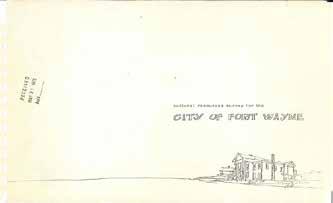
Despite the challenges, the Cultural Resource Plan recognized East Central’s historical and architectural significance. However, the Plan concluded that clearance, blight, and disinvestment had destroyed much of the area’s original context, making it difficult to designate the area as a cohesive historic district, unlike nearby West Central Neighborhood.
The 1980 Plan for the East Central Neighborhood was a significant step forward in providing clear policy direction for addressing decades of disinvestment, population loss, and housing deterioration. Built on a significant existing conditions analysis, the Plan outlined strategic objectives across four primary areas: housing, infrastructure, economic development, and recreation. It acknowledged substantial challenges such as poverty, crime, and deteriorating housing stock. For example, by 1980, close to 12% of East Central’s land was classified as vacant – the highest percentage of any neighborhood in Fort Wayne. Yet, the Plan did recognize that even through adversity, East Central had numerous strengths, including its central location near downtown, historic architecture, and a strong sense of community pride.

The planning process engaged residents with City staff. It developed a series of actionable strategies, primarily focused on zoning and infrastructure. The Plan prioritized stabilizing additional housing units with targeted programs. It emphasized economic development, pointing to reclaiming vacant land for future construction projects.
There was also a brief mention of strengthening recreational spaces like the Jennings Center





and Hanna Homestead Park. Ultimately, the 1980 Plan provided East Central with a clear, organized framework for renewal, balancing acknowledgement of the neighborhood’s existing conditions with a focused, policy-driven strategic plan for the future.
The East Central Neighborhood: A Celebration of Community is a study completed in 1982 by Drs. Pete Iadicola and Patrick Ashton of the Indiana University—Purdue University Fort Wayne Department of Sociology. It provides a deep and reflective account of East Central’s history and changing environment. While it is not a planning document, the study’s content is crucial in understanding the neighborhood’s change over time.
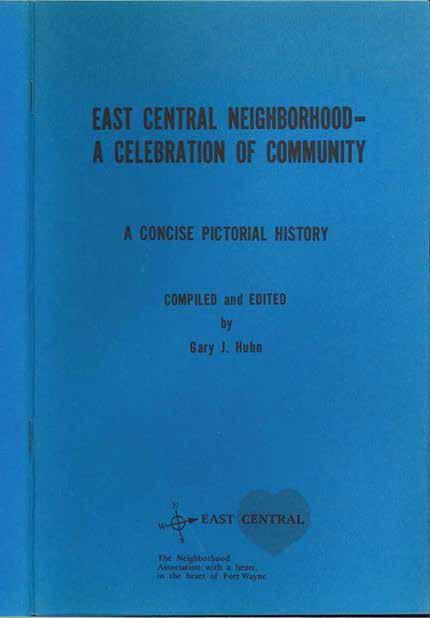
The study begins with a brief description of East Central’s beginnings. It discusses in-depth how the neighborhood was shaped by the migration of Black families to Fort Wayne. Over time, East Central developed a strong and unique community life anchored by local institutions, churches, schools, and small businesses. The area faced significant challenges, including redlining, discriminatory housing practices, and urban renewal efforts. Still, despite the hardships, residents in East Central
organized to form the East Central Neighborhood Association in 1964, leading to action around housing, crime, and accountability. The study was further documented in a photo celebration that is still readily available, which honors the “enduring heart” of the neighborhood.
The East Wayne Street Center plan for the East Central neighborhood outlined a comprehensive and community-driven strategy to address decades of disinvestment, deteriorating housing, and public safety concerns. Through neighborhood meetings and retreats, residents collaborated to identify key priorities. They formed task forces focused on infrastructure, housing, parks and recreation, and safety. The Plan emphasized the need for improved street lighting, alley cleanups, and upgraded sidewalks, particularly in areas where poor infrastructure contributed to safety concerns and declining property values. Parks and public spaces were also prioritized, with proposals for new recreational facilities and increased community-based policing to address crime and improve quality of life.
Housing revitalization was a cornerstone of the Plan. It called for a revolving loan fund, targeted housing rehabilitation, infill construction, and the creation of a local housing development corporation to spearhead these efforts. The Plan also proposed demonstration housing projects to establish market confidence and encourage homeownership. Throughout the process, a strong emphasis was placed on restoring community control, fostering partnerships between residents, local institutions, and City agencies, and reinforcing the identity of East Central as a viable, vibrant neighborhood. While the Plan laid the groundwork for long-term neighborhood renewal and reintegration into the fabric of the community, the Plan was never adopted.
The 2001 University Park Redevelopment Area Plan was developed by the Fort Wayne Redevelopment Commission to address long-standing issues of blight, stagnation, and underutilized land along Washington Boulevard, Jefferson Boulevard, and Maumee Avenue. Seeking to replicate the success of other revitalization efforts on Clinton
and Calhoun Streets, the Plan aimed to create an attractive, functional, and economically vibrant set of gateway corridors into downtown. It outlined a strategy to eliminate substandard structures, support new development, and encourage better land use practices. The Plan also emphasized the importance of creating visually appealing entrances to the city and supporting reinvestment in adjacent neighborhoods.
To achieve these goals, the Plan divided the neighborhood into three distinct precincts: the College District, the Village District, and East Downtown. Significant projects included Indiana Tech’s campus expansion, the development of University Commons Apartments, and new commercial and retail centers at key intersections along Washington Boulevard and Maumee Avenue. Additional recommendations included a new streetscape along Washington Boulevard between Anthony Boulevard and Lafayette. They improved
north-south connectivity in the neighborhood by relocating Coombs Street to connect with Division Avenue at Maumee on the campus of Indiana Tech.
The neighborhood’s response to the Plan was one of initial cautious support, quickly followed by intense and organized opposition. Early on, residents expressed openness to revitalizing the East Central corridors, particularly supporting Indiana Tech’s expansion. However, when the Plan was finalized, residents were shocked by the scale of the proposed redevelopment and its implications. They were disturbed explicitly by the designation of being blighted. This term was felt to be inaccurately applied without adequate engagement. Residents criticized the process for its lack of transparency and community inclusion. They raised serious concerns about the potential displacement of homeowners, businesses, and long-term residents.
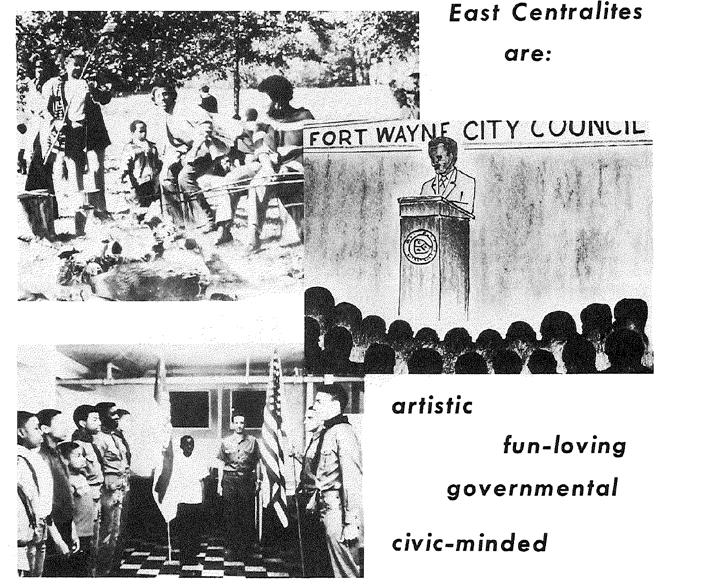





The Dudley Street Initiative Workshop was a learning experience for East Central residents, who learned how grassroots community action can help address community safety needs and encourage neighborhood revitalization. Inspired by the success of the highly regarded Dudley Street Neighborhood Initiative in Boston, workshop attendees identified the importance of reclaiming community ownership, building leadership from within, and strengthening partnerships across non-profit organizations and local government. Important takeaways from the workshops were empowering youth and making neighborhood leadership more visible in the East Central neighborhood.
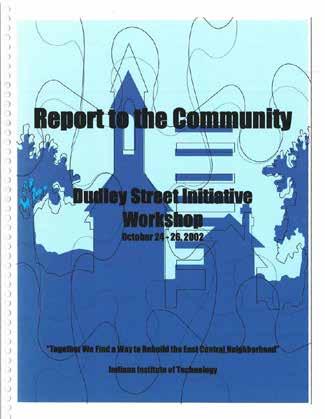
The workshop reinforced that strong, trust-based relationships among residents, local institutions like Indiana Tech and East Wayne Street Center, and local government are essential for successful community policing and crime reduction. Maintaining clean, safe, and active neighborhood environments—such as well-lit alleys, pedestrianfriendly streets and lighting, and vibrant green spaces—was seen as essential to deter crime and improve residents’ sense of safety.
The 2005 East Park Planning Alliance neighborhood plan, developed by the East Park Planning Alliance, was one of Fort Wayne’s first Community Development Action Plans, initiated in response to the City’s 2003 Comprehensive Housing Strategy. As Fort Wayne’s oldest residential neighborhood, East Central was selected for focused planning to address long-standing challenges, including widespread building demolitions, disinvestment, and a deteriorating housing stock. Specifically, the Plan noted that in twenty years between 1985 and 2004, East Central experienced a dramatic loss of 498 structures due to widespread demolition, resulting in over 25% of the neighborhood’s land becoming vacant. While some demolitions led to new housing and the expansion of Indiana Tech’s campus in the middle of the neighborhood, nearly 40% of the neighborhood’s historically significant properties were altered or lost in less than a decade. The East Central Planning Alliance conducted workshops, community meetings, and surveys to develop a shared set of goals and policies. These efforts were informed by national best practices and local study tours, grounded in community values such as increased homeownership, neighborhood preservation, and public safety. The Plan addressed land use, transportation, housing, and community facilities while emphasizing collaboration with institutions like Indiana Tech.
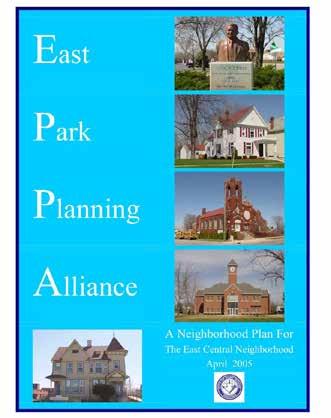
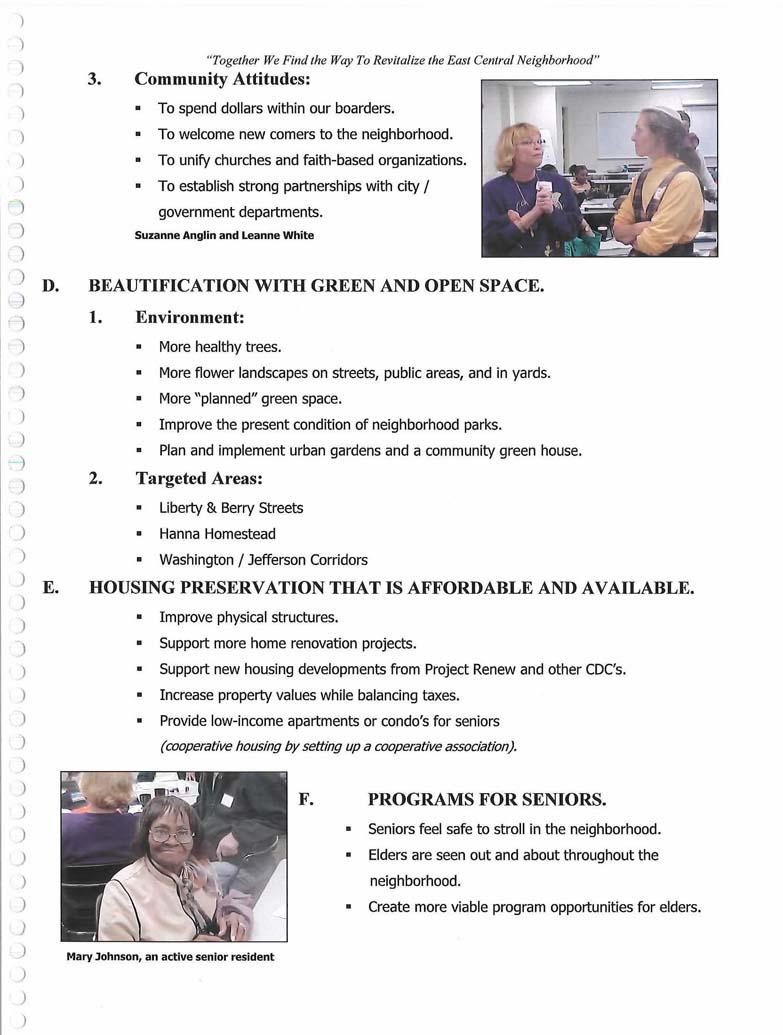
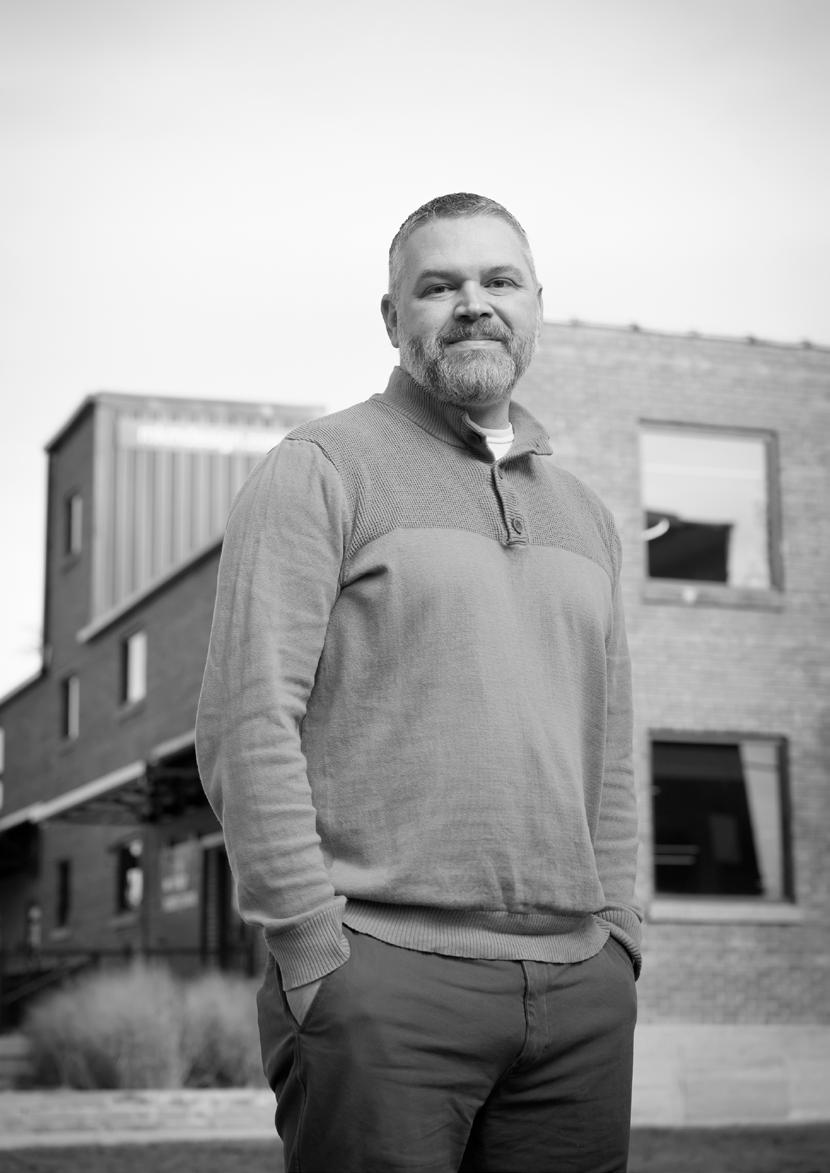
”The future of East Central is reliant on meaningful placemaking strategies that honor the history of the neighborhood and embrace a bold and inclusive vision for growth.
Zachary Benedict - MKM Architecture President





East Central is a neighborhood shaped by deep roots, dramatic changes, and enduring resilience. Once a vibrant and densely populated hub of Fort Wayne’s cultural, social, and residential life, East Central has faced nearly six decades of population loss, economic disinvestment, and shifting community dynamics. The scars of historic redlining, demolition, and highway speculation are still visible in its housing, infrastructure, and income levels – but so too is the potential for its renewal as a premiere neighborhood.
Understanding the existing conditions in East Central is more than a technical exercise of collecting data – it is an essential step toward recognizing the neighborhood’s history and
addressing challenges. The following pages include data from 1960 to present (provided by the U.S. Census Bureau), highlighting key trends related to population changes, racial and ethnic demographics, poverty, housing, education, and income. This information reveals a neighborhood that has faced significant obstacles but has also shown strength and resilience. The East Central Forward neighborhood plan uses data as the basis for making informed, thoughtful, practical, and future-oriented policy decisions. These conditions will help guide a community-driven action plan that ensures the future of East Central includes opportunities for growth and improved quality of life for all residents.



The East Central Neighborhood spans portions of Census Tracts 13, 43, and a small section of 16, though nearly all residents live within Tracts 13 and 43. There are fewer than five residences that fall within Tract 16, located south of the Norfolk Southern railroad tracks that separate East Central from much of Southeast Fort Wayne.
These census tracts do not align exactly with neighborhood boundaries – for example, Tract 13 includes parts of downtown Fort Wayne, and Tract 43 overlaps with Memorial Park. As a result, the demographic data in this section is the most accurate data available, but it does include information about nearby areas due to the overlapping boundaries. Due to the limitations of the census tract data, neighborhood specific data is analyzed when available.
This section analyzes block group data, which allows the analysis of only East Central residents,
cutting out portions beyond East Central’s borders at the level of census tracts. However, this data is slightly limited in its accuracy because of the higher margin of error in smaller areas.
Population data offers one of the most important insights into the East Central neighborhood and its broader context.
Between 1960 and 2020, the East Central neighborhood experienced a sustained and significant population decline. In 1960, East Central was home to approximately 10,630 residents. By 2020, that number had fallen to just 2,410 — a loss of more than 8,200 residents or a 77% decrease over six decades. This decline has had profound implications for the neighborhood’s housing, infrastructure, and community life.
This map illustrates population changes at the block level in East Central neighborhood using graduated arrows - green arrows indicate areas of population growth, while red arrows represent population decline
2000: 2,731 Residents
2010: 3,692 Residents
2020: 2,410 Residents
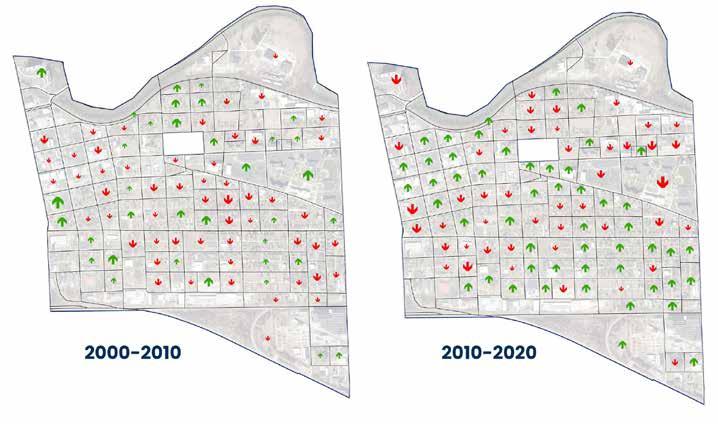





The most dramatic population losses occurred between 1960 and 1990:
•1960 to 1970: The population dropped by about 2,878 residents (−27.1%), reflecting early waves of suburban migration.
•1970 to 1980: Another approximately 2,651 residents were lost (−34.2%), likely driven by further housing demolition, and economic shifts in the city.
•1980 to 1990: The decline slowed, but East Central still lost 1,139 residents (−22.3%).
From 1990 onward, the rate of population loss decelerated.
•1990 to 2000: A loss of 1,231 residents (−31.1%).
•2000 to 2010: A slight uptick occurred, with a gain of 961 residents (+35.2%)
•2010 to 2020: Population fell again by 1,282 residents (−34.7%), bringing the total to roughly 2,410
Between 1960 and 1980, East Central lost more than 5,500 residents—over 50% of its population in just two decades. This dramatic decline was the result of several overlapping challenges that weakened the neighborhoods social, economic and physical environments.
By 1960, East Central was the heart of Fort Wayne’s Black community, yet nearly half of its residents lived in substandard housing. Decades of disinvestment, driven by absentee landlords, and overcrowding caused by segregation, left the neighborhood’s housing stock deteriorating and neglected. Rather than receiving the resources and support needed for rehabilitation, East Central was met with aggressive demolition and inspection policies in the 1970s.
Fort Wayne, and specifically the East Central Neighborhood, had multiple highway proposals between the 1960s and 1970s that threatened large-scale demolition. Even though the plans to demolish large portions of the neighborhood to build a highway would never be realized and Interstate 69 was instead constructed at the western and northern edges of the city, the fear of
displacement led to widespread uncertainty and discouraged investment in the neighborhood.
Fort Wayne, like most American cities had a series of protests and confrontations between 1969 and 1972, which reflected deep frustrations between residents and officials over inequality, policing practices, and lack of economic opportunity. Incidents like the WLYV firebombing at the corner of Hayden and Winter Streets, and a violent skirmish with youth at the McCollough Center (now Jennings Center), both in East Central, heightened levels of distrust, and further stigmatized the neighborhood to those outside of it. (The East Central Neighborhood: Iadicola/Ashton, 1982)
Internal divisions within the East Central Neighborhood, the East Wayne Street Center, the Martin Luther King Jr. Center, and the Lincoln Life Home Improvement Area weakened opportunities for residents to work together for community building. The East Central Neighborhood itself also had several years of leadership turnover, and the dynamics between groups undermined efforts to advocate for residents during a time where collective action was greatly needed.
The population decline of the 1960s and 1970s was not just about people leaving—it reflected the loss of homes, businesses, community spaces, and trust. What followed was decades of continued decline, vacancy, and disinvestment.
East Central’s Black population made up the majority of East Central for much of the late 20th century but has declined substantially in both real numbers and share of the total population since 1990:
•1990 to 2000: The population declined from 2,727 to 1,615 residents (−40.8%)
•2000 to 2010: Decline continued to 1,533 residents (−5.1%)
•2010 to 2020: Another decline brought the number down to 1,002 (−34.6%).
From 1990 to 2020, the Black population in East Central decreased 63%. The proportion of the neighborhood’s Black population also decreased; the Black population made up
68.8% of the neighborhood in 1990, dropping to only 41.5% in 2010, and 41.6% in 2020.
These figures represent both absolute population loss and a significant demographic shift, with the neighborhood transitioning from a historically Black-majority area to a more racially mixed community by the 2010s.
The Hispanic population in East Central has seen remarkable growth. In 1990, only 97 Hispanic residents were recorded, making up just 2.4% of the neighborhood’s population. Since then:
•1990 to 2000: Population grew to 160 (+64.9%).
•2000 to 2010: Growth continued to 307 (+91.9%)
•2010 to 2020: The Hispanic population increased to 389 (+26.7%).
East Central’s Hispanic population grew by 301%
from 1990 to 2020. By 2020, Hispanic residents made up 16.1% of East Central’s population — a significant demographic shift that signals growing diversity and emerging cultural influence within the neighborhood.
The White population in East Central declined 18% over the past 40 years. In 1990, East Central had 1,062 White residents, but today there are only 868.
•1990 to 2000: The White population declined from 1,062 to 893 residents (−15.9%)
•2000 to 2010: A sharp increase brought the population up to 1,725 residents (+93.2%).
•2010 to 2020: The population declined again to 868 residents (−49.7%).
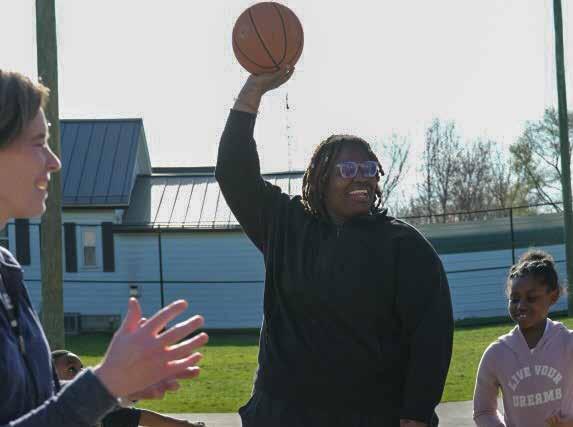





From 1960 to 2020, the East Central neighborhood experienced a dramatic population decline. The most significant losses occurred between 1960 and 1980, driven by overlapping challenges: housing deterioration, large-scale demolitions, failed infrastructure proposals, community unrest, and fragmented local leadership. This decline signaled the erosion of community assets, trust, and stability.
Alongside the population decline, the neighborhood has experienced increased diversity, transitioning from a primarily Black neighborhood to a community of several demographic groups.
These long-term shifts underscore the need for renewed investment, inclusive engagement, and forward-thinking strategies to stabilize and revitalize East Central for the next generation.
The East Central Planning Area—which includes the East Central Neighborhood, Memorial Park Neighborhood, and the eastern edge of downtown Fort Wayne—has undergone significant demographic shifts over the past six decades. Defined by Census Tracts 13 and 43, this area provides a valuable lens through which to understand broader urban change, especially in terms of population dynamics, racial composition, and socioeconomic conditions.
In 1960, the East Central Planning Area was home to 13,583 residents—making up 8.4% of Fort Wayne’s total population. As one of the city’s most densely populated and culturally significant neighborhoods, East Central was a center of residential life, community institutions, and social identity. Over the following decades, however, the area experienced a sustained and significant population decline, even as Fort Wayne continued to grow. By 2020, the population of the Planning Area had dropped to just 4,330—less than onethird of its 1960 total—and accounted for only 1.6% of the city’s population. These shifts were accompanied by dramatic changes in the racial and ethnic composition of the neighborhood,
including the outmigration of Black and White residents and the steady rise of a growing Hispanic population. Understanding this evolution is critical to shaping a future that reflects East Central’s rich legacy while meeting the needs of a changing and diverse community.
Over the past six decades, the racial and ethnic makeup of the Planning Area has shifted dramatically. Historically home to a large portion of Fort Wayne’s Black community, East Central remained majority Black through much of the 20th century. However, in recent decades, both the Black and White populations have declined in number and as a share of the total population, while the Hispanic and Asian populations have grown.
By 2020, the area had become considerably more diverse, with no single racial or ethnic group comprising a majority.
The East Central Planning Area has long held a central place in the history and identity of Fort Wayne’s Black community. For much of the 20th century, it served as a cultural, social, and residential core for Black residents—especially during periods when discriminatory housing practices and segregation limited access to other parts of the city. However, over the past several decades, both
the number and concentration of Black residents in the East Central Planning Area have declined significantly, reflecting broader demographic shifts and patterns of mobility, displacement, and dispersal.
In 1960, the area was home to 5,760 Black residents, accounting for 42.4% of the total population of the East Central Planning Area. At the time, nearly half (49.5%) of Fort Wayne’s entire Black population lived within this area. Over the following two decades, the Black population within the Planning Area increased in proportion, reaching a peak of 80.5% of the area’s total population in 1980 (5,595 residents), though this growth in percentage happened even as the total neighborhood population declined sharply.
From 1980 onward, however, a long-term trend of decline began to reshape the community:
•1980 to 1990: The Black population fell from 5,595 to 3,561 (−36.3%), while the share of Fort Wayne’s Black population living in East Central dropped from 22.7% to 12.3%
•1990 to 2000: Another steep decline occurred, with the population falling to 2,669 (−25.1%)
•2000 to 2010: The number of Black residents decreased further to 2,131, representing just 43.7% of the area’s population and only 5.5% of Fort Wayne’s total Black population.
•2010 to 2020: The trend continued, with the Black population declining to 1,655 residents— just 38.2% of the Planning Area’s population and only 4.2% of the city’s Black population.
This dramatic demographic shift underscores the dispersal of Black residents from East Central over the past four decades. In 1960, one out of every two Black residents in Fort Wayne lived in the East Central Planning Area. By 2020, that figure had dropped to just one in 25.
The East Central Planning Area has transitioned from being Fort Wayne’s primary Black residential hub to a more racially mixed community with a significantly smaller share of the city’s Black population. This transformation carries both historical weight and planning implications. As the community continues to evolve, it is essential to acknowledge this legacy, protect remaining cultural anchors, and support inclusive, community-led development that honors the neighborhood’s deep roots in Black history.
Over the past five decades, the Hispanic population in the East Central Planning Area has seen steady and significant growth. While initially a small segment of the neighborhood’s population, Hispanic residents have become one of the fastest-growing demographic groups in the area—contributing to the neighborhood’s growing





diversity.
In 1970, the East Central Planning Area recorded 172 Hispanic residents, making up just 1.6% of the total population. At that time, Hispanic residents in East Central represented 6.2% of Fort Wayne’s total Hispanic population. Throughout the 1980s and 1990s, the population remained relatively small, hovering around 2.6% to 2.8% of the neighborhood’s total. In 1990, for example, only 142 Hispanic residents lived in the area, or 2.6% of the neighborhood’s population.
Beginning in the early 2000s, however, the Hispanic population began to grow at a much faster rate:
•2000: The Hispanic population more than doubled from 1990, rising to 304 residents and accounting for 6.7% of the neighborhood.
•2010: Growth continued with 478 Hispanic residents making up 9.8% of the East Central Planning Area.
•2020: The number of Hispanic residents increased again to 684, representing 15.8% of the area’s total population
The Hispanic population has emerged as a dynamic and growing part of the East Central community. Between 1990 and 2020, the number of Hispanic residents significantly grew, helping offset broader population decline in the neighborhood.
From 1960 to 2020, the East Central Planning Area experienced a steep and consistent decline in its White population—both in real numbers and as a share of the neighborhood’s total and the city’s overall White population.
In 1960, White residents made up 56.6% of the East Central Planning Area’s population, totaling 7,687 individuals. At the time, the area represented 5.1% of Fort Wayne’s total White population. However, over the next two decades, this population fell dramatically:
•1970: The White population dropped to 3,645 (−52.6% from 1960), comprising 34.6% of the neighborhood and just 2.3% of the city’s White population.
•1980: The decline continued to 1,934 residents (−46.9% from 1970), only 27.8% of the neighborhood and 2.5% of Fort Wayne’s White population.
While the pace of decline slowed in later decades, the trend continued:
•1990: White residents numbered 1,595, making up 29.7% of the neighborhood and 1.4% of Fort Wayne’s White population.
•2000: The total slightly decreased again to 1,553 residents, but the percentage of the neighborhood population increased to 34.2% as overall population fell.
Notably, the 2010 Census reflected a temporary reversal in this pattern:
•2010: The White population increased to 2,031 (a 30.8% increase from 2000), representing 41.6% of East Central’s population—the highest share since 1960. This may reflect reinvestment efforts or demographic shifts tied to new housing near the eastern edge of downtown.
However, by 2020, the White population once again declined to 1,646, accounting for 38.0% of the Planning Area and just 1.0% of Fort Wayne’s total White population.
In 1960, children and youth under the age of 18 made up one-third of the neighborhood’s population, and East Central accounted for 8% of all young people in Fort Wayne. During the same period, older adults aged 65 and over comprised nearly 10% of the area’s population and 8.8% of the city’s senior residents. These numbers reflect a time
when East Central was a more intergenerational neighborhood, home to large families, longtime residents, and a strong base of community institutions that served people across the lifespan.
Today, both age groups represent a much smaller share of the city’s total population. While children under 18 still account for 20% of East Central’s population, the neighborhood now makes up just 1.3% of Fort Wayne’s youth. Similarly, although older adults make up 11% of the neighborhood’s population, East Central accounts for only 1.2% of the city’s seniors.
The East Central Forward plan includes targeted strategies to address these needs—from housing and transportation to safety, health, and inclusive public spaces—so that residents of all ages can call East Central home for years to come.
The population of children and youth under the age of 18 in the East Central Planning Area has declined significantly over the past six decades, both in total numbers and as a share of the neighborhood and citywide youth population. This demographic shift has had far-reaching implications for local schools, family services, housing demand, and the overall social fabric of the East Central neighborhood.
In 1960, children under the age of 18 made up one-third of the total population, 33.8%, or 4,589 residents out of the 13,583 total. At that time, the
neighborhood planning area accounted for 8% of Fort Wayne’s total youth population. Throughout the 1970s, the proportion remained steady, even slightly increasing to 34.2% by 1970, however the total number of youths dropped to 3,604, reflecting the broader population decline that began decades earlier.
By 1980, the number of children under the age of 18 had fallen sharply to 2,144, or 30.9% of the neighborhood population. This decline that would continue over the next several decades:
•1990: The youth population dropped to 1,462 representing just 27.3% of the planning area population.
•2000: The age-cohort population fell again to just 1,005 children, or 22.1% of the neighborhood planning area’s total population.
•2010: The children under 18 population reached its lowest level, at just 850 youth which comprised only 17.4% of neighborhood residents.
•2020: While the area experienced a slight rebound up to 873 children under the age of 18, 20.2% of the total population is still well below historic levels, and significantly below the average population for most neighborhoods.
At the city level, East Central’s share of Fort Wayne’s youth population declined from 8.0% in 1960 to just 1.3% in both 2010 and 2020, which aligns with much of the suburban expansion of the city in the decades since 1960. Once a neighborhood where families with children made up a large portion of the community, East Central today is home to a much smaller proportion of the city’s youth, which has impacted the number of services and amenities that serve the community. For example, the closure of Central High School and Harmar Elementary, both had an impact on where students could go to school, which are now distributed across the city. Additionally, recreational programming at the Jennings Center, and family-serving institutions have seen changes, primarily due to the demographic changes in the neighborhood.
This change also reflects broader housing and economic conditions in the East Central Neighborhood. As housing stock continued to decline post-war, and opportunities for upward mobility moved to other neighborhoods across the city, families with children may have sought housing in areas that had safer streets, amenities, and perceived opportunity, which had multi-





decade impacts on the community.
Its important as the neighborhood looks to the future, reversing or stabilizing this trend will be important to restoring an intergenerational community. Strategies in East Central Forward aim to attract and retain families with children – through supportive housing infill and safe neighborhood environments.
The East Central Planning Area has historically included a meaningful share of Fort Wayne’s older adult population, but like many of the neighborhood’s demographic groups, the number of residents aged 65 and over has declined significantly over time. In 1960, the area was home to 1,338 seniors, representing 9.9% of the total neighborhood population and 8.8% of Fort Wayne’s seniors overall. By 2020, the number had dropped to 477 seniors, or 11.0% of East Central’s population—but only 1.2% of the city’s total senior population.
While the proportion of older adults within the neighborhood has remained relatively stable over the decades—hovering between 9% and 14%—the absolute number of seniors has steadily decreased, reflecting the broader population decline and outmigration experienced by East Central since the 1960s. Between 1990 and 2010 alone, the number of seniors in the neighborhood fell by nearly half, from
65+ Population East Central Total Population
743 to 409 residents. Though there was a modest increase to 477 residents in 2020, East Central now accounts for only a small share of the city’s growing senior population.
This trend has important implications for neighborhood planning. As Fort Wayne’s senior population continues to grow citywide, East Central must position itself as an age-friendly community.
Considerations that will be expressed throughout the East Central Forward neighborhood plan include:
• Innovative housing options, including onestory homes, accessible apartments, and affordable assisted living opportunities
•Improved walkability and access to public transportation, especially for seniors who no longer drive
• Investing in neighborhood-level health and wellness services
• Creating intergenerational public spaces and investing in parks and community centers –that welcome all ages and help reduce social isolation among East Central’s older residents
• Strengthening safety and lighting infrastructure, especially around frequently used destinations and gathering spaces in the neighborhood
As East Central looks to grow and stabilize, supporting its aging population must be a central part of the neighborhood’s strategy. Not only will these investments improve quality of life for current older adults, but they will also ensure the neighborhood remains livable and inclusive for all residents as they age.
An important part of understanding the context about housing conditions and neighborhood desirability in the East Central Planning Area is analyzing median housing values for the neighborhood.
In 1960, homes in East Central had a median value of approximately $83,483, which was 33% lower than the median housing value citywide ($124,683). Between 1960 and 1977 alone, East Central was estimated to have lost over 41% of its housing units, representing a loss of over 2,200 dwellings (1980 East Central Plan). The resulting vacant lots and
abandoned structures dramatically reshaped the neighborhoods physical landscape, depressing property values. In the same study from 1980, it was shown that in four years, between 1974 and 1978, East Central recorded just ten housing market transactions at a rate approximately 85% lower than the city-wide average at the time. Over the subsequent decades, median housing values in
East Central Fort Wayne
East Central saw a notable decline relative to Fort Wayne, falling sharply to their lowest comparative level in 1980, when East Central homes were valued at only 38.7% of the city’s median.
From 1990 onwards, East Central began to experience a slow recovery in home values. By 2000, the neighborhood’s median housing value had increased to nearly $71,000 representing approximately 50.5% of Fort Wayne’s median value. Two decades later, the median housing value in East Central reached $78,934, now nearly 53% of Fort Wayne’s overall median home price ($149,740).
Although recent decades indicate gradual improvement, East Central’s housing values remain substantially below the city average. While root causes stem from historical factors such as the practice of redlining, disinvestment, and demographic shifts, East Central Forward seeks to address these issues by advocating targeted investment in housing rehabilitation, strategically reinvesting in community infrastructure, and improving livability through restoring neighborhood pride and rebuilding a healthy and vibrant community.
Housing patterns have significantly shifted since 1960 in the East Central Planning Area, altering the neighborhood’s character. Historically, East Central, while still featuring a higher number of rentals than other neighborhoods in Fort Wayne, was relatively balanced between owner-occupied and renter-occupied in 1960. About 47% of homes, or about 2,000 households were owner-occupied, accounting for almost 6% of all owner-occupied units in Fort Wayne.
However, over the next several decades,





homeownership in East Central declined, and by 1980, only 1,152 units, making up approximately 45% of the area’s occupied housing was owneroccupied. This would further decline to just 610 units or about 37% of all housing in the area by 2020. This sustained declined indicates diminishing homeownership opportunities in the neighborhood.
Rental housing has steadily increased in East Central. In 1960, rental units already made up over half (54%) of all occupied units, but by 2020, rental housing had grown to over 63%, with 1,055 occupied rental units. The growing dominance of rental housing has contributed to greater population turnover in the neighborhood, which has led to reduced community cohesion, limited property maintenance investments, and increased challenges in housing quality and stability. However, this also highlights an opportunity to engage renters as active community participants. Rental housing, especially with East Central’s proximity to downtown Fort Wayne, provides flexible and often affordable living options, which may attract new residents seeking a vibrant walkable neighborhood.
Analyzing median household income in the East Central Planning Area – adjusted for inflation to January 2025 dollars – provides important insights into economic conditions affecting neighborhood residents. Historically, household income in East Central has consistently lagged behind citywide averages, reflecting sustained economic challenges in local opportunities.
In 1960, median household income in East Central was approximately $40,400, about 67% of Fort Wayne’s median household income of $60,152. By 1970, the neighborhoods median income slightly increased to $49,310 which was about 70% of the city’s median, indicating relatively economic stability.
By 1990, median household income in East Central dropped dramatically to just $21,509, only 32% of Fort Wayne’s median income of $66,366 This significant decline highlights the economic impacts of the past decade, and the loss of major institutions that drove economic advancement. Since the 1990s, East Central experienced some recovery, although median incomes have remained substantially lower than city-wide averages. By 2000, the median household income increased to approximately $46,645 reaching about two-thirds of the city’s median. In 2010, during the economic recovery of the 2008 recession, income was approximately $41,236 or still roughly two-thirds of the city’s median of $63,637.
These persistent income gaps underscore ongoing economic challenges for East Central area residents. Lower household incomes limit opportunities for homeownership, investment in home maintenance, and support for local businesses, which can complicate neighborhood revitalization efforts. Recent investments by the City of Fort Wayne, Habitat for Humanity, Indiana Tech, and local residents have worked to address some of the economic disparity, however, more will need to be done over the ensuing decade to promote
East Central Fort Wayne
economic empowerment to raise household incomes and foster a more economically resilient neighborhood.
The East Central Planning Area has faced significant and long-term economic challenges, reflected in both its household income levels and consistently high poverty rates. In 1970, just over 21% of East Central residents lived below the poverty line. That figure peaked at nearly 30% in 1980, and although there was some improvement in the following decades, poverty rates surged again in recent years. By 2020, 42.2% of the neighborhood’s population was living in poverty, nearly triple the rate from 2010. These conditions meet the U.S. Census Bureau’s criteria for persistent poverty, a designation reserved for communities with poverty rates of 20% or more for at least 30 years. East Central’s status as a persistent poverty census tract reflects deep, systemic challenges that continue to shape life in the neighborhood today.
Persistent poverty areas, as defined by the Census Bureau, are more likely to face entrenched barriers such as limited access to quality education, healthcare, affordable housing, and civic infrastructure. The implications extend beyond individuals, affecting the neighborhood’s resilience, economic vitality, and ability to attract long-term investment.
Yet despite these challenges, East Central is also rich with potential. Its central location and proximity to downtown Fort Wayne, adjacency to Indiana Tech, and active network of community organizations position the neighborhood for meaningful renewal. The East Central Forward neighborhood plan recognizes that reversing decades of economic hardship will require focused, sustained, and equitable investment.
Since 1990, educational attainment among residents aged 25 and older in the East Central Planning Area has shifted notably, reflecting both encouraging signs of progress and ongoing challenges. In 1990, nearly 45% of the adult population lacked any high school diploma or continuing education, more than double the citywide average at the time. By 2020, that figure
had dropped significantly to 29.5%, which is a notable improvement that suggests progress in basic education access and outcomes.
However, East Central still lags behind citywide and national averages in higher educational attainment. While the share of residents holding a high school diploma or equivalent decreased from 36.6% in 2010 to 26.7% in 2020, there was a simultaneous and promising rise in those pursuing additional education. The percentage of adults with some college – no degree rose from 14% in 1990 to 27.6% in 2020, indicating that more residents are engaging in postsecondary education, particularly in technical programs, skilled trades, and job focused training. This represents a key opportunity for workforce development in East




Central, especially if paired with supports that help residents complete credentials or degrees.
Degrees at the higher end of the educational range have also shown growth. In 1990, only 4.7% of adults in East Central held a bachelor’s degree; however, by 2020, that number doubled to 9.8%. Graduate degrees rose more modestly, from 3.0% to 4.2% over the same period. While these figures are still below broader citywide or national benchmarks, they reflect positive momentum and a growing base of residents with advanced education which can have a greater impact on household incomes, median housing values, and growing access to economic opportunity.
The East Central Forward neighborhood plan begins with the understanding that progress cannot happen without an honest assessment of where we are and how we got here. Over six decades, East Central has experienced significant population loss, dramatic demographic change, persistent poverty, and declining housing stock – all while remaining a vital part of Fort Wayne’s history and identity. Yet, even amidst these realities, there are signs of resilience and resurgence. Educational attainment is improving, housing values are slowly rebounding, and a growing diversity in the cultural landscape of the neighborhood is bringing new energy and diversity. Importantly, key institutions like Indiana Tech and local non-profit organizations and foundations are investing in the neighborhood’s future.


To continue this progress, the East Central Forward neighborhood plan supports strategies that partner with Indiana Tech to expand access to education, training, and resources. Through increasing the partnership between Indiana Tech and the neighborhood, East Central can better prepare its workforce for quality jobs, improved household incomes, and long-term neighborhood stability.
This plan embraces those opportunities. With a commitment to transparency, the East Central Forward neighborhood plan sets a course toward a neighborhood that is economically strong, socially connected, and reflective of the people who call it home.
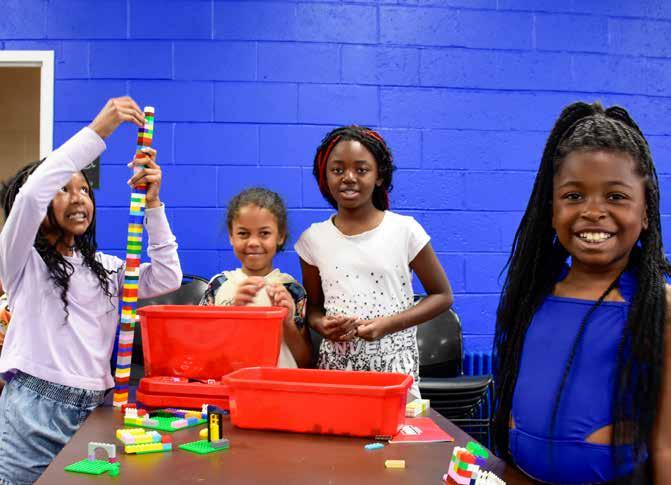
The health of a neighborhood is often a direct reflection of its history, environment, and access to opportunity – and in East Central, this story is complex and urgent. Decades of challenges in the East Central Neighborhood have shaped current health outcomes in ways that go far beyond individual health choices.
Understanding the unique challenges and strengths of East Central’s health outcomes will not only aid residents in achieving their vision of success but will also guide community leaders and City officials in developing effective investments to improve health in the neighborhood. Recognizing a way forward to improve health and wellbeing for East Central residents will not only benefit those living within its boundaries, but will contribute to the physical, social, and economic vibrancy of Fort Wayne.
Social determinants of health describe the circumstances in which people are born, grow up, live, work, and age, and the corresponding systems used to deal with illness. Social determinants of health are important because they have a major impact on people’s health, wellbeing, and quality of life and can be more important than health care or lifestyle choices in influencing health outcomes. Moreover, where someone lives, as measured by zip code, has been found to be a stronger predictor of health than their genetic code.
These circumstances are shaped by a wide set of forces such as economics, social policies, governance, and politics that may affect health outcomes. Social determinants of health are typically measured by income and social protection, education, unemployment, working life conditions, food insecurity, housing, aspects of the built environment like parks, sidewalks, trees, and lighting, air and water quality, early childhood development, social inclusion and nondiscrimination, structural conflict, language and literacy skills, and access to affordable quality health services.
Social determinants of health contribute to disparities in health. For example, people without a vehicle who live in areas far from grocery stores with healthy foods are less likely to have good nutrition, which raises their risk of health conditions like heart disease, diabetes, and obesity. Those who live in neighborhoods that encounter frequent crime and violence may experience chronic stress, negatively affecting health across their lifespan. Environmental factors impacting health may have multi-generational effects, compounding inequities over time.
According to the Parkview Community Health Needs Assessment, in the United States, racial and ethnic minority groups experience higher mortality rates and increased incidence of a wide range of illnesses compared to their white counterparts. These health outcome disparities are linked to social determinants in the following areas: physical environments and neighborhoods, healthcare access, workplace conditions, social and community context, education, and income gaps. According to the Centers for Disease Control, health equity is the state in which everyone has a fair and just opportunity to attain their highest level of health and is achieved when the policies, systems, and environments that form the social determinants of health are accounted for in an equitable manner.
Evidence shows that discriminatory practices have inscribed inequities into our policies, systems, and the built environment. Redlining, for example, was greatly influential in this process and is largely responsible for racial housing segregation nationally and locally, which contributes to both geographic inequality and health disparities. In the 1930’s, the federal Home Owners’ Loan Corporation created Residential Security Maps of most American cities, including Fort Wayne. These maps classified neighborhoods at various levels of investment risk. Neighborhood sections that were ‘redlined’, or given a grade a ‘D’, were not able to obtain home mortgages or small business loans from banks or the federal government. Grades were based on the age and condition of housing, transportation access, closeness to amenities, economic class and employment status of residents, and, notably, racial and ethnic composition. According to the University of Richmond’s Mapping Inequality Project, “Redlining was legal and practiced for





decades. It dramatically affected the relative wealth—as well as the health—of different racial groups in America. Its impact is still with us today.” In 1937, a large southern section of East Central was redlined with a grade of D “needs significant improvement,” and was therefore ineligible for home mortgages or small business loans in the area. The rest of the neighborhood was graded C “needs improvement,” and therefore would have had great difficulty in obtaining home mortgages or small business loans.
While there is no single solution to reverse the outcomes of redlining, its continual impact on the composition of Fort Wayne’s neighborhoods can be significant. Furthermore, achieving health equity in East Central and in Fort Wayne should be a priority. Underscoring the network of influences, including the legacy of redlining, that contribute to inequities is crucial in this process.
Parkview Health is a regional non-profit hospital system that produces a Community Health Needs Assessment of northeast Indiana every three years. In the latest report, released in 2022, Parkview identified the top ten health concerns for its eightcounty service region: mental health, substance use/abuse, obesity, cancer, chronic obstructive pulmonary disease (COPD), cardiovascular disease (stroke, coronary disease), kidney disease, diabetes, asthma, and child abuse. Additionally, the report identifies the ten top health service needs: mental health services, access to recreational spaces, substance use disorder services, childcare, access to healthy food, health insurance, access to primary care providers, gun safety, senior services, and access to birth control.
Health data in the following sections was gathered from the Centers for Disease Control’s 2024 PLACES health data. The health outcomes of the East Central Planning Area are compared to those of Fort Wayne and the Historic Northeast Planning Area, an adjacent area north of the Maumee River. The data refer to health outcomes among adults, and no data from this source was available for kidney disease or child abuse outcomes.
Mental health was measured by the outcomes of depression, feelings of social isolation, lack of social and emotional support, and frequent mental
distress. The rate of depression in East Central (23.7%) was lower than that of the city (24.0%) and of Historic Northeast (25.6%). On the other hand, rates of social isolation (36.2%), lack of social/ emotional support (32.9%), and frequent mental distress (21.6%) were higher than the city (32.2%, 26.1%, 18.4%) and Historic Northeast (31.6%, 23.5%, 18.4%).
Substance use and abuse were measured by the outcomes of current cigarette smoking and binge drinking. A higher rate of East Central resident’s smoke (24.5%) than the city (18.4%) and Historic Northeast (17.5%) and a lower rate of East Central resident’s binge drink (15.5%) than the city (15.9%) and Historic Northeast (18.4%).
Obesity is a medical criterion that occurs when body mass index (BMI) exceeds 30.0 and can arise as a result of a mix of factors including genetics, certain health risk behaviors, long-term stress, certain medical conditions, and environmental features such as a lack of access to exercise opportunities and fresh foods. East Central residents experience increased rates of adult obesity (44.6%) compared to the city (38.9%) and Historic Northeast (38.1%) Additionally, 35.8% of East Central residents had no leisure-time physical activity, whereas 28.4% of city residents and 24.2% of Historic Northeast residents had no leisure-time physical activity.
East Central Fort Wayne
East Central residents have a lower non-skin cancer rate (4.8%) than the city (7.3%) and Historic Northeast (6.8%)
Chronic respiratory diseases like COPD, of which smoking is a leading cause, and asthma lead to breathing difficulty and can be agitated by poor air quality. East Central has a higher rate of COPD (10.0%) than the city (8.4%) and Historic Northeast (7.5%) and also a higher rate of asthma (12.1%) than the city (11.2%) and Historic Northeast (11.0%).
Cardiovascular disease affects the heart and blood vessels and is estimated to be the leading cause of death worldwide. Cardiovascular disease leads to health problems such as stroke, heart attack, and coronary heart disease. High blood pressure is a risk factor for cardiovascular disease. East Central has higher rates of stroke (4.8%), coronary heart disease (7.3%), and high blood pressure (40.1%) than the city (3.8%, 7.1%, 35.6%) and Historic Northeast (3.0%, 6.0%, 31.1%)
Diabetes is a chronic disease in which the body either does not produce enough insulin or does not effectively use insulin leading to elevated blood glucose levels. East Central has a higher rate of diabetes (15.5%) than the city (13.0%) and Historic Northeast (10.6%)
Lastly, routine check-ups with a primary care physician and a lack of health insurance were examined in the data. 75.2% of East Central residents had a check-up in the past year, which is slightly lower than city-wide residents (77.4%) and Historic Northeast (75.8%). 16.0% of adults aged 1864 lack health insurance in East Central, whereas 10.5% are without insurance across the city and 8.0% are without insurance in Historic Northeast. In regard to sleep, 41.6% of adult in East Central had short sleep duration, which is higher than the city (36.2%) and Historic Northeast (35.2%)
The data shows that East Central residents experience higher rates of depression, diabetes, high blood pressure, smoking, and obesity than their citywide peers. These conditions are further exacerbated by social factors such as housing instability, limited access to fresh food, unimproved physical infrastructure, and lack of recreational time and physical activity.
Understanding this information is important, as it is a call to action. The East Central Forward neighborhood plan embraces the opportunity to improve neighborhood health in East Central by investing in walkable and safe infrastructure, health resources, improved public spaces, and seeks to remove barriers and promote wellbeing, social capital, and physical activity at every stage of a resident’s life.
Health is more than the absence of an illness, it is the presence of opportunity, safety, dignity, relationships, and connections. Achieving improved health in East Central means making coordinated investments that address the causes of poor and inadequate outcomes. Through collaboration between residents, institutions, non-profit organizations, foundations and City leadership, East Central can become a model for a thriving, healthy neighborhood.
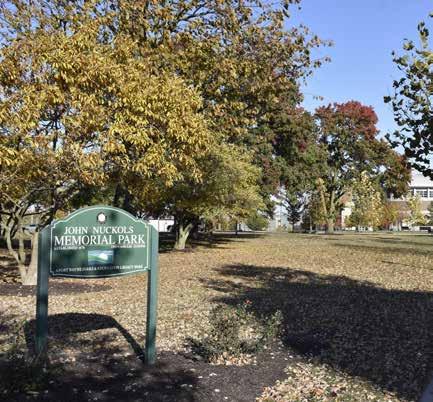






Building Department permit records provide a valuable tool to track patterns of investment, disinvestment, and transformation within a neighborhood. In East Central, a total of 4,497 building permits were filed between 1985 and 2024. These permits encompass a wide range of activity, from minor repairs such as masonry fixes on commercial buildings, garage additions, and wood framing for a basement, to larger additions like garages and structural expansions.
Beyond tracking physical improvements in East Central, permit activity serves as a historic record that reflects the broader trajectory of the neighborhood. Periods of limited permit issuance may warn of disinvestment or economic stagnation, while increased permit activity can note moments of reinvestment and neighborhood change. As such, the permit history in East Central not only highlights the types of improvements undertaken over the past four decades but also brings to light the long-standing challenges of underinvestment, as well as some emerging signs of revitalization. Integrating this data into planning efforts helps develop policy based on the lived history of East Central and supports targeted strategies to encourage reinvestment moving forward.
Between 1985 and 2024, a total of 374 permits were issued for property repairs in the East Central neighborhood, representing approximately 7.6% of all permits pulled during that period. This category includes routine maintenance activities such as roof replacements, siding repairs or replacements, structural tear-offs (removing, but not demolition), and minor construction projects like crawlspace or foundation upgrades. These permits generally reflect basic upkeep and reinvestment by property owners, signaling efforts to improve and maintain homes.
In contrast, higher value permits, those associated with substantially higher dollar improvements, provide an indicator of long-term investment and revitalization in the neighborhood. This category
includes permits for additions (such as garages and porches), interior and exterior renovations, and new construction projects. East Central saw a total of 742 such value-adding permits issued since 1985, accounting for 15% of the total. These permits point to a gradual but meaningful trend toward reinvestment in the neighborhood’s housing stock and built environment, contributing not only to individual property value increases but also to broader neighborhood stabilization and growth.
Together, this permit data offers valuable insights into the pace and scale of reinvestment in East Central. While routine property maintenance remains essential to preserving the neighborhood’s historic character and existing homes, targeted support for more substantial improvements could accelerate revitalization, enhance property values, and contribute to long-term neighborhood stability.
Permit data related to demolition and new construction provides important insight into East Central’s development over the decades and offers critical context for future policy decisions that impact the neighborhood. Since 1985 East Central has recorded 264 demolition “wrecking” permits and 209 new building permits, representing approximately 5% of all permits filed. Most demolition in the neighborhood was residential, while new construction was relatively balanced between residential and commercial uses. However, the data reveals a troubling pattern: more homes are being demolished than replaced, and many demolition sites still sit vacant in the middle of the neighborhood decades later. This trend has created a persistent landscape of underutilized lots and lost residential capacity across the neighborhood that would encourage population growth.
Mapping the locations of demolitions in the neighborhood further illustrates this concern:
Many properties cleared through demolition were never redeveloped, leaving significant gaps in the built environment, which contributes to housing instability, reduced population density, fewer neighborhood-serving amenities, and the rising concern of crime. This pattern has been particularly concentrated in residential blocks and intensifies the already high rate of vacancy in the neighborhood.
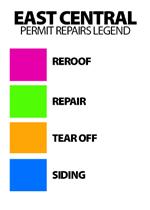










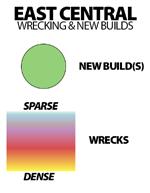
The long-term trend predates 1985. Analysis of earlier data from East Central shows an average of 22 to 27 demolitions per year in the fifteenyear span from 1970 to 1985, which is the earliest segment in which the data was collected. These figures suggest that the neighborhood may have lost hundreds of housing units in the span of just two decades. Between 1985 and 2024, another 251 wrecking permits were filed, a portion of which included several multi-unit residential buildings in the neighborhood. The cumulative effect has been
a substantial and lasting reduction in East Central’s housing stock, limiting options for new and existing residents. East Central Forward provides a twopronged strategy in its recommendations:
• Prioritizing infill housing development on vacant lots
• Preserving and rehabilitating remaining residential structures to prevent further loss of neighborhood structures.
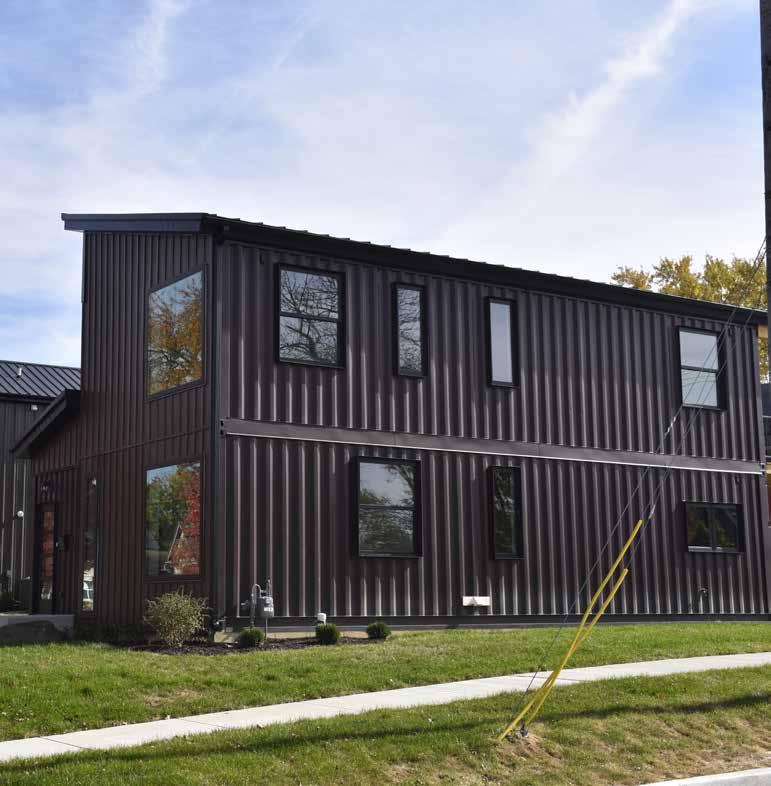





The housing market in the East Central neighborhood offers promising potential for growth and revitalization, particularly because of its affordable location near downtown Fort Wayne, the campus of Indiana Tech, and neighborhood amenities.
A housing study conducted by Zimmerman Volk Associates shows that the strongest demand is for apartments, making this housing type a key opportunity for the neighborhood. About half (52%) of people interested in moving into East Central prefer rental apartments, indicating that the area could realistically capture around 47 to 58 new apartment units each year over the next three years. Within these apartments, approximately 12 to 15 units per year could serve workforce renters— those earning moderate incomes between 60% and 80% of the Area Median Income (AMI)—with monthly rents averaging about $1,097 for units around 739 square feet. The remaining 35 to 43 apartments annually would appeal to renters who can pay market-rate rents of approximately $1,292 per month for slightly larger units around 852 square feet.
While apartments represent the largest segment of potential new residents, there is also meaningful demand for single-family homes. Roughly 28% of potential movers prefer traditional detached houses, translating into an opportunity for East Central to add about 5 to 10 houses per year. Within this group, 2 to 4 homes annually could be affordable to workforce buyers (earning 60% to 100% AMI), priced around $214,000 for modestsized homes of about 885 square feet. Marketrate buyers (above the median income level) could purchase larger homes averaging around 1,229 square feet for about $369,800. Additionally, smaller segments of homebuyers show interest in townhouses and condominiums, which offer another way for East Central to diversify housing options and attract different types of households, such as younger couples or retirees who prefer less maintenance.
Historically, East Central faced challenges with declining home values and fewer owner-occupied homes, largely due to decades of disinvestment and demographic shifts. Between 1960 and 1980, the neighborhood lost significant numbers of housing units, leaving vacant lots and abandoned properties that decreased overall property values and slowed housing market activity. However, recent decades have seen gradual improvement, with median home values steadily rising again—now representing about half of the citywide median. Even with these improvements, East Central remains one of the more affordable neighborhoods close to downtown Fort Wayne, which positions it attractively for residents seeking affordability along with urban convenience.
By focusing on increasing the availability of both affordable and market-rate housing, East Central Forward aims to build on this momentum. Prioritizing strategic investments in housing rehabilitation, community improvements, and neighborhood amenities can significantly improve livability and neighborhood pride. These efforts will help East Central attract new residents while providing longterm stability and improved quality of life for those already living there.
As of 2024, the Area Median Income for Fort Wayne is $88,000 for a family of four. This figure is established by the U.S. Department of Housing and Urban Development (HUD) and is used to determine eligibility for various housing assistance programs. Income limits are adjusted based on household size.
These income limits are critical for determining eligibility for affordable housing programs, such as those targeting households earning up to 80% of the AMI. For instance, a single individual earning up to $49,300 or a four-person household earning up to $70,400 would fall within the 80% AMI bracket.
It's important to note that these figures are subject to annual adjustments based on economic factors and housing costs in the area.
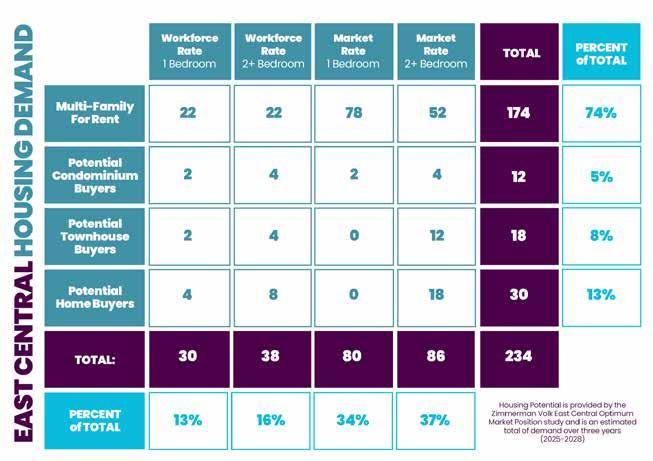





Washington Boulevard: Washington Boulevard serves as a critical connector, linking residents from Fort Wayne’s east side and nearby New Haven into the downtown. Within the East Central Neighborhood, Washington Boulevard bisects the Indiana Tech campus, where the installation of pedestrian crosswalks and signage has improved connectivity for students moving between dormitories, classrooms, and activity centers. Washington begins with approximately 15,128 vehicles per day and gradually increases to 19,200 vehicles per day before it enters downtown.


The East Central Neighborhood occupies a unique location at the intersection of two distinct street patterns: the historic downtown grid and the broader residential layout defining much of Fort Wayne’s neighborhoods. Two primary east-west arterial corridors, Washington and Jefferson Boulevards, channel significant daily commuter traffic, bringing thousands of vehicles into and through the downtown area. Meanwhile, Lafayette Street and Anthony Boulevard, which frame the neighborhood, function as barriers separating residents from nearby amenities and destinations. The scale and intensity of these major thoroughfares, typically accommodating two to four lanes in each direction, create conditions incompatible with pedestrian travel but cannot practically be modified.
Jefferson Boulevard & Maumee Avenue: Jefferson Boulevard and Maumee Avenue function as vital gateways into the East Central Neighborhood, accommodating approximately 18,745 vehicles per day. As vehicles turn onto Clay and Hanna Streets further east, traffic volume decreases slightly, averaging 15,431 vehicles per day and declining further to 14,816 per day near the Indiana Tech campus and its intersection with Anthony Boulevard.
Over the years, several infrastructure improvements have enhanced safety along this corridor. One of the most significant changes occurred in the late 1960s, when Jefferson Boulevard and Maumee Avenue were realigned near Division Street. This adjustment created a smoother intersection, reducing traffic congestion and improving overall safety. Additional modifications at Maumee Avenue and King Street were made as part of a major $1.2 million realignment project in 2016. This initiative, designed to mitigate a decade-long pattern of traffic accidents, transformed the King Street intersection into a greenspace, significantly enhancing safety for motorists and pedestrians.
However, the character of Washington Boulevard shifts at its intersection with Hanna Street, where the roadway expands from three to four lanes, enabling higher vehicle speeds as traffic flows into downtown. The extra-wide lane north of this intersection, primarily used by large vehicles accessing nearby industrial properties, presents an opportunity for future traffic-calming measures to improve pedestrian and cyclist safety.
Lafayette Street: Lafayette Street serves as the neighborhood’s primary northbound thoroughfare, carrying traffic from the city’s south side through downtown and beyond. As part of U.S. Route 27, Lafayette Street experiences consistently heavy traffic, particularly at its intersections with Jefferson Boulevard and Washington Boulevard. Traffic volume increases significantly along this stretch, rising from approximately 20,475 vehicles per day to over 27,750 vehicles per day at peak points. As travelers turn into downtown Fort Wayne, vehicle volumes slowly decrease to 21,207 before crossing the St Mary’s River and entering the Spy Run Neighborhood.
The East Central Neighborhood is defined by a mix of major thoroughfares and smaller residential streets. While the neighborhood has major throughfares discussed above, it also features several locally significant corridors that serve both residents and commuters.
Clay Street: Clay Street runs parallel to Lafayette Street and serves as a key corridor within the neighborhood. It begins at Columbia Avenue near the Maumee River, carrying approximately 15,784 vehicles per day. Traffic levels decline slightly to 10,007 vehicles per day by the time it intersects with Berry Street, the first westbound street leading into
downtown. With less than 2,000 vehicles per day turning from Main onto Clay Street, the majority of the traffic using Clay Street originates from the nearby Northside neighborhood. Traffic continues to disperse further south, with daily counts dropping from 6,500 vehicles at Washington Boulevard to just 2,300 vehicles at Jefferson Boulevard. South of Lewis Street, Clay Street transitions into a local neighborhood street, with fewer than 1,000 vehicles per day.
Hanna Street: Hanna Street serves as a key northsouth connector between Downtown Fort Wayne and Southeast Fort Wayne. It provides access to significant community institutions, including the Fort Wayne Urban League and the Pontiac Branch of the Allen County Public Library. A new multipurpose trail, scheduled for construction in 2025, will enhance connectivity by linking the corridor to the broader regional trail network. Hanna Street experiences its highest traffic volumes in the southern portion of the neighborhood, with approximately 4,500 vehicles per day near Hayden Street. Traffic decreases steadily moving northward, with fewer than 1,000 vehicles per day at the intersection of Berry Street. The busiest segment of Hanna Street in the East Central Neighborhood is between Hayden Street and Lewis Street.
Lewis Street: Lewis Street functions as an east-west neighborhood connector, linking downtown assets such as the Anthis Career Center and the U.S. Post Office to the heart of the neighborhood. The corridor also passes key community destinations, including Hanna Homestead Park, the Jennings Center, and Charles C. Anderson American Legion Post 148. The section of Lewis Street between Lafayette Street and Hanna Street sees approximately 3,258 vehicles per day, before dropping to fewer than 2,383 vehicles per day beyond Harmar Street. Notably, the widest portion of Lewis Street, located near its intersection with Anthony Boulevard, experiences the lowest traffic volumes, with an average of approximately 1,500 vehicles per day.
These traffic patterns highlight the dual role of East Central’s corridors—serving both as vital connections to surrounding areas and as local streets that support neighborhood activity. Future infrastructure improvements, including planned multi-modal enhancements and pedestrian-level street lighting will further balance mobility needs and reinforce the neighborhood’s residential character.
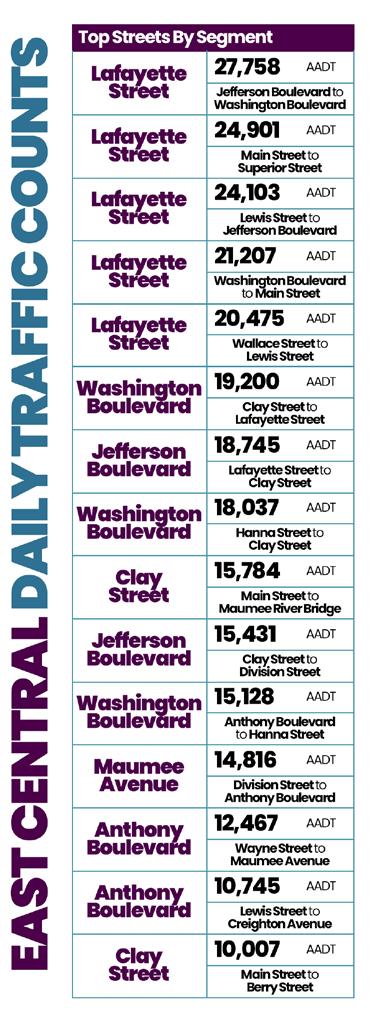




Traffic conditions in the East Central Neighborhood between January 2021 and December 2024 were analyzed to identify roadway safety patterns and areas of concern. The data collected provides insight into high-risk intersections, common causes of crashes, and opportunities for improving safety infrastructure.
During the four years of the study period, a total of 1,118 crashes were recorded in the neighborhood. While crashes occurred throughout the year, certain dates stood out as peak periods for collisions:
While several factors contribute to the higher number of collisions on the listed dates, even though weather conditions appear mild on the surface, analyzing both the weather and potential human behavior patters gives a clearer picture:
• Unsafe Backing – 35 crashes
• Improper Lane Usage – 33 crashes
• Speed Too Fast for Weather Conditions – 22 crashes
• Distracted Driver – 19 crashes
• Unsafe Speed – 12 crashes
• Wrong Way on One-Way Street – 11 crashes
Factors like Following Too Closely and Unsafe Lane Movements indicate there is a clearer need for lane demarcations and driver notification about lane changes.
The manner in which crashes occur provides further insight into road safety concerns:
• Rear-End Collisions – 306 crashes


Cloudy and Overcast Conditions can reduce visibility, dull contrast on roadways and make it harder for drivers to spot other vehicles, pedestrians, or road hazards – especially in early mornings or late evenings, increasing the risk of crashes.
High Traffic and Activity Periods such as July and August are when Fort Wayne typically sees a spike in daily travel, increased bicyclists and pedestrians.
Driver Complacency on mild or perfect weather days in the Midwest tends to see human-related factors increase. Driver behavior is critical to ensure safe roads for all, and when the weather seems to be ideal, drivers may unconsciously let their guard down, becoming less alert or responsive, which aligns closely with the primary factors to crashes occurring in the neighborhood.
Understanding the causes of crashes is key to implementing effective safety measures. The most common contributing factors were:
• Following Too Closely – 256 crashes
• Disregarding Signals/Regulatory Signs – 192 crashes
• Unsafe Lane Movement – 135 crashes
• Failure to Yield Right of Way – 119 crashes
• Failure to Maintain Lane – 89 crashes
• Improper Turning – 84 crashes
• Right-Angle (T-Bone) Collisions – 251 crashes
• Same Direction Sideswipe – 234 crashes
• Left Turn Collisions – 106 crashes
• Ran Off Road Incidents – 81 crashes
• Opposite Direction Sideswipe – 16 crashes
• Head On Collision – 9 crashes
• Collision with Object in Road – 6 crashes
What is evident is that issues such as Rear-End Collisions and Same Direction Sideswipe, which make up a majority of crashes, indicate issues with distracted driving, inadequate following distance, and improper lane changes. These challenges could be reduced with effective traffic calming measures.
While most crashes resulted in no injuries, a significant number led to minor or serious injuries, and two resulted in a fatality:
• No Injury (Severity 0) – 919 crashes (82%)
• Minor Injuries (Severity 1) – 100 crashes (8.9%)
• Moderate Injuries (Severity 2) – 55 crashes (4.9%)
• Serious Injuries (Severity 3) – 42 crashes (3.4%)
• Fatal Crashes (Severity 4) – 2 crashes
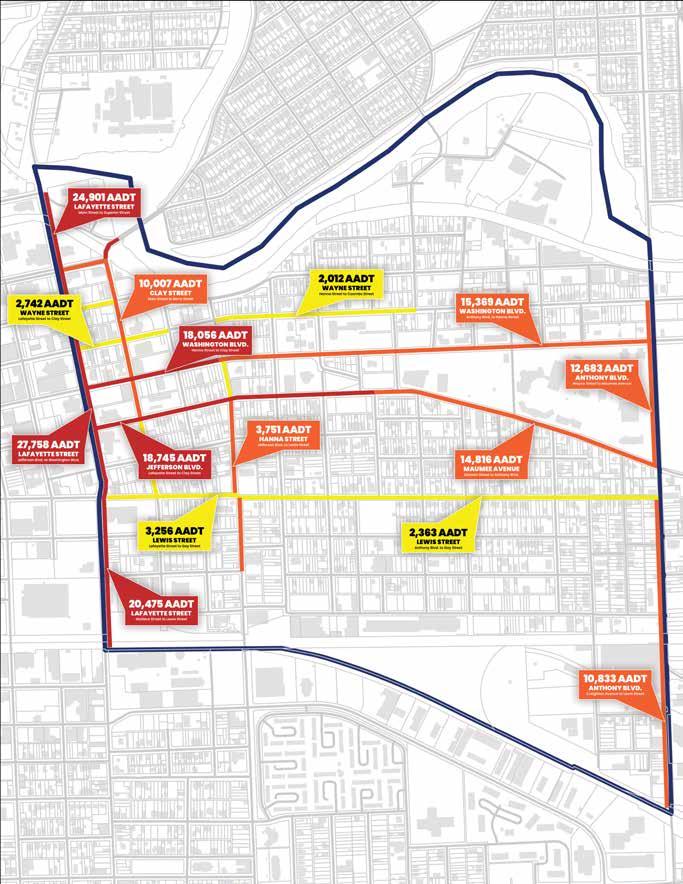







Most crashes also resulted in property damage. With 42 severe injury crashes, there is a need to support interventions that mitigate severe outcomes.
Investing in infrastructure such as clearer road signage, enhanced lane markings, and well-lit intersections will assist in reducing the likelihood of collisions in East Central. Specific attention should be paid to intersections identified as high-risk by improving visibility and reducing confusion to enhance overall safety.
Implementing a focused education campaign, highlighting the dangers of tailgating, failing to obey traffic signals, and distracted driving can significantly impact driver behavior. Additionally, increased enforcement through targeted policing efforts at high-risk
intersections and peak times may encourage safer driving habits.
Peak-Risk Months Interventions
Recognizing that East Central experiences higher crash frequencies in July and August, taking proactive measures such as increased law enforcement presence, targeted public safety messaging, and temporary signage and speed radars during these months could assist in mitigating risks in the neighborhood.
Establishing a continuous review process for crash data ensures the effectiveness of implemented safety interventions. By regularly monitoring this data, adjustments and improvements to existing strategies can be made, ensuring increased road safety throughout East Central.
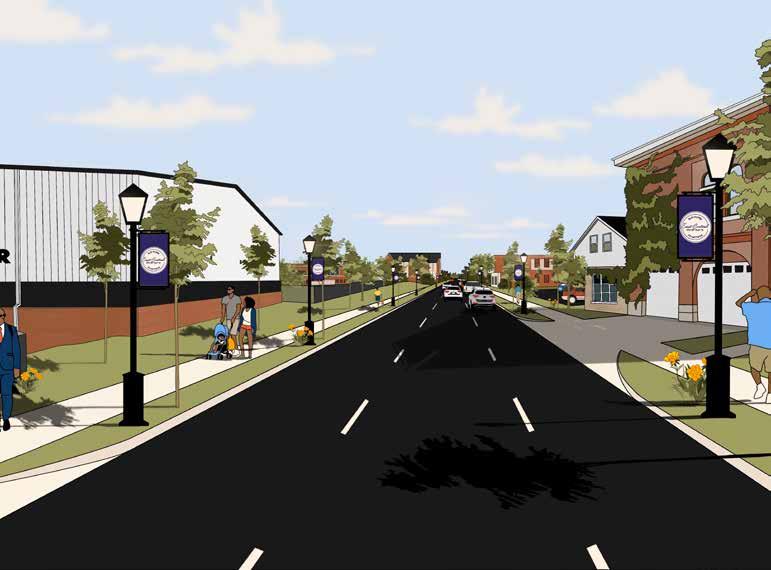





Parks and open spaces are vital public infrastructure that promote health, safety and recreation in neighborhoods. In East Central, these spaces are deeply valued and serve as anchors for identity, community social cohesion, and access to open green space.
The 2024 City of Fort Wayne Park System Comprehensive Plan identifies East Central as an “Equity Investment Zone” which works to prioritize reinvestment in neighborhoods most affected by systemic disparities by layering health, environmental, and social data to see where improvements can have the greatest positive impact. Investments in open space also plays a key role in public safety. In neighborhoods where perceptions of crime and insecurity persist, highquality parks, with good visibility and adequate lighting can help deter crime and encourage social connectivity between neighbors.
Today, the East Central neighborhood features five public parks and community spaces totaling 4.19 acres. The largest of the parks is Hanna Homestead, situated in the middle of the neighborhood.Notably, even with Hanna Homestead at its core, East Central still falls below the recommended levels of parks as outlined in the City of Fort Wayne Park System Comprehensive Plan, as the remainder of the neighborhood’s park spaces are small and unevenly distributed across the neighborhood.
Hanna Homestead Park: This 2.54-acre park is centrally located in East Central and holds a lot of significance in the community. A master plan completed in 2024 through a neighborhooddriven process proposes improvements to the park including new playground equipment, enhanced pathways, and a much larger community pavilion.
Albert G. Jennings Center: A cornerstone of East Central since 1948, the Jennings Center offers athletic programs, seasonal events, educational activities, and arts programming for all age groups. It continues to be a key recreational and cultural institution in the East Central neighborhood.
Brackenridge Playground: Located at the
intersection of Brackenridge and Monroe Streets, this compact neighborhood park is 0.38 acres and provides a small basketball court and playset for neighborhood youth. The park was added to the system in 1970.
Nuckols Memorial Park: A small 0.93-acre greenspace located between the busy streets of Jefferson and Washington, Nuckols is one of Fort Wayne’s oldest parks. Originally acquired in 1876 and called Hayden Park, the site was renamed in 1986 to honor Fort Wayne’s first Black City Councilman who represented the neighborhood.
Summit Street Block Park: On the eastern edge of East Central, the Summit Street Block Park is a small 0.34-acre play space for children and was added to the system in 1976 as an outcome of the 1975 East Central planning effort.
East Central Park: Located on Coombs Street at the northern boundary of the neighborhood, is not included in the current inventory of active park spaces due to its uncertain status and undefined future use. Originally dedicated in 1978, the park historically served as a community-oriented green space along the Maumee River. However, it has always been separated from the bulk of the neighborhood by the railroad overpass. While the East Central Forward neighborhood plan does not propose specific improvements for East Central Park at this time, it does recommend targeted pedestrian infrastructure along Coombs Street. These improvements aim to create safer, more accessible connections to Lakeside Park in the adjacent Northside Neighborhood – expanding park access to East Central residents north of Wayne Street - as well as increasing safety for children and families walking to the nearby Forest Park Elementary School.
While often viewed primarily as recreational amenities, parks function as essential public health infrastructure. They provide safe, accessible spaces for physical activity, social interaction, and access to nature– each an important factor in reducing chronic disease, improving emotional well-being, and strengthening community relationships. In neighborhoods like East Central where many residents have limited mobility and transportation access, the presence of these small, walkable parks is especially critical. These spaces serve as vital touchpoints for daily health and wellness, ensuring that residents can benefit from proximity to nature and open spaces.
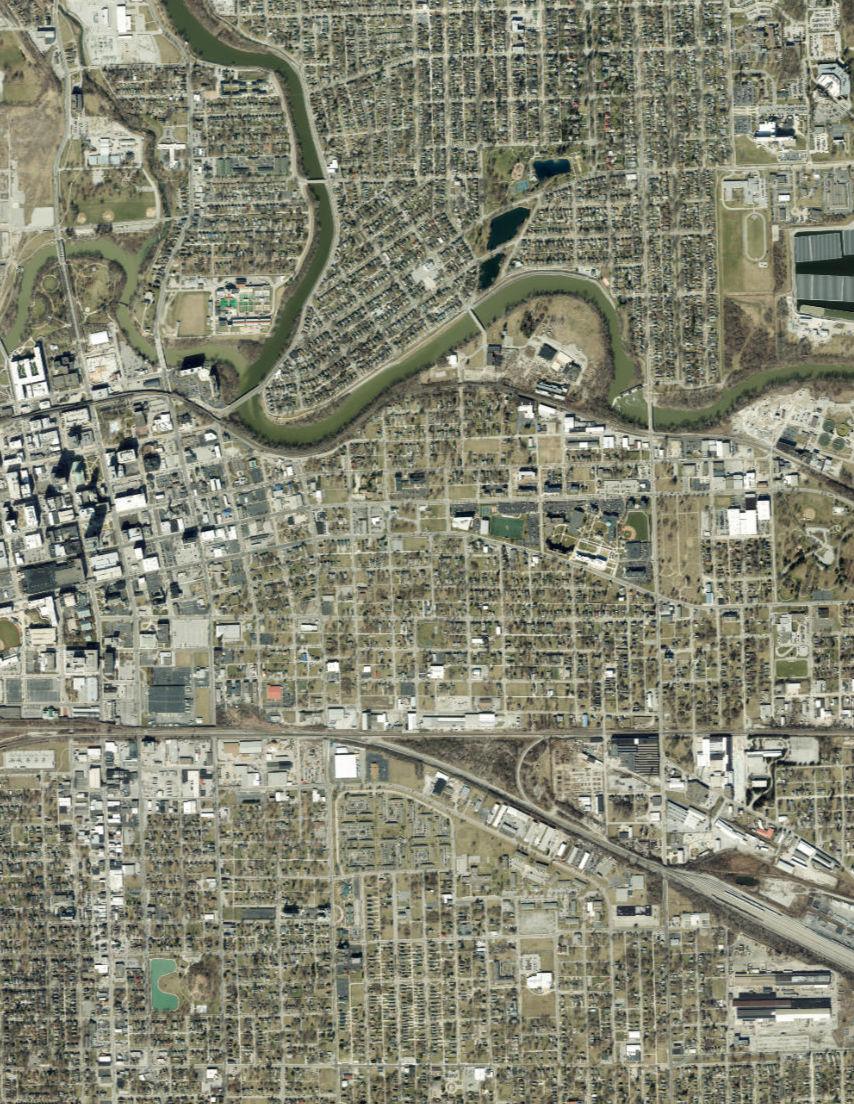
BRACKENRIDGE STREET BLOCK PARK
EAST CENTRAL PARK WALKSHED LEGEND PARK
REACHABLE IN A 5-MINUTE WALK
REACHABLE IN A 10-MINUTE WALK
JENNINGS CENTER




As East Central looks toward the future, strategic investment in parks and community centers represents a direct investment in the wellbeing and quality of life of its residents. These spaces serve critical functions—from providing safe, accessible environments for children to play to offering opportunities for older adults to engage in social and recreational activities. Planned improvements to Hanna Homestead
Park, and continued programming at the Albert G. Jennings Community Center will support public health, encourage connection, and reinforce the neighborhood’s identity, making a safer neighborhood for all. Prioritizing enhancements that reflect resident input and support community values ensures that these spaces continue to serve as vital assets in East Central’s long-term stability and growth.


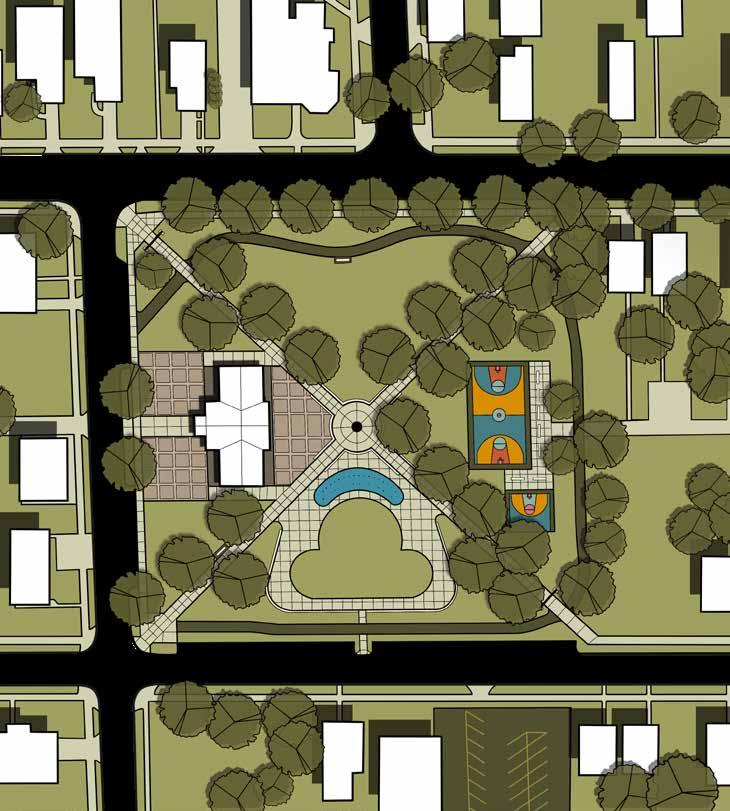
The overall crime rate in East Central is trending slightly upward, with 2024 being the highest crime has been since 2010. Even when adjusted for the change in how aggravated assaults are categorized, which added roughly 10 instances to the overall totals, 2024 crime is still 37% higher than the previous 10-year average and 24% higher than the average rate since the pandemic. The last time that crime in East Central was so high was in the period from 2012-2013, which was also a peak crime period for Fort Wayne overall. In general, aside from the peak in 2024, East Central crime trends mirror overall city trends.
Violent crime in East Central is trending just slightly upward, mostly due to a peak in 2024. Violent crime accounts for the instances of: homicide, aggravated assault, rape, and robbery.
The graph shows that before 2024, violent crime was trending neither upward nor downward, with slight changes year to year but an overall average of about 25 instances per year. The year 2024 appears to be a spike in violent crime, increasing to 41 instances, however, if the change in how
aggravated assaults are categorized is adjusted for by reducing the total by roughly 10 counts to 31 instances, the crime rate remains within the range of normal variation for the area. The explanation of how the counting of aggravated assault has changed is explained in more detail below.
The rates of homicide in East Central vary greatly, with some years peaking as high as 4 or 5 events (in 2013 and 2018), or as low as 0 instances in many years. 2024 saw 2 homicides in the neighborhood.
Aside from the change in how aggravated assaults are measured creating a dramatic increase in 2024, the number of aggravated assaults is relatively stable, ranging between 9 to 15 instances most years.
The numbers for aggravated assault appear to rise dramatically in 2024 versus previous years. However, this increase is due to a change in how agravated assault is classified, and not an increase in the crime rate itself. Previously, aggravated assault included assaults on a person that included a weapon. Beginning in 2024, the FBI defined aggravated assault as instances of someone pointing a gun at someone threateningly and any time a bullet is shot into a home that is occupied; for example, if a bullet enters a home and four people are inside, this is counted as four aggravated assault. Thus, though this jump in 2024 looks alarming, it is actually a matter of statistics rather than an actual increase in crime.





The rates of reported rape in East Central have stayed relatively steady, ranging from between 0 to 6 instances in a given year and fluctuating over the past 10 years. The National Crime Victimization Survey conducted by the Bureau of Justice Statistics reports that rape is reported less to law enforcement than any other type of crime, with an estimated 21-46% of rapes being reported to law enforcement in 2022 and 2023.
The number of robberies in East Central has stayed mostly steady from 2010-2014. Robberies peaked in both 2012 and 2022 with 16 robberies, and decreased to 12 in 2023 and 10 in 2024. The overall average since 2010 has been 10 robberies per year, the same number experienced in 2024.
The overall peak in crime is primarily made up of an increase in nonviolent crimes. Nonviolent crimes account for: arson, burglary, larceny, vehicular theft, and human trafficking. The nonviolent crime rate in East Central has not been so high as it was in 2024 since 2013, and the 2024 rate is a 27% increase from the average rate since the pandemic and a 39% increase from the previous ten-year average. The increase is primarily due to an increase in larceny, with a smaller increase in burglary.
The rate of burglary in East Central has been decreasing since 2010. The highest rate occurred in 2013, with 42 instances, and in 2015 with 37 instances. In comparison 2023 had only 6 burglaries. There were 19 burglaries in 2024, which is roughly the average since 2017. So, although the number of burglaries increased from 2023, the increase makes up only a portion of the nonviolent crime increase.
The rate of larceny in East Central increased dramatically in 2024. The average larceny rate since 2010 is roughly 95 instances each year. The rate increased after the pandemic, to levels comparable with the 2012 and 2013 larceny rates. Then in 2024, the number of larcenies increased to 147, the highest since 2010. The increase in numbers of larceny accounts for nearly all of the overall increase in nonviolent crime in East Central.
The rate of vehicle theft in East Central is trending upward from 2010-2024, but saw a decrease in both 2023 and 2024. The number of vehicle thefts peaked in 2019 with 19 vehicle thefts and in 2022 with 17 vehicle thefts. 2023 decreased slightly to 15
Aggravated Assault: An unlawful attack by one person upon another person for the purpose of inflicting severe or aggravated bodily injury. This type of assault usually is accompanied by the use of a weapon or by means likely to produce death or great bodily harm.
Homicide: Murder and non-negligent manslaughter: the willful killing of one human being by another.
Rape: The penetration, no matter how slight, with any body part or object, of another person, without the consent of the victim.
Robbery: The taking or attempting to take anything of value from the care, custody, or control of another person or persons by force or threat of force or violence and/or by putting the victim in fear.
Burglary: Also known as “breaking or entering,” The unlawful entry of a structure to commit a felony or a theft. Attempted forcible entry is included.
Larceny: Also known as theft, excluding motor vehicle theft, the unlawful taking, carrying, leading, or riding away of property from the possession or constructive possession of another. Examples are thefts of bicycles, motor vehicle parts and accessories, shoplifting, pickpocketing, or the stealing of any property or article that is not taken by force and violence or by fraud.
Vehicular Theft: The theft or attempted theft of a motor vehicle. A motor vehicle is self-propelled and runs on land surface and not on rails. Motorboats, construction equipment, airplanes, and farming equipment are specifically excluded from this category.
Arson: Any willful or malicious burning or attempt to burn, with or without intent to defraud, a dwelling house, public building, motor vehicle or aircraft, personal property of another, etc.
Human Trafficking: Includes both commercial sex acts and involuntary servitude. Inducing a person by force, fraud, or coercion to participate in commercial sex acts, or in which the person induced to perform such act(s) has not attained 18 years of age. The obtaining of a person(s) through recruitment, harboring, transportation, or provision, and subjecting such persons by force, fraud, or coercion into involuntary servitude, peonage, debt bondage, or slavery (not to include commercial sex acts).
vehicle thefts, and 2024 vehicle thefts decreased to only 11, the pre-2017 average. Thus, vehicle thefts did not contribute to the increase in nonviolent crime in East Central.
The rate of arson in East Central appears to increase since 2020, however similar to aggravated assault, this is a false increase. In 2019 the Fort Wayne Fire Department changed their metrics for reporting arson to include not only those instances in which an arrest is made, but all instances of arson to better reflect their work and the rate of arson in the city. Examples of instances when arson occurs but an arrest is not made include a juvenile fire setter or when someone is placed on a 24-hour mental health hold, and then an arrest warrant is issued later. Therefore, although the rate of arson appears to increase since 2010, those increases occur after 2019 and are likely more due to a change in how often arson is measured than how often it occurs.
There were no instances of human trafficking in East Central since 2010.
Where crime takes place in the East Central Neighborhood has shifted dramatically since
2020. Before 2020, several areas had a high concentration of crime. These included the intersections of Francis Street & Washington Boulevard, Lewis Street & Hanna Street, Weller Street and Washington Boulevard, and a cluster of intersections at Jefferson Boulevard at Monroe Street and Clay Street and Washington Boulevard at Clay Street and Lafayette Street. The distribution of crime among these areas was relatively equal, with roughly 5% of the area’s crimes.
After 2020, the spread of crime shifted dramatically. Most of the previous areas with high concentrations of crime persisted. However, these areas still made up roughly 5% of the area’s crime or less, where the intersection of Washington Boulevard and Lafayette Street now makes up 18% of the area’s crime. The vast majority of the crimes at this location were larceny, with a handful of other violent and nonviolent crimes. The area had been a concentration of crime prior to 2020, but not such a high proportion of the neighborhood’s crime.
The hot spot at Washington Boulevard & Lafeyette Street as well as the other persistent hot spots are an opportunity to use targeted investments to increase safety and security for downtown visitors and East Central residents.
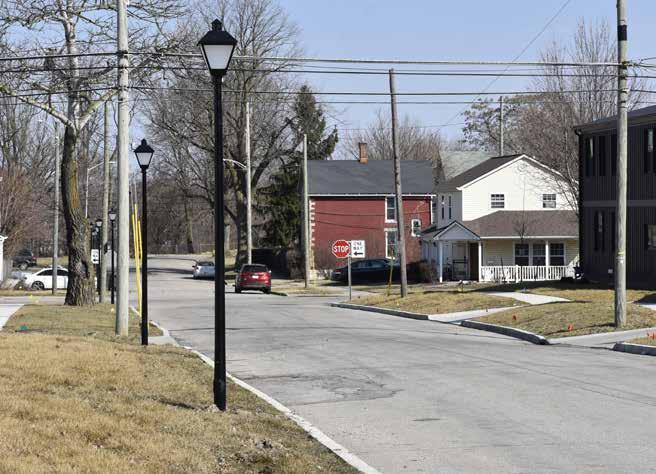



















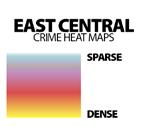



























CPTED stands for Crime Prevention through Environmental Design and is a well-studied practice of reducing crime by making changes to the built environment and increasing community connections. CPTED (pronounced “sep-ted”) was implemented in the CPTED Pilot Area on High Street in Northwest Fort Wayne. Previously one of the single highest crime rates of a single street in the city, after the investments the crime rate reduced by 54%, a reduction that has been sustained for 3 years since the implementation. Investments included pedestrian-level streetlights, new sidewalks, murals, pedestrian signage, and neighborhood signs. Now, FWPD cite that crime is the lowest on the street that it has been for 40 years.
The CPTED Pilot Area demonstrates an opportunity to reduce crime in other areas, like East Central, through design, infrastructure investments, and social connectivity.
The rise in crime provides statistical support to the concerns heard in community engagement – that safety is the highest priority of the community. The increase in crime types such as larceny demonstrates a clear need for increased safety interventions. Previous plans dating back to the 1970s also cited safety as one of the community’s primary concerns. Sucess in the CPTED Pilot Area on High Street, particularly street lighting and infrastructure improvements, demonstrates an opportunity to address safety concerns in the East Central Neighborhood through similar investments, as recommended in this plan. The East Central Forward plan is a unique opportunity to increase safety and quality of life for a historically disinvested and deeply important neighborhood.
Land Use and Zoning are both foundational to understanding an area’s development history, while also being a tool to protect both current and future developments. Land Use can be simply described as the current purpose (“use”) of a specific property (“land”). Examples of land use are “residential” which could include single-family homes, duplexes, apartments or townhomes, and “commercial” which could include anything from a flower shop or clothing store to a fast-food chain or grocery store. Land use is not necessarily a legal tool but does shape zoning. Some of the most common categories for land use descriptions include: residential, commercial, industrial (such as railroads or food processing facilities), institutional (such as schools, government, or religious uses), and recreational (such as trails or parks).
Zoning is related to Land Use, in the sense that it refers to the types of development on a site, but Zoning is a legal tool for development and regulation. Zoning is often overlaid on an area to restrict what types of uses are legally allowed to be there. For example, residential Land Use has three categories that explain what type of residential uses are allowed in the area. East Central has a large portion of the neighborhood that is zoned Residential 3 (R3), which is also referred to as “Multiple Family Residential.” According to the Zoning regulations for R3, the only allowed uses for new development are things like an assisted living facility, a common area for a neighborhood center, multiple family complex, and single-family dwelling. These uses that are allowed, are called permitted uses, and typically require minimal permitting or governmental oversight.
It is important to note that there are also other types of allowed uses in Zoning that are called special uses. Special uses require a bit more permitting and governmental processing, as they may be less appealing to a certain area or land use in comparison to other uses. For R3, a few examples of special uses are model home, museum, neighborhood facility, and funeral home. Zoning is the policing power in the planning profession, and it is equally important to make sure
that old Zones are updated to reflect current uses, and to have zones that permit uses that an area may want to attract for future development. East Central is mostly Residential and Industrial zoned, with a smaller mix of Commercial and Downtown Zonings. Some quick, non-legal Zoning descriptions are as follows:
R1
Primarily single-family homes with some housing variety. Allows home businesses and child care with approval near busier roads.
R2
Medium density for single and two-family homes, including attached units. Home businesses and some services allowed with approval, especially near main roads.
R3
Higher density housing with some professional/ personal services allowed near busier roads. Supports varied housing and buffers from heavier commercial areas.
C2 Limited Commercial
Moderate-traffic businesses including offices, retail, food, and auto services. Encourages neighborhoodfriendly uses with controlled outdoor storage.
Various businesses serving the public, including gas stations and vehicle sales. Allows outdoor display and storage near buildings.
Higher intensity commercial uses on busy roads. Outdoor displays and vehicle sales allowed. Not recommended near homes.
C3 General Commercial C4 Intensive Commercial I1 Limited Industrial
Light industrial uses like assembly, storage, and some retail/offices. Minimizes outdoor impacts and buffers heavier industrial or commercial zones.
Urban Corridor
Supports walkable commercial corridors with mixed uses, including apartments above shops. Promotes urban-style development with reduced parking and street-friendly design.






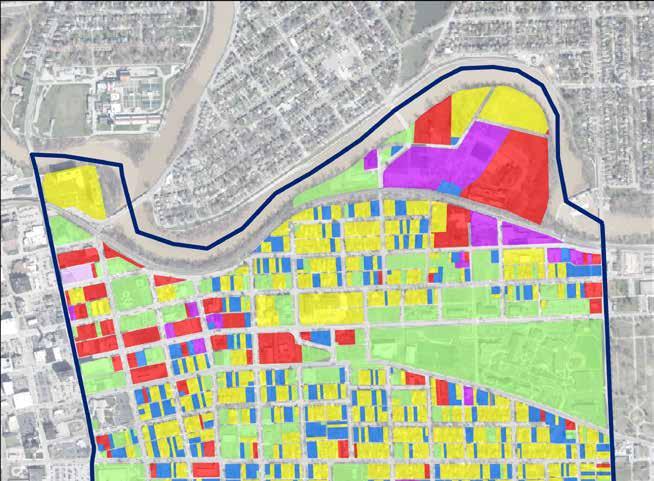
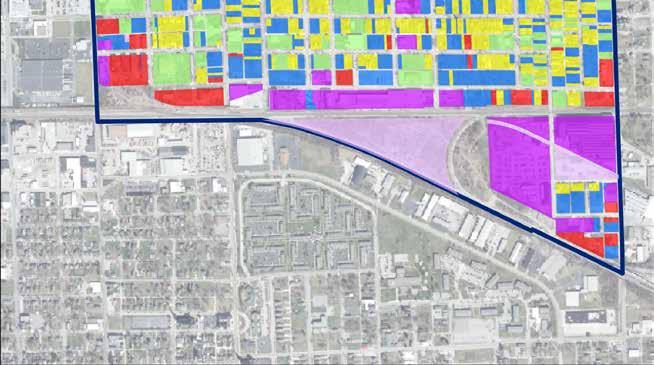
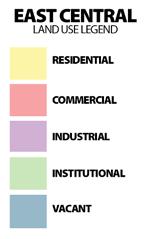
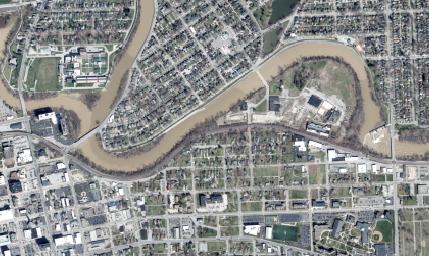
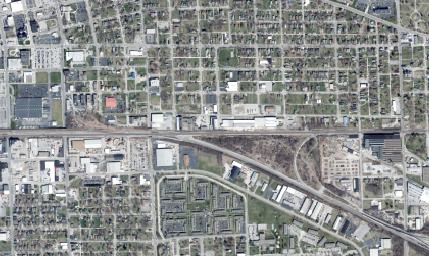
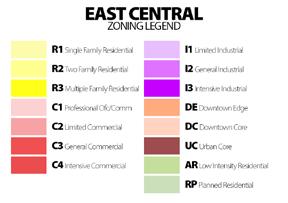





With its walkable proximity to downtown Fort Wayne and key corridors such as Lafayette Street, Washington Boulevard, and Jefferson Boulevard, East Central Neighborhood has long been positioned as a gateway between the urban core and surrounding communities. Despite this prime location, the neighborhood has faced challenges in attracting and sustaining neighborhoodserving businesses beyond a few longstanding establishments.
Most businesses that operate in East Central serve a larger regional population, including downtown employees, Indiana Tech students, and visitors commuting through the area, rather than directly catering to local residents. This trend underscores the need for strategic efforts to foster a thriving retail sector that better aligns with the needs and spending habits of East Central residents.
A key component of the East Central Forward initiative is to analyze market conditions and identify opportunities for economic growth. Data from Synergos Technologies Inc (STI), leveraging spending patterns from the Bureau of Labor Statistics, provides insights into how neighborhood residents allocate their income and where gaps exist in local retail offerings.
On average, East Central residents allocate a significant portion of their weekly income toward housing and transportation, two essential and relatively inflexible expenses. This leaves little discretionary funds available for other critical needs such as food, healthcare, and personal care services. The breakdown of average weekly expenditures for East Central residents is as follows:
This data highlights that a large proportion of spending is dedicated to necessities, reinforcing the opportunity to provide essential goods and services within the neighborhood.
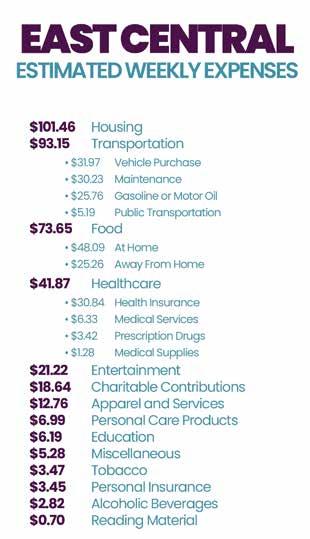
The STI Market Outlook provides an analysis of the supply-demand balance for goods and services within a 15-minute walk of the average East Central resident. Despite the presence of businesses along major corridors, significant unmet demand exists in several retail categories within the East Central Neighborhood:
• Online Shopping and Distribution: $7.47M
• Grocery Stores: $5.89M
• Electronics & Appliance Stores: $1.08M
• Bars & Drinking Establishments: $1.00M
• Clothing Stores: $812K
• Lawn & Garden Equipment/Supplies: $529K
• Sporting Goods, Hobby & Musical Stores: $469K
• Furniture Stores: $388K
• Computer Hardware, Software & Supplies: $707K
• Alcoholic Beverages Served On-Site: $610K
• Fresh Fruits & Vegetables: $400K
• Footwear & Accessories: $299K
• Fresh Meat & Poultry: $205K
• Women’s, Junior’s, & Misses Wear: $148K
• Baked Goods: $134K
• Fresh Fish & Seafood: $104K
• Business Growth Opportunities
Based on these findings, several key areas present growth potential for businesses catering to the East Central neighborhood:
Grocery & Essential Goods: While the $5.89M unmet demand for grocery stores may not attract large chains, smaller-scale markets or specialty grocers focused on fresh produce and meats could thrive.
Electronics & Appliances: Serving both residents and Indiana Tech students, an electronics store could tap into the $1.08M unmet demand, particularly for computer hardware and software ($707K unmet demand).
Entertainment & Nightlife: The $1.00M unmet demand for bars suggests potential for one or two new establishments, especially those focusing on on-site alcoholic beverage service ($610K unmet demand).
Conversely, certain retail sectors have an oversupply, indicating a lower likelihood of success for new businesses in these categories:
• Automobile Sales & Service: $20.5M oversupply
• Fast Food & Nonalcoholic Beverage Services: $7.6M oversupply
• Automotive Lubricants & Fuels: $9.7M combined oversupply
• Packaged Liquor, Wine & Beer: $3.3M oversupply
• Pharmacies & Health & Beauty Aids: $2.4M oversupply
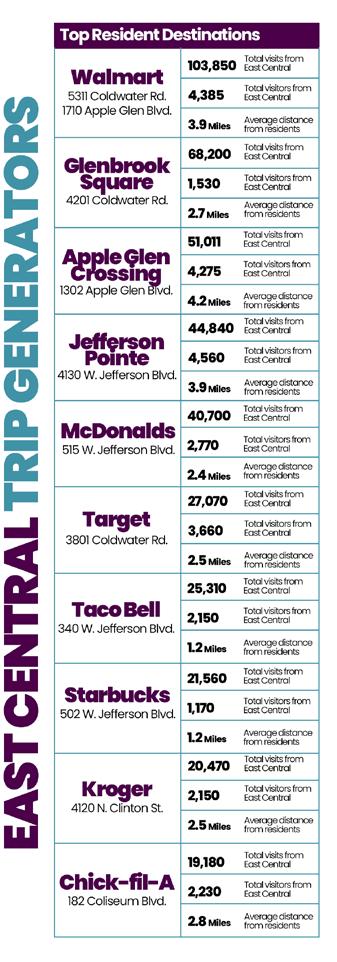





Understanding where residents travel for retail, services, and other needs provides critical insight into the economic leakage occurring at the neighborhood level, which is when spending by local residents benefit businesses located outside their immediate community. This analysis helps provide the top destinations where East Central residents most frequently visit, offering a datadriven lens into consumer behavior and opportunity areas for neighborhood reinvestment.
The top destinations by total number of visits by residents reveal a clear pattern: national retailers, chain restaurants, and regional shopping centers dominate the total resident retail experience. Walmart is the most visited location by far, among all retail locations, with over 143,000 visits, indicating a strong demand for affordable, onestop retail options. McDonalds ranks second among all Fort Wayne locations, with over 117,000 visits, showcasing high demand for quick-service food options. Other major draws outside of the East Central Neighborhood include Glenbrook Square Mall and popular grocery chains like Kroger, which reflects the need for diverse retail experiences and everyday essentials. Starbucks is one of the top ten destinations, hinting at resident interest in accessible cafe and gathering space experiences.
These patterns underscore the fact that many residents regularly leave the neighborhood to meet basic shopping and dining needs. While some travel is expected, the frequency and volume of visits to external destinations point to a gap in local amenities that could otherwise be filled by businesses within the East Central neighborhood.
The leakage of consumer activity represents an opportunity: by attracting and supporting businesses that meet these demonstrated needs – such as quick-service dining, limited retail, and community gathering spaces – the neighborhood can reduce economic outflow, create jobs, and enhance the day-to-day quality of life for residents in East Central.
Potential economic development considerations should include:
• An effort to recruit or incubate businesses aligned with high-demand categories
• Repurpose vacant or underutilized commercial properties
• Encourage mixed-use development that combines much needed housing with neighborhood-serving retail
• Enhance pedestrian access to local commercial corridors
• Increase safety for pedestrians from the neighborhood to downtown Fort Wayne
The East Central Neighborhood faces significant challenges in accessing nutritious and affordable food. Despite the presence of resources like the Pontiac Street Market, Johnnie Mae Farm and Miss Virginia’s Food Pantry, according to the health and wellbeing data, East Central residents continue to experience food insecurity due to factors such as transportation barriers, limited awareness, and economic constraints.
Developing a Food Access Network in East Central is important in order to meet the immediate needs of neighborhood residents, while fostering longterm resilience and improving health outcomes.
Recommendations to improve food security include:
• Developing a partnership with CTN or Citilink and local organizations to establish a food access loop shuttle connecting East Central, Memorial Park and other nearby neighborhoods to the existing neighborhood food resources, such as the Pontiac Street Market, Miss Virginia’s Food Pantry, and Johnnie Mae Farm on key days of the week.
• Expanding outreach to promote Pontiac Street Market’s free grocery delivery service to neighborhood residents. The service that could have a significant benefit for neighborhood residents, especially those with mobility challenges or limited transportation options.
• Develop a joint food literacy program hosted across all three sites building on their various strengths – for example, at Johnnie Mae Farm, residents could gain access to an urban farm and gardening workshop as well as food preparation courses, and at Pontiac Street Market, residents are encouraged to learn more about the foods they consume.
• Establish a formal coalition or working group of food providers in East Central such as faithbased institutions, health providers, and the
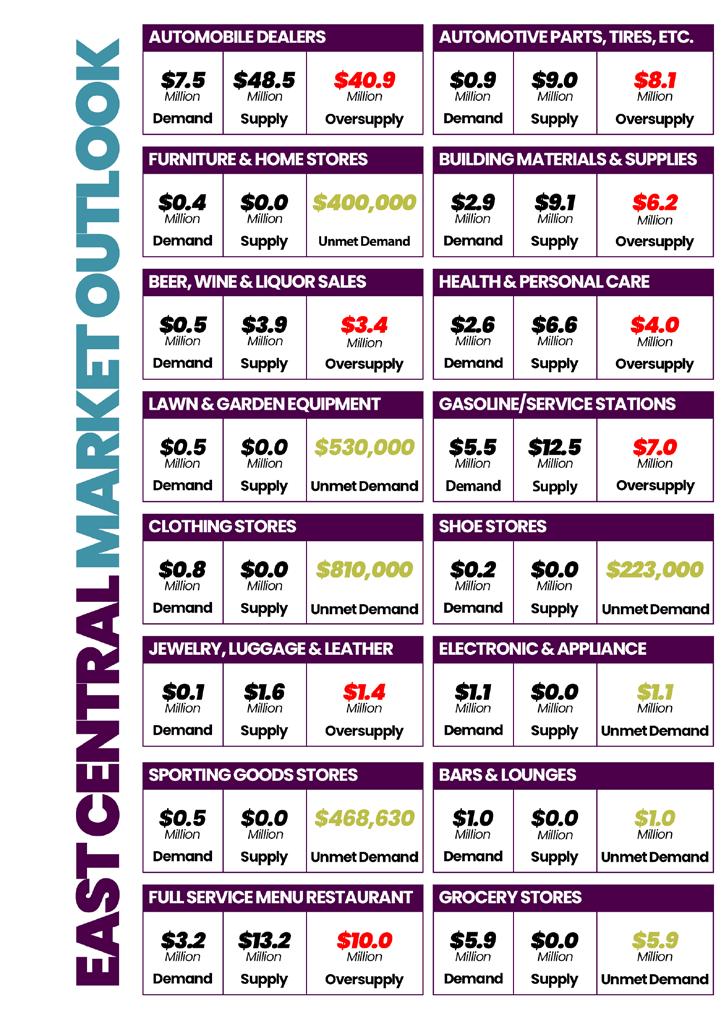

three existing neighborhood food resources to share data, coordinate outreach and align programming.


• Launch a shared digital and print communication campaign in English and Spanish highlighting available food access points, delivery options, and wellness resources for residents of the neighborhood.


• Expand programming offered at the Pontiac Street Market to meet the needs of residents in the East Central Neighborhood, and consider hosting mobile events at neighborhood parks, the Jennings Center, Indiana Tech, and Miss Virginia’s Food Pantry to help increase engagement and awareness.
Food Pantry plays a pivotal role in addressing food insecurity in the neighborhood. Located on South Hanna Street, the pantry operates from the historic home of its founder, Miss Virginia Schrantz, who dedicated most of her life to serving the community. The pantry’s food programs ensure that each household receives a well-rounded selection of food items which addresses the dietary needs of residents in the neighborhood. Operating solely on donations and the efforts of volunteers, Miss Virginia’s Food Pantry serves hundreds of families each week.


• Improve or add bus shelter locations along Citilink Routes 4, 7, and 10 to provide better access to food resources and destinations.


• Work with Miss Virginia’s Food Pantry to serve as a hub for healthy lifestyle education, to offer demonstrations, develop healthy recipes, or host community health fairs to advance the health equity goals in East Central Forward.
• Explore opportunities for shared grant writing or collective fundraising to stabilize and grow the food network.
• Celebrate the story of Miss Virginia Schrantz and the pantry’s history in the neighborhood, bringing awareness of the facility and building a broader culture of food security and health.
The Pontiac Street Market
Located just a mile away from the core of East Central, Pontiac Street Market, a partnership between the City of Fort Wayne and Sodexo/ Parkview Health, was designed to help increase grocery access and address food insecurity in Fort Wayne’s southeast quadrant, including the East Central Neighborhood. Despite its proximity to the neighborhood, resident utilization of the store remains low.
While the STI Market Outlook (15-minute walkshed) notes there is opportunity for a grocery outlet in the neighborhood, the estimated $5.89 Million in unmet demand may not be enough to sufficiently support a grocery exclusively for the neighborhood. Instead, East Central should look at opportunities to engage and partner with the Pontiac Street Market to enhance food access for residents.
While not a traditional grocery store, Miss Virginia’s
Located in the nearby Renaissance Pointe neighborhood, Johnnie Mae Farm is a communitydriven urban agriculture initiative, established through a collaboration between the City of Fort Wayne and Purdue Extension. The farm plants and cultivates a variety of vegetables and herbs and sells produce through local outlets, including Pontiac Street Market. Beyond agriculture, Johnnie Mae Farm serves as a gathering place for neighbors and has often hosted events and workshops.
The economic and retail data for East Central Neighborhood underscores both challenges and opportunities for local business development. While regional businesses leverage the neighborhood’s location along major corridors, the specific needs of residents remain underserved in key areas such as grocery, electronics, and entertainment. Addressing these gaps with targeted retail investments, coupled with infrastructure improvements that enhance walkability and accessibility, will be essential for fostering a more vibrant and self-sustaining local economy.
• Encourage small business growth in identified high-demand sectors.
• Explore incentives to attract grocery and essential goods providers.
• Leverage mixed-use development to integrate housing and commercial uses.
• Strengthen pedestrian-friendly design to enhance accessibility to retail hubs.
By implementing these strategies, East Central can work toward a more resilient and dynamic economic future that better serves both residents and the broader community.
Throughout the East Central Forward planning process, conducted from 2023 to 2025, several strengths and challenges were identified through extensive community engagement, data-driven analysis of existing conditions, and an in-depth review of the East Central neighborhood’s historical context as the oldest residential neighborhood since Fort Wayne’s founding. Recognizing strengths, such as a resilient community spirit, active local organizations, proximity to downtown Fort Wayne, and strong local institutions such as Indiana Tech, highlight assets upon which future improvements to the neighborhood can be built. At the same time, clearly identified challenges, including ongoing concerns about safety, limited access to quality housing and infrastructure, chronic health disparities, and issues related to homelessness provide clarity on barriers that must be addressed. Documenting these strengths and challenges is a critical step in developing strategic recommendations and fostering meaningful partnerships for the development of East Central Forward and developing a strong future for the community.
The East Central neighborhood is home to a rich history that anchors the identity of the neighborhood while building a strong sense of pride among residents. Historically, East Central has served as the vital hub for Fort Wayne’s Black community and immigrant populations. These cultural influences are embedded in the neighborhood’s numerous churches, landmarks, the Albert G. Jennings Community Center, and longstanding local businesses. Preserving this legacy through historic site restoration and recognition, public art installations, and storytelling initiatives offers opportunities not only for
community cohesion among residents, but also for economic development through cultural and heritage-based investments.
East Central’s location, adjacent to the fastgrowing downtown Fort Wayne, its proximity to Indiana Tech, and access to major corridors position the neighborhood as a prime area for thoughtful development that can benefit the community. The neighborhood has many vacant and underutilized parcels, presenting both a challenge and powerful opportunity. Targeted infill development, new affordable and mixed-income housing, and neighborhood-scale commercial and retail growth can help revitalize these vacant spaces and reintegrate them into the fabric of East Central. East Central’s development potential can support economic growth that benefits longterm residents while attracting new investment.
Throughout its history since being founded in 1964, the residents of East Central consistently demonstrate a strong commitment to their neighborhood’s future. Community members actively participated in planning events, listening tours, focus groups, and open houses. More importantly, residents provided constructive feedback and visioning ideas that help shaped the recommendations in the plan, ensuring that ideas shared would benefit the neighborhood as a whole. This level of engagement not only reflects the pride of place, but also an understanding of the power of a shared voice. Civic participation ensures that plans best reflect the community, builds trust between residents and decision-makers, and creates momentum and accountability for implementing improvements that are residentdriven.





East Central boasts several long-standing community institutions such as the Albert G. Jennings Community Center on McCulloch Street, the East Wayne Center, and Indiana Tech, in addition to over a dozen churches. These places are more than just buildings, they offer essential programming, including youth development, athletic and recreational activities, senior services, education and support cultural events. They help bring people together across generational divides, support vulnerable populations, and offer safe and accessible gathering spaces for residents to meet and celebrate.


Unlike other neighborhoods in Fort Wayne, East Central has several leading philanthropic and institutional actors located within its boundaries. Foundations such as the Foellinger Foundation and the Community Foundation of Greater Fort Wayne have supported neighborhood-focused events, facilitated strategic planning efforts, and offered support through various local initiatives. Similarly, Indiana Tech and other non-profit organizations like the East Wayne Street Center have provided space, capacity-building resources, and programmatic support. These partnerships are critical to developing a strong foundation for collaborative problem solving and long-term neighborhood resilience.


Over the past three decades, East Central has become one of Fort Wayne’s most demographically diverse neighborhoods. Most notably, since 1990, the Hispanic Population of East Central has grown nearly 300%, contributing new cultural perspectives and entrepreneurship to the community. This growing diversity adds to the neighborhood’s historic cultural position and provides an important opportunity for members of the community to celebrate together through events, education, and inclusive and welcoming public spaces. Supporting language access, culturally relevant services to all residents, and representative leadership in the neighborhood can further strengthen bonds and enhance social capital within East Central.
Throughout the East Central Forward planning process, neighborhood leaders have demonstrated their commitment to shaping the future of East Central. Residents have taken active roles in the planning committee, participated in the City of Fort Wayne’s FORTify Neighborhood Accelerator, initiated block-level conversations around housing, safety and infrastructure, and worked closely with Mayor Sharon Tucker and Councilman Geoff Paddock in advocating for neighborhood improvements. This has helped guide investment, uplift community voices, and ensure a stronger connection between the City and neighborhood
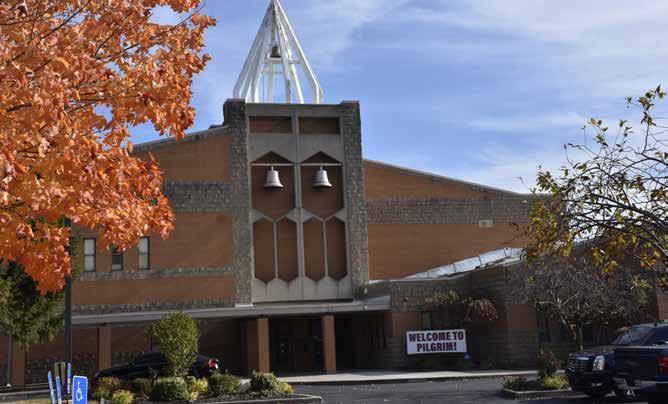
Pilgram Baptist Church
needs. These efforts reflect decades of strong civic engagement that is central to ensuring neighborhood revitalization meets the needs of neighborhood residents.
East Central has experienced one of the most significant population declines in Fort Wayne. From a high of approximately 10,630 residents in 1960, to just 2,410 in 2020, the neighborhood has lost over 77% of its population in six decades. This steep decline has left lasting impacts on the neighborhood’s social and physical fabric. The loss of population reduced school enrollment, leading to the closure of Harmar and McCulloch elementary schools; weakened demand for local services and retail; and contributed to widespread housing vacancy and abandonment, which would ultimately lead to vacant lots. This loss of population also strained community identity and continuity, as long-time residents have either aged in place or relocated to other neighborhoods, and fewer families with children have moved in to replace them. Stabilizing and attracting new residents will be an essential measure for the long-term vitality and sustainability of East Central in the years to come.
One of the most pressing challenges facing East Central is decades of persistent economic hardship. In 2020, the median household income in the East Central planning area was just $41,236, which was 65% of the citywide median of $63,607. More critically, the poverty rate reached 42.2%, nearly triple the city average, placing East Central in the category of a persistent poverty neighborhood as defined by the U.S. Census Bureau. These economic conditions have compounded over the decades due to structural disinvestment, the legacy of racial redlining, and loss of local employment opportunities. High poverty levels often limit residents’ ability to maintain their homes, support local businesses, or invest their own resources into their neighborhood, creating a cycle that reinforces disinvestment. Meaningful and inclusive economic development that benefits the neighborhood must be a priority to address the longstanding issues with poverty in the neighborhood.
Residents of East Central consistently reported that safety was a top concern. Specific issues identified include poorly lit streets, deteriorated sidewalks, poorly maintained alleys, and well-known crime spots such as the intersection of South Hanna and East Lewis Streets. During neighborhood walks, and stakeholder engagement residents described a sense of vulnerability, particularly in areas with high vacancy rates or low visibility due to inadequate lighting. These perceptions discourage outdoor activity, which undermine neighborhood pride, hinder efforts to attract new residents and businesses, and reduce the opportunity for residents to have active lifestyles, which impacts health outcomes. While actual crime data may fluctuate, perceptions of insecurity are powerful and must be addressed through strategic investment, stronger relationships with Fort Wayne Police Department, and crime prevention through environmental design that promotes safety such as improved pedestrian level lighting, increased alley lighting, active public spaces and visible resident presence.
Housing challenges in East Central have been a concern for the past six decades. As of 2020, 63% of occupied housing units in the area were renteroccupied, compared to just 37% of units being owner-occupied. This trend reflects a long-term decline in homeownership, from nearly 47% in 1960, and contributes to greater population turnover and less investment in long-term neighborhood stability. While some rental properties in East Central are income-producing properties for neighborhood residents, many are owned by absentee landlords, and deferred maintenance is a visible issue across several blocks. Meidan housing value also remains a challenge – just $78,934 in 2020, which is approximately 53% of the citywide median. While this makes the neighborhood relatively affordable, it also limits equity-building opportunities for residents and can signal risk to potential developers. Strategies outlined in East Central Forward aim to encourage quality housing infill and encourage property owners to make small but meaningful maintenance improvements to enhance the neighborhood appeal.









Health outcomes in East Central reflect broader social, economic, and environmental issues that have long been a concern in the community. Compared to citywide averages, East Central residents experience significantly higher rates of obesity (44.6%), high blood pressure (40.1%), diabetes (15.5%), and asthma (12.1%). Mental health indicators such as frequent distress (21.6%) and social isolation (36.2%) are cause for concern. These disparities are often shaped by barriers such as food insecurity, lack of access to recreational spaces, housing instability, and environmental factors such as poor lighting and limited tree canopy. Additionally, 16% of adults aged 18-64 in the neighborhood are uninsured, far higher than the citywide rate of 10.5%. The neighborhood’s health challenges underscore the need for holistic strategies that go beyond clinical care and address the broader social determinants of health through safe infrastructure and accessible wellness programs.
The increased presence of unhoused individuals and visible signs of homelessness in East Central has been a growing concern for residents, institutions, and service provides alike. While the neighborhood alone cannot resolve the systemic causes of homelessness, residents have noted increased encampments, loitering, and squatting in vacant homes and wooded property owned by
the railroad. These conditions raise concerns of safety, impact perceptions of the neighborhood, and place a strain on local resources. Residents and stakeholders have emphasized the importance of a compassionate, coordinated response that involves outreach, housing assistance, mental health support, and partnerships. Addressing homelessness in East Central requires balancing public safety with dignity and care for vulnerable individuals, while also improving vacant property management and ensuring systems are in place to prevent displacement.
East Central faces a significant challenge with widespread vacancy and underutilized land, a legacy of housing demolition and disinvestment. As of 2025, large portions of the neighborhood remain dotted with vacant lots, many owned by neighborhood institutions and residents without plans for their future, deteriorating properties and unused buildings. These vacant sites contribute to a sense of blight and isolation, weakening housing market confidence and making it more difficult to attract small business. The roots of this issue stretch back to mid-20th century policies. By the 1970s, East Central had lost nearly 40% of its housing stock, and demolition activity outpaced new construction for several decades. Despite this history, vacancy also presents a unique opportunity for the neighborhood. In 2024, the City of Fort Wayne and local developer J.T. King of Royal Developments initiated a demonstration
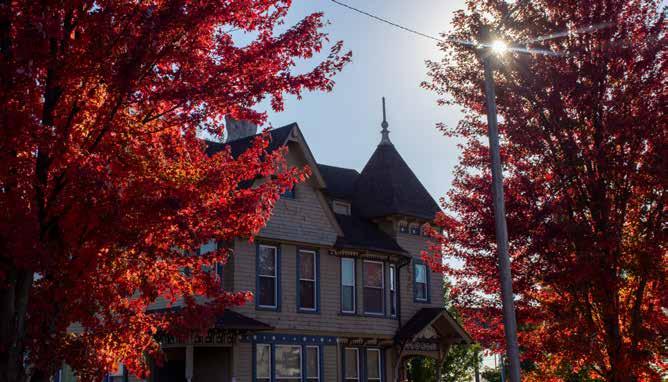
African/African-American Historical Museum
Michael Terronez, City of Fort Wayne
project on four vacant lots, introducing innovative housing models. Combined with Indiana Tech’s ongoing campus development, these initiatives signal the potential for reimagining East Central’s vacant land. However, fully realizing this potential will require coordinated investment, zoning reform, and development strategies that bring long-time residents together and align with the identified needs of the neighborhood.
Multi-lane one-way roads such as Jefferson Boulevard, Lafayette Street, Maumee Avenue and Washington Boulevard cut through the East Central neighborhood and present a persistent challenge to safety, walkability, and community cohesion. Originally designed to move high volumes of traffic quickly in and out of downtown, these corridors now act as both physical and psychological barriers that divide the neighborhood, discourage pedestrian activity, and hinder economic development. According to data from the U.S. Department of Transportation, roads with more than two travel lanes and vehicle speeds above 30 MPH significantly reduce pedestrian comfort and increase crash risk, particularly for children, seniors, and people with mobility challenges. These roads contribute to a sense of disconnection between residents, parks, institutions and downtown, and limit opportunities for street-level retail and active public spaces. As East Central seeks to grow and revitalize, addressing the impact of these roadways will be essential to improving safety, increasing foot
traffic and supporting a more connected, peoplecentered neighborhood.
The East Central Forward neighborhood plan recognizes these strengths and challenges are woven throughout the aspects of the neighborhood’s past and present. Addressing these challenges, through strategic investments, will leverage the neighborhood’s assets, build resilience, and help build a vibrant neighborhood for all residents.
Identifying and highlighting neighborhood assets is a foundational element of a neighborhood action plan. Assets—whether they are institutions, public spaces, historic structures, or community networks—represent the existing strengths that can be built upon. In East Central, these assets reflect the neighborhood’s character, values, and potential. By recognizing and incorporating them into the planning process, the neighborhood can focus on what works, guide strategic investments, and foster a shared sense of pride and ownership among residents.
The Albert G. Jennings Center is an important asset to the East Central neighborhood, serving as a hub for community engagement, youth development, and recreational programming.
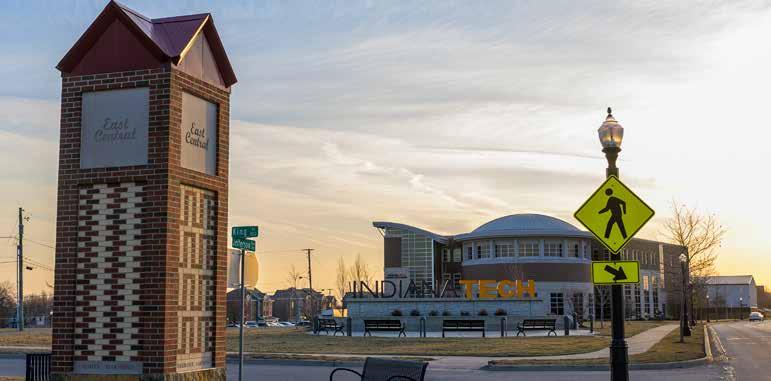



As a neighborhood-based facility operated by the City of Fort Wayne’s Parks and Recreation Department, it provides residents of all ages with access to a variety of resources while also serving as a public gathering space for community programming. The Jennings Center fosters connection, promotes health and wellness, and plays a central role in strengthening community pride in East Central.
Hanna Homestead Park:






Hanna Homestead Park is an important asset to the East Central neighborhood, offering residents an open green space for recreation, relaxation, and community gathering. Its central location makes it a natural focal point for neighborhood activity, supporting physical health and connection. As one of the few accessible park spaces in the area, Hanna Homestead Park plays a key role in enhancing the neighborhood’s quality of life and providing a safe, outdoor environment for families, children, and residents of all ages.
Indiana Tech:
Indiana Tech is a significant institutional asset to the East Central neighborhood because it brings educational opportunity, economic investment, and community partnership into the heart of the area. The campus provides access to higher education, job training, and cultural programming for residents, while also offering potential collaborations on neighborhood projects, research, and service initiatives. Its presence supports local businesses, enhances walkability, and strengthens the neighborhood’s identity as a place of innovation, learning, and opportunity.
Hanna Street Trail:
The construction of the final segment on the Hanna Street Trail will prove to be a vital asset to the East Central neighborhood, providing safe accessible path for walking, biking, and connecting to the broader citywide trail network from downtown to Fort Wayne’s southeast side. The trail enhances mobility options for residents, supports active lifestyles, and strengthens connections across the city. By promoting healthier transportation options and increasing access to public space, the Hanna Street Trail is anticipated to contribute to the neighborhood’s overall quality of life, safety, and connectivity.
The African/African American Historical Museum located on Douglas Street is a cultural and educational asset to the East Central neighborhood, preserving and celebrating the rich heritage, contributions, and experiences of Black residents in Fort Wayne. Located in the neighborhood, the museum provides residents and visitors with a deeper understanding of local history, fosters pride, and serves as a space for learning and reflection. Its presence strengthens the neighborhood’s identity, supports tourism, and reinforces East Central’s role as a center of historical and cultural significance in Fort Wayne.
Documenting East Central’s assets is not just about acknowledging what already exist, it’s about using those strengths to build momentum for long-term change. When residents, partners, and stakeholders see the value of what is already present, it becomes easier to mobilize support, attract resources, and shape a future for the East Central neighborhood that can be enjoyed by all.

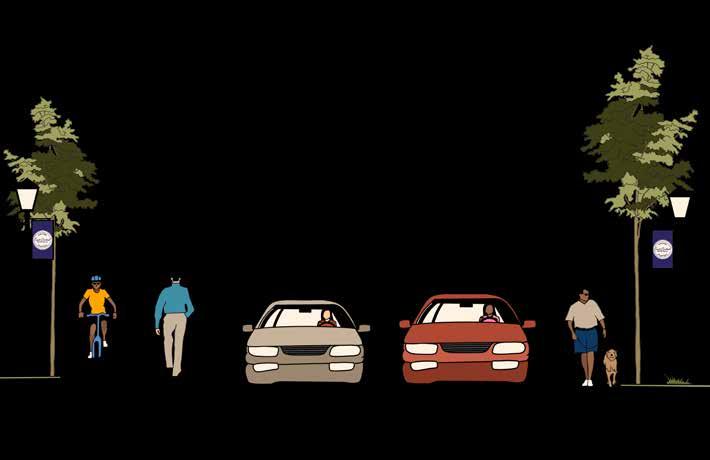
Berry Street Streetscape Rendor
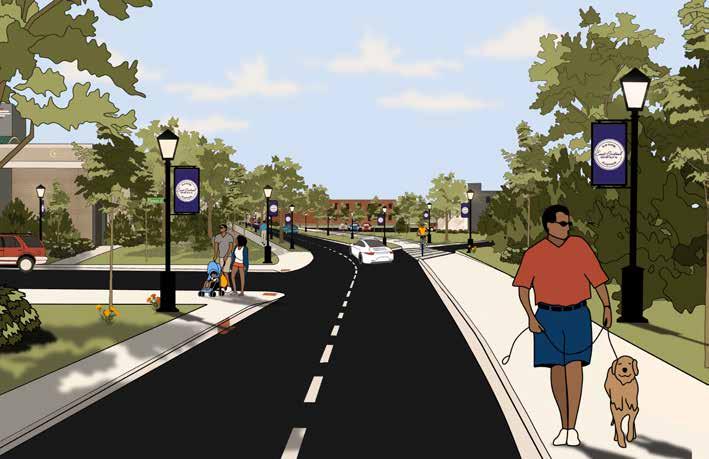
Berry Street Rendor
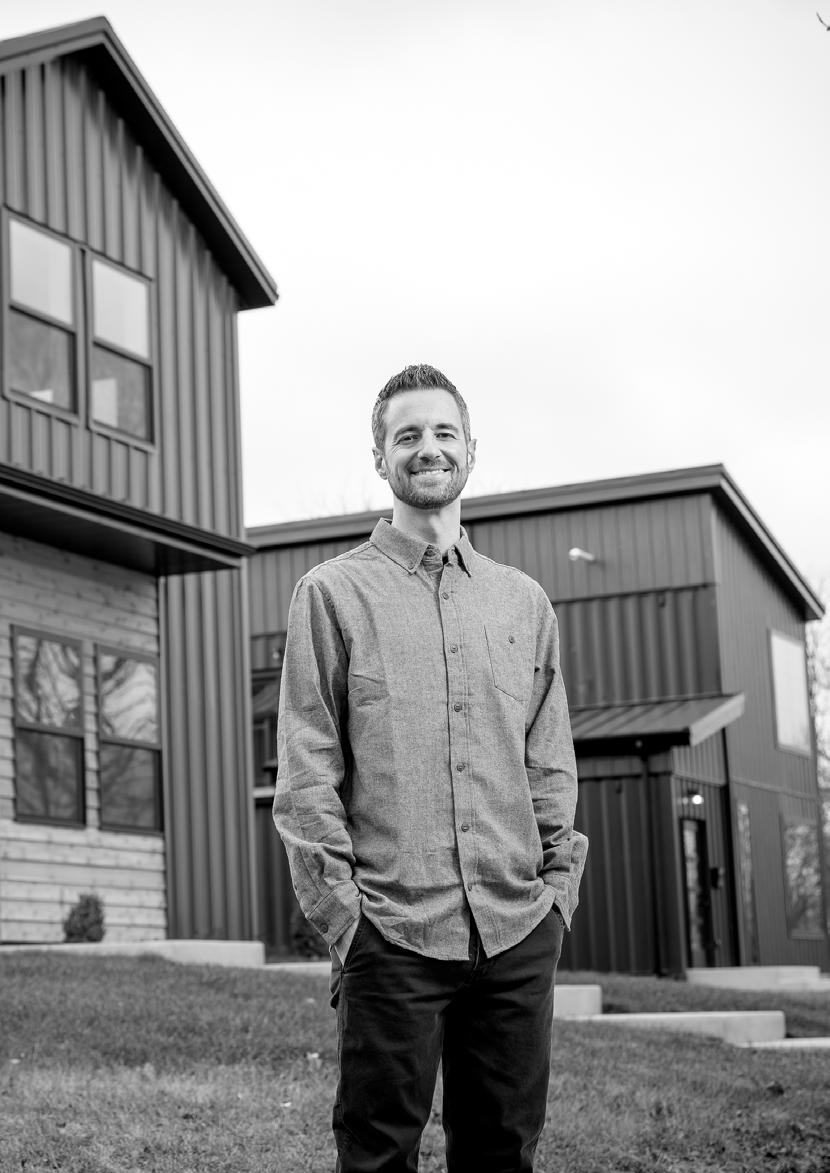
East Central already holds the solutions it needs— the neighbors are uniting, collaborating, and taking ownership of their future. This plan is just the spark; the real power lies in the people who call it home.
J.T. King - Royal Developments
Recommentdations from this plan are organized into five topic areas: Safe Community, History and Heritage, Improved Housing, Quality Place, and Thriving Community. Within each category is a vision statement that reflects the input received during the planning process and is used to guide the plan recommendations. While the plan includes some major projects that could have a transformative impact on the neighborhood, several small-scale projects are encouraged to help support major projects and enhance the quality of life for all residents.




East Central is a resilient neighborhood where residents feel safe, connected and proud. Through community-driven strategies, investment in public spaces, and strong relationships, East Central Forward fosters a vibrant, welcoming environment for all.


Safe Community Overview: Creating a safe, clean and welcoming environment is essential to move East Central forward. Throughout the planning process, residents consistently identified safety and neighborhood cleanliness as top priorities, a concern echoed in public meetings, surveys, and block-byblock listening events. These concerns are underscored by recent data: in 2024, East Central experienced its highest overall crime rate since 2010, or 40% higher than the 10-year average, and 26% higher than post-pandemic years. Although a change in how aggravated assaults are reported partially explains the rise in violent crime statistics, nonviolent crimes such as larceny, vehicular theft, and property crimes also saw increases. This data confirms that safety is not only a perceived issue, but also a pressing, measurable reality.
The Safe Community section of East Central Forward responds directly to these challenges through two core strategies: empowering residents to take an active role in neighborhood efforts to improve cleanliness and beautification, and implementing Crime Prevention Through Environmental Design to reduce crime through thoughtful improvements to the built environment that have a positive impact on the neighborhood. These strategies are grounded in resident leadership and proven safety interventions, such as lighting upgrades, enhanced visibility and community involvement in public spaces. By aligning these practical strategies with the lived experience of residents, this section provides a focused, collaborative framework for building a safer East Central.

East Central residents actively contribute to and take pride in a safe, clean, and beautiful neighborhood.
Strategy 1.1:
Empower residents to enhance the cleanliness and appearance of East Central through community-led cleanup initiatives
Action Steps
1.1.1 Partner with Indiana Tech and Neighborhood Code Compliance to organize regular community cleanup events throughout the year.
1.1.2 Collaborate with the Solid Waste Department to host community dumpster days annually.
Strategy 1.2:
Improve safety and security in East Central by implementing Crime Prevention Through Environmental Design (CPTED) Strategies
Action Steps
1.2.1 Develop a CPTED Strategy for the intersection of Hanna and Lewis to address specific safety issues.
1.2.2 Develop and implement a strategy to improve and maintain vacant lots to reduce crime and improve neighborhood aesthetic.
1.1.3 Implement a mattress disposal program with the Solid Waste Department.





Vision Statement:
East Central is a neighborhood rooted in legacy, where the stories of past generations shape its spirit today. East Central Forward envisions a future that honors Black and immigrant contributions, preserves historic places and stories, and celebrates heritage as a source of pride, identity, and community connection.
History and Heritage Overview: The history and heritage of East Central is among its most powerful assets, rooted in centuries of transformation, cultural contributions, and community resilience. This section of the East Central Forward neighborhood plan recognizes that understanding and honoring the past is essential to shaping a vibrant future for residents. East Central has always been a place where significant events have unfolded that shaped the entire city. Today, many of the neighborhood’s cultural landmarks and historical narratives remain at risk.
This plan addresses that concern by prioritizing strategies that identify, preserve, and celebrate East Central’s deep roots. Community-driven projects will establish oral history archives, landmark significant sites through heritage markers, and create visually powerful public art installations that tell the story of East Central’s people and places. Moreover, enhanced gateways will restore visibility and pride in the neighborhood. By elevating its history, East Central reclaims its rightful place in the city’s narrative. These efforts not only build community pride and connection among residents, but also support economic development, tourism, and neighborhood cohesion. In telling East Central’s story, and ensuring its presence in the community, the neighborhood honors its past while building its future.
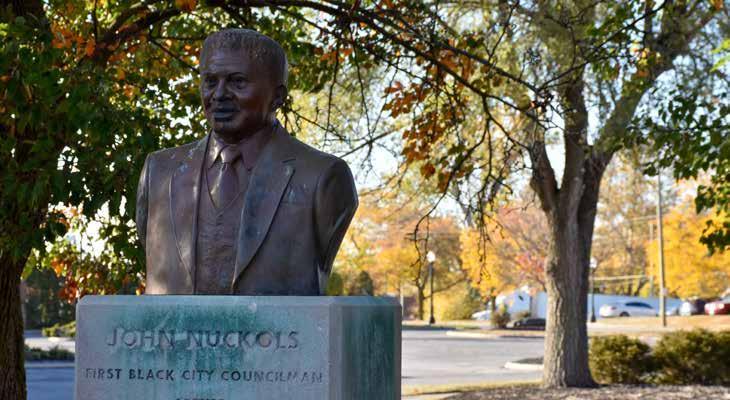
Statue Commemorating John Nuckols
Michael Terronez, City of Fort Wayne
East Central’s history and heritage are a source of community pride and are actively celebrated.
Engage the East Central community in identifying, preserving, and celebrating its history and historic resources
Action Steps
2.1.1 Work with the Allen County Public Library to develop a digital and oral history archive for the East Central Neighborhood.
2.1.2 Work with the Historic Preservation Commission to complete a historic resources inventory to identify and nominate structures and areas eligible for the National Register of Historic Places and Local Historic designation.
Tell the story of East Central’s history and heritage through compelling public art and signage that enhances the neighborhood’s identity and sense of place
Action Steps
2.2.1 Collaborate with Public Works and the Public Art Commission to transform traffic control boxes into vibrant displays of public art that communicate the rich history and cultural heritage of the East Central Neighborhood.
2.2.2 Collaborate with the Public Art Commission to create public art installations that serve as landmarks and tell the stories of significant people, events, and places in East Central’s history.
2.1.3 Work with the Historic Preservation Commission and the Fort Wayne Committee of the Indiana Landmarks Black Heritage Program to designate structures and sites as National Register of Historic Places and/or Local Historic Districts and install heritage markers.





Establish a strong visual identity for East Central by enhancing neighborhood gateways that clearly define its boundaries and celebrate its unique character
2.3.1 Partner with the Foellinger Foundation to install distinctive lighting and signage at the Clay and Berry Street gateway, reflecting East Central’s brand.
2.3.2 Collaborate with Public Works to improve pedestrian safety and enhance the Coombs Street gateway with new lighting and sidewalks, creating a welcoming entrance to the neighborhood.
2.3.3 Collaborate with the Fort Wayne Public Art Commission to install a mural on the retaining walls near Coombs and Liberty streets that showcases East Central’s history, culture, and identity.
2.3.4 Work with Public Works to install new railroad overpass signage and lighting on Hanna Street (northbound), clearly marking the entry into East Central.
2.3.5 Install consistent medallion signage with East Central Neighborhood logo and name along primary corridors, reinforcing the neighborhood’s identity.
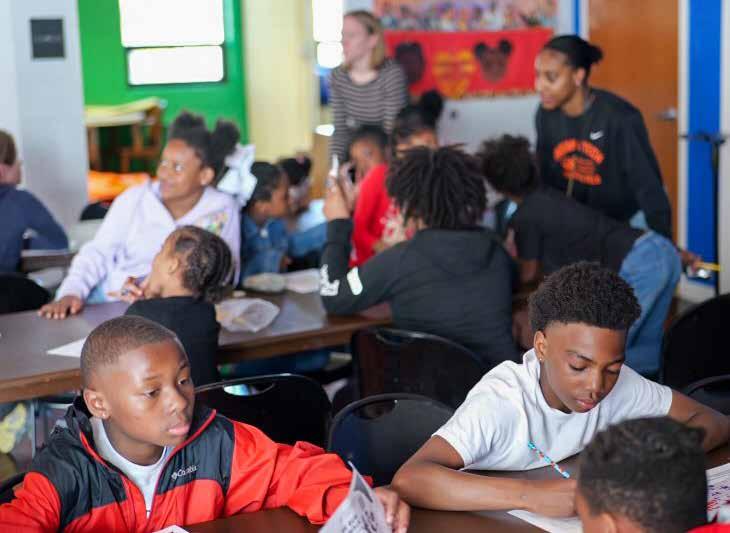
Jennings Center Youth Cameron Chandler, Indiana Tech
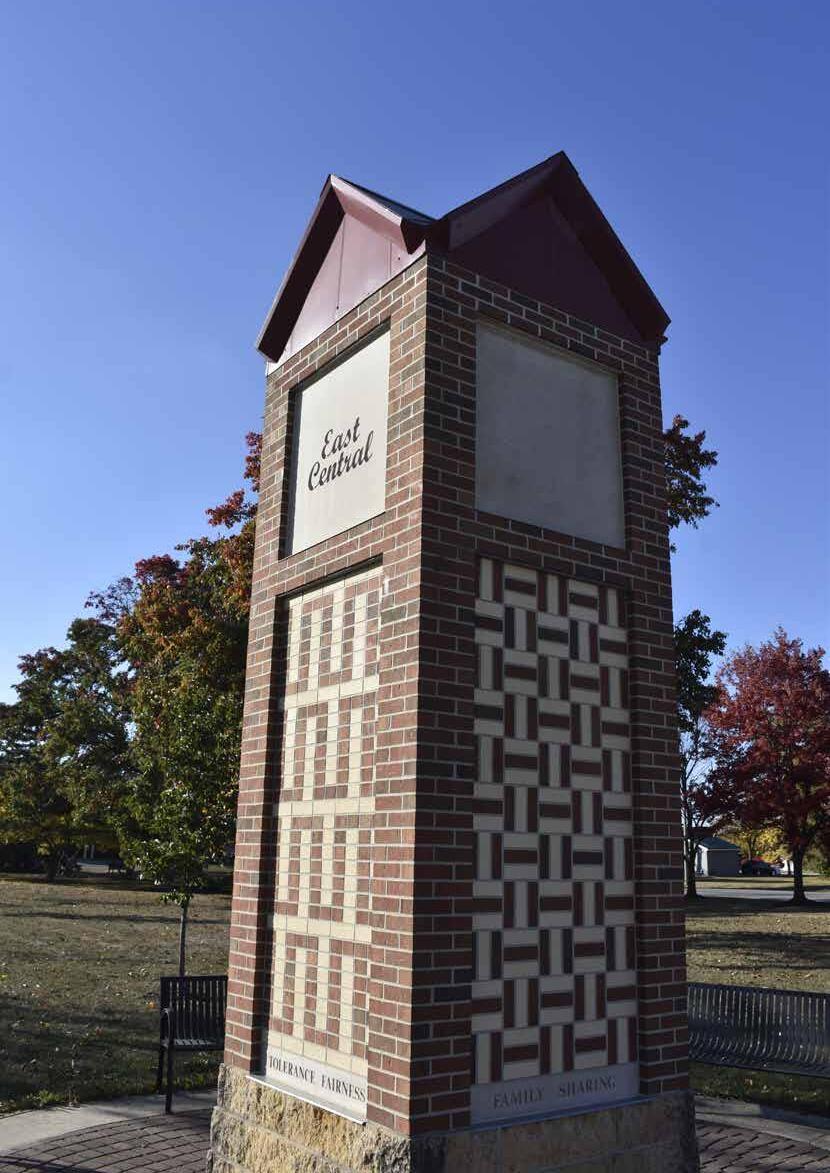





Vision Statement:
Vision Statement: East Central envisions a neighborhood where every resident has access to safe, high-quality, and affordable housing that supports long-term stability. East Central Forward recognizes that housing is not just shelter, but the foundation for dignity, community, and generational opportunity.
Improved Housing Overview: Housing lies at the core of neighborhood stability, economic opportunity, and quality of life. In East Central, decades of disinvestment, population decline, and an aging housing stock have created significant challenges, yet it also presents critical opportunities as the neighborhood moves forward. Over 63% of neighborhood households rent their homes, and a large portion of the existing housing is in need of repair or modernization. Many properties are owned by absentee landlords, and vacancy rates remain high in some areas, which contributes to perceptions undercutting community pride. The Improved Housing section of the East Central Forward plan responds directly to these challenges with a vision for a more stable and attractive housing landscape. By focusing on the rehabilitation of existing homes in the neighborhood, encouraging diverse infill development, and expanding access to homeownership, this plan aims to transform housing into a catalyst for neighborhood revitalization. Supporting both long-time residents and those who choose to move to the neighborhood, these efforts will help encourage neighborhood investment and ensure that residents can remain in and contribute to, the future of East Central.
Using the study completed in May 2025 by Zimmerman Volk, the East Central neighborhood can realistically capture the following annual housing demand:
Apartments (Multi-Family Rental): 47-58 units/year
Market Rate: 35-43 units (avg. rent ~$1,292/month)
Workforce (60-80% AMI): 12-15 units (avg. rent ~$1,097/month)
Single-Family Detached Homes (For Sale): 5-10 units/year
Market Rate: 3-6 homes (avg. price ~$369,800)
Workforce (60-100% AMI): 2-4 homes (avg. price ~$214,000)
Townhouses (Single-Family Attached For Sale): 5-6 units/year
Market Rate: 3-4 units (avg. price ~$347,000)
Workforce (60-100% AMI): 2 units (avg. price ~$241,100)
Condominiums (Multi-Family For Sale): 3-4 units/year
Market Rate: 2 units (avg. price ~$364,286)
Workforce (60-100% AMI): 1-2 units (avg. price ~$227,300)
This data supports the recent trends with downtown growth that housing opportunities in East Central align with growing preferences for downtown living, affordability and neighborhood vibrancy.
East Central offers residents a range of safe, high-quality, and affordable housing options that meet diverse needs and preferences.
Strategy 3.1:
Enhance East Central’s housing stock through maintenance, improvement, and preservation efforts
Action Steps
3.1.1 Work with the City of Fort Wayne Office of Housing and Neighborhood Services to develop a curb appeal matching grant program specifically for East Central homeowners.
Increase housing availability and diversity in East Central through strategic infill development
Action Steps
3.2.1 Collaborate with the City of Fort Wayne Office of Housing and Neighborhood Services to develop incentives for infill development.
3.1.2 Develop a proactive system to collaborate with neighborhood code enforcement to identify and address properties in need of inspection and ensure timely follow-up on code violations.
Strategy
Expand homeownership opportunities in East Central
Action Steps
3.3.1 Partner with local organizations to provide resources and programs to promote and support homeownership.
3.3.2 Collaborate with City of Fort Wayne Metropolitan Housing Authority to connect potential homebuyers with fair housing education.
3.2.2 Utilize the 2025 East Central Housing Market Potential Study and parner with neighborhood property owners (Indiana Tech, Pilgrim Baptist Church, Office of Housing & Neighborhood Services) to identify areas for infill housing & ensure new infill meets the demands for the East Central community.




Vision Statement:
Vision Statement: East Central envisions a future centered on walkability, connectivity, and recreation where safe streets, modern sidewalks, and vibrant public spaces support a healthy, active community. By addressing high-traffic corridors and enhancing trails and public transportation, East Central Forward aims to reconnect the neighborhood internally and to the broader city.


Quality Place Overview: A well-designed, connected physical environment is critical to the long-term health, identity, and success of the East Central neighborhood. The quality place section of the East Central Forward plan focuses on strengthening the neighborhood’s infrastructure, public spaces, and physical connections to ensure that every resident can move safely, access essential amenities, and take pride in their surroundings. For a neighborhood shaped by decades of historical disinvestment, investing in sidewalks, lighting, trails, transit access, and parks is not just about beautification, it’s about equity, safety, and improved quality of life.As East Central continues to evolve, enhancing its sidewalks, calming traffic, improving infrastructure and connectivity to key neighborhood assets, and activating public spaces will foster social connection, public health, and neighborhood vitality. These improvements build a foundation for East Central to thrive as a walkable, accessible, and livable neighborhood for generations to come.
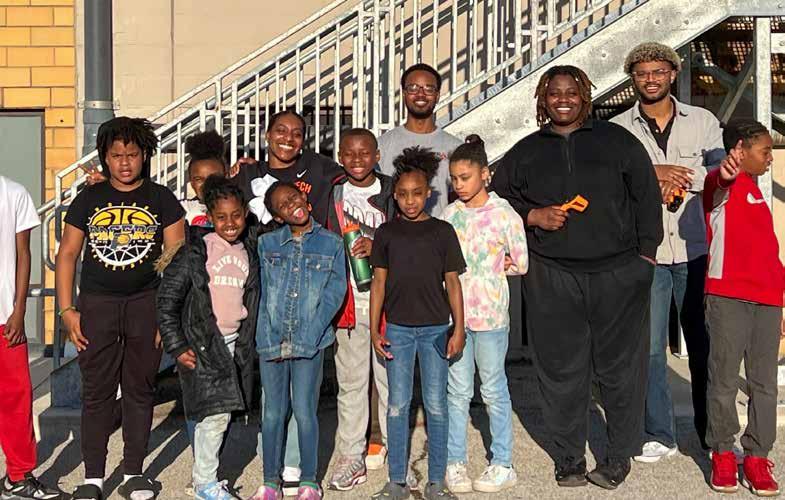
East Central residents have access to safe, reliable, and connected infrastructure.
Strategy 4.1:
Encourage connectivity and expansion of the city Trail Network in the East Central Neighborhood
Action Steps
4.1.1 Collaborate with Public Works to install new lighting on Hanna Street to improve pedestrian safety.
4.1.2 Upon trail completion, work with Public Works to install branded way finding signs to and on the Hanna Street Trail.
Strategy 4.2:
Support safe access to public transit within the East Central Neighborhood
Action Steps
4.2.1 Collaborate with Citilink and Public Works on the installation of new bus shelters at highuse Citilink stops along the following bus route corridors:
• Clay Street
• S. Hanna Street
• E. Lewis Street
• E. Washington Boulevard
• E. Wayne Street
4.2.2 Promote and support community efforts for increased funding to sustain and grow public transit service.
4.1.3 Collaborate with Public Works to review sidewalk connectivity to the Hanna Street Trail to ensure safe and accessible sidewalk connections.
4.1.4 Encourage additional trail development along Berry Street to connect the Hanna Street Trail to downtown and the Rivergreenway.




4.3.1 Collaborate with Public Works to Install pedestrian-scale street lighting in the following areas:
• E. Lewis Street (Lafayette to Anthony)
• E. Monroe Street (Berry to Hayden)
• Clay Street (Berry to Hayden)
• Madison Street (Lafayette to Hanna)
• Francis Street (Berry to Lewis)
• Coombs Street (Wayne to Tecumseh)
• Harmar Street (Washington to Liberty)
4.3.3 Ensure that lighting is adequate outside and within walking distance to both the Jennings Center and Hanna Homestead Park to improve safety
4.3.4 Collaborate with Public Works to install new concrete bump-outs on Lewis Street near Hanna Homestead Park and Jennings Center to improve safety.


4.3.2 Collaborate with Public Works to improve the existing neighborhood sidewalks and crosswalks, with a priority on the following streets:
• E. Lewis Street
• Hugh Street
• Monroe Street
• E. Brackenridge Street
• Francis Street
• Coombs Street
• Harmar Street
4.4.1 Collaborate with Public Works to assess the condition of primary east/west corridors between East Central and Downtown Fort Wayne and prioritize upgrades that support connectivity.
4.3.5 Collaborate with Public Works to develop a corridor improvement plan that includes traffic calming, pedestrian crossings, and streetscape improvements for E. Jefferson Boulevard and Maumee Avenue between Lafayette Street and Anthony Boulevard.
East Central residents enjoy equitable access to and actively utilize high-quality parks, public spaces, and recreational facilities that foster community and enhance quality of life
Assess the needs of East Central’s diverse community and develop a plan to adapt public facilities and parks to address identified needs
Action Steps
5.1.1 Encourage accessibility improvements to the Jennings Center where possible.
5.1.2 Develop and implement a fundraising strategy with Fort Wayne Parks and Recreation to raise funds to develop and improve Hanna Homestead Park.
5.1.3 Support the implementation of the Hanna Homestead Park Master Plan.
Strategy 5.2: Enhance community engagement and resident well-being in East Central through targeted programming
Action Steps
5.2.1 Support Parks and Recreation efforts to expand all-day programming at area community centers and parks.
5.2.2 Explore youth mentorship opportunities through a partnership with Big Brothers - Big Sisters.
5.2.3 Promote bicycle and pedestrian safety by hosting an annual bike safety event programming on area trails.
5.2.4 Partner with area faith-based organizations to develop new neighborhood programs such as youth development, community outreach, and senior support.

Development in East Central reflects the community’s vision for its future.





Encourage the alignment and modification of zoning district designations that support desired development and reflect the community’s vision for East Central
6.1.1 Consider the application of Multifamily
Residential (R3) zoning designations along Hanna and Lewis Streets to encourage appropriate neighborhood-oriented commercial infill.
6.1.2 Consider the application of Urban Corridor (UC) zoning designations along Maumee Avenue, East Washington, and East Wayne to encourage appropriate neighborhood-oriented commercial and residential infill.
6.1.3 Consider the application of Multifamily
Residential (R3) zoning designations North on Ohio and East Lewis Streets to encourage appropriate neighborhood-oriented residential infill.
6.1.4 Consider the application of Limited Commercial (C2) between Brackenridge and Hayden, along South Hanna to match current adjacent zoning.
6.1.5 Consider the application of Urban Corridor (UC) zoning designations between East Wayne and East Berry along Hanover to match curret and encourage appropriate future uses.
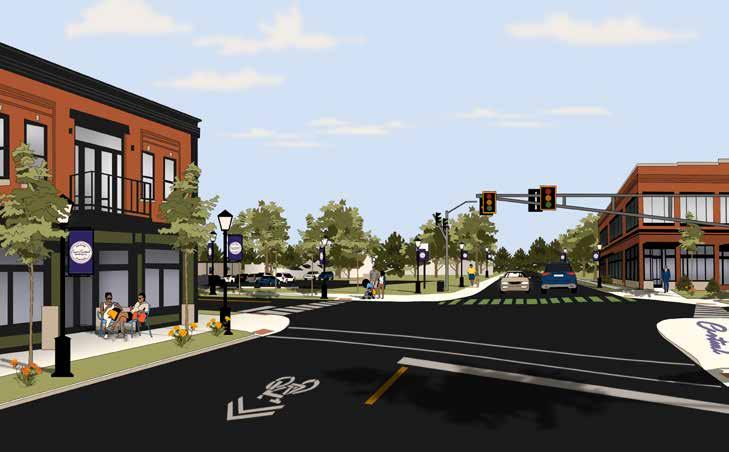
PROPOSED ZONING
- General Commercial
- Limited Commercial
C3 - General Commercial
- Limited Commercial
R3 - Multiple Family Residential
I2 - General Industrial
R2 - Two Family Residential
C3 - General Commercial




Vision Statement:
Vision Statement: East Central is a connected and resilient neighborhood where residents are empowered to engage, contribute, and thrive. Through strong partnerships, support for small businesses, and a focus on health and sustainability, East Central Forward builds a foundation for civic engagement and a shared, forward-looking purpose.


Thriving Community Overview: At the heart of every neighborhood are the people who call it home. A thriving community ensures that residents can live healthy, connected, and empowered lives. In East Central, decades of inequitable practices have left lasting impacts on economic stability, health outcomes, and access to opportunity. Today, residents face disproportionately high rates of chronic illnesses such as diabetes, obesity, high blood pressure, and depression, along with growing levels of social isolation, food insecurity, and housing instability. These are not individual shortcomings, but the result of structural challenges embedded in the social determinants of health, factors such as income, education, transportation, neighborhood safety, and access to healthcare and public spaces. Despite these barriers, East Central residents continue to lead with resilience, creativity, and determination. The East Central Forward plan recognizes both the urgency of improving health and wellbeing and the power of community-driven change, by prioritizing people-centered development through expanded health services, small business support, and strategic partnerships with institutions like Indiana Tech.
This section outlines specific strategies to advance community wellness, strengthen neighborhood connections, grow local entrepreneurship, and ensure development aligns with the lived experiences and needs of residents. These include expanded healthcare access, mobile wellness services, increased food access, and the creation of welcoming public spaces and communication networks that boost awareness and participation. Health is more than the absence of illness—it is the presence of safety, dignity, opportunity, and connection. By responding directly to resident voices and data, this section focuses on elevating small business growth, addressing unsheltered residents’ needs, and strengthening community ties through programming, education, and partnerships. East Central’s proximity to downtown, walkable layout, and strong institutional allies position it to reclaim a position in the region’s economic future. But for transformation, investments in East Central must center not only on infrastructure, but on people. East Central Forward charts a path toward a resilient and thriving neighborhood, led by the very community it serves.
East Central residents are well connected to social events, community partners, and neighbors.
Strategy 7.1:
Increase community awareness and participation in East Central activities and events
Action Steps
7.1.1 Create a collaborative network with faithbased organizations in East Central to coordinate and amplify the promotion of community activities and events.
7.1.2 Implement a consistent communication schedule through neighborhood association channels to promote Jennings Center programs, classes, and events to East Central residents.
Strategy 7.2:
Foster small business growth and development in East Central by connecting entrepreneurs and small business owners with the City of Fort Wayne Summit City Entrepreneur and Enterprise District (SEED) program
Action Steps
7.2.1 Provide tailored support to neighborhood businesses and entrepreneurs in navigating the SEED program application process and accessing relevant resources.
7.2.2 Promote East Central businesses located in or near the Downtown Improvement District (east of Lafayette), and work to develop a relationship with the neighborhood.




Strategy 7.3:
Strengthen the partnership between East Central and Indiana Tech to enhance community development
Action Steps
7.3.1 Collaborate with Indiana Tech’s communications programs to support neighborhood print and visual communication efforts.
7.3.2 Partner with Indiana Tech to offer neighborhood-focused courses (e.g., leadership, communications) for residents.


East Central fosters a healthy and sustainable community for residents to live, work, and play.
Strategy 8.1: Improve physical and mental health outcomes for East Central residents
8.1.1 Work with community health organizations to develop and implement a place-based health improvement plan for the 46803 Zip Code.
Strategy 8.2: Work with local agencies to develop physical and mental health services in the East Central
Action Steps
8.2.1 Invite local health partners to participate in neighborhood events and attend neighborhood meetings.
8.2.2 Work with Fort Wayne Parks and Recreation Department to consider piloting mobile health programs and services at the Jennings Center.
Enhance access to resources and support for unsheltered residents in East Central through collaborative partnerships
8.3.1 Communicate available resources for unsheltered residents, including information on shelters, food banks, healthcare, and other essential servicesthrough neighborhood association communication channels.
8.3.2 Develop a volunteer inspection and reporting program to encourage consistent maintenance of public spaces in East Central, including trash collection, regular cleaning, and lighting maintenance, with a focus on creating a welcoming environment for all.
8.3.3 Invite the Fort Wayne Police Department Hope and Recovery Team (HART) and other relevant service providers to attend neighborhood events and meetings to promote services provided to residents.
Strategy
Enhance environmental sustainability and resilience in East Central
8.4.1 Work with the City of Fort Wayne’s Arborist to develop an annual tree planting program to increase the street tree canopy by at least 20% over the next ten years.
8.4.2 Partner with the Tree Canopy Growth Fund (TCFG) to provide private property trees for residents for free.
8.4.3 Work with the Indiana Tech Sustainability program to study heat-related health impacts on residents.
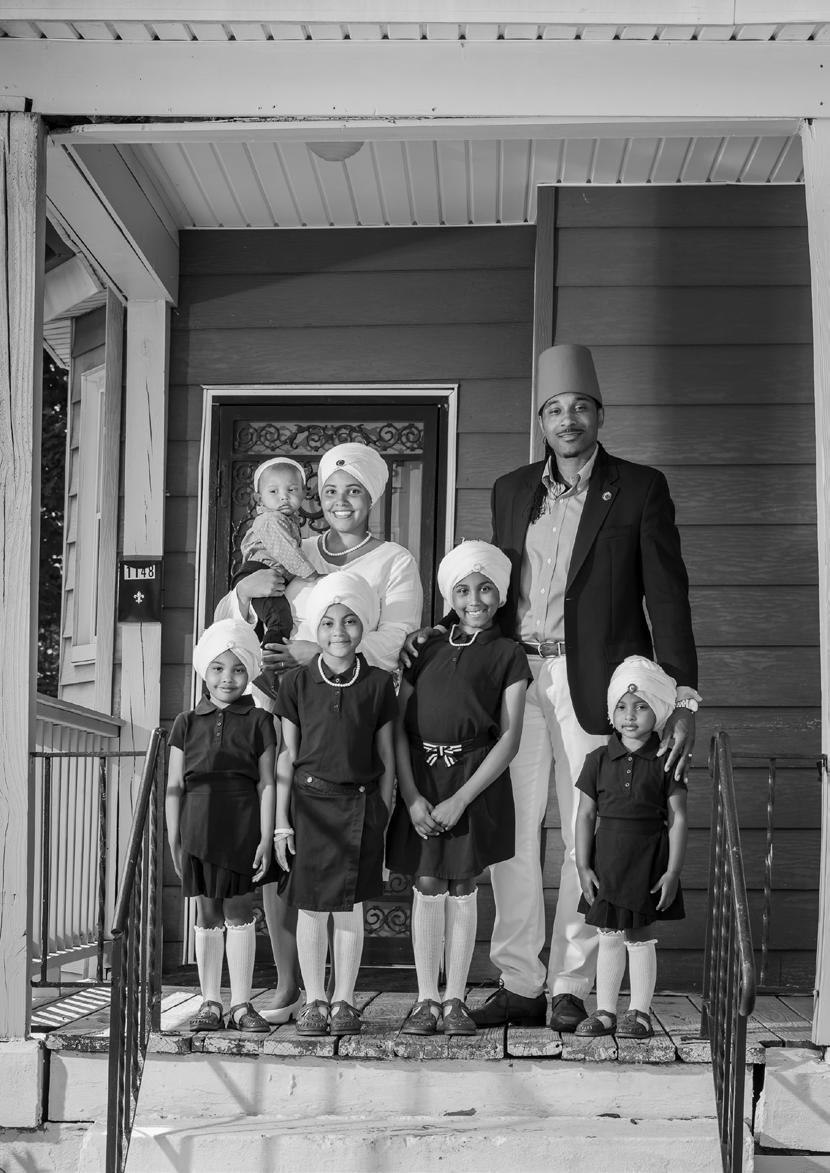
We are looking forward to a connected community that exemplifies the spirit of family, respect, and safety. One capable of fostering old school values while utilizing new school solutions.
The Page Bey Family - East Central Residents and Moorish Science Temple Members





East Central residents actively contribute to and take pride in a safe, clean, and beautiful neighborhood.
1. Partner with Indiana Tech and Neighborhood Code Compliance to organize regular community cleanup events throughout the year.
2. Collaborate with the Solid Waste Department to host community dumpster days annually.
3. Implement a mattress disposal program with the Solid Waste Department.
4. Develop a CPTED Strategy for the intersection of Hanna and Lewis to address specific safety issues.
5. Develop and implement a strategy to improve and maintain vacant lots to reduce crime and improve neighborhood aesthetic.


East Central’s history and heritage are a source of community pride and are actively celebrated.
6. Work with the Allen County Public Library to develop a digital and oral history archive for the East Central Neighborhood.
7. Work with the Historic Preservation Commission to complete a historic resources inventory to identify and nominate structures and areas eligible for the National Register of Historic Places and Local Historic designation.
8. Work with the Historic Preservation Commission and the Fort Wayne Committee of the Indiana Landmarks Black Heritage Program to designate structures and sites as National Register of Historic Places and/or Local Historic Districts and install heritage markers.
9. Collaborate with Public Works and the Public Art Commission to transform traffic control boxes into vibrant displays of public art that communicate the rich history and cultural heritage of the East Central Neighborhood.
10. Collaborate with the Public Art Commission to create public art installations that serve as landmarks and tell the stories of significant people, events, and places in East Central’s history.
11. Partner with the Foellinger Foundation to install distinctive lighting and signage at the Clay and Berry Street gateway, reflecting East Central’s brand.
12. Collaborate with Public Works to improve pedestrian safety and enhance the Coombs Street gateway with new lighting and sidewalks, creating a welcoming entrance to the neighborhood.
13. Collaborate with the Fort Wayne Public Art Commission to install a mural on the retaining walls near Coombs and Liberty streets that showcases East Central’s history, culture, and identity.
14. Work with Public Works to install new railroad overpass signage and lighting on Hanna Street (northbound), clearly marking the entry into East Central.
15. Install consistent medallion signage with East Central Neighborhood logo and name along primary corridors, reinforcing the neighborhood’s identity.







East Central offers residents a range of safe, highquality, and affordable housing options that meet diverse needs and preferences.
1. Work with the City of Fort Wayne Office of Housing and Neighborhood Services to develop a curb appeal matching grant program specifically for East Central homeowners.
2. Develop a proactive system to collaborate with neighborhood code enforcement to identify and address properties in need of inspection and ensure timely follow-up on code violations.
3. Partner with local organizations to provide resources and programs to promote and support homeownership.
4. Collaborate with City of Fort Wayne Metropolitan Housing Authority to connect potential homebuyers with fair housing education.
5. Collaborate with the City of Fort Wayne Office of Housing and Neighborhood Services to develop incentives for infill development.
6. Utilize the 2025 East Central Housing Market Potential Study and parner with neighborhood property owners (Indiana Tech, Pilgrim Baptist Church, Office of Housing & Neighborhood Services) to identify areas for infill housing & ensure new infill meets the demands for the East Central community.
East Central residents have access to safe, reliable, and connected infrastructure.
7. Collaborate with Public Works to install new lighting on Hanna Street to improve pedestrian safety.
8. Upon trail completion, work with Public Works to install branded way finding signs to and on the Hanna Street Trail.
9. Collaborate with Public Works to review sidewalk connectivity to the Hanna Street Trail to ensure safe and accessible sidewalk connections.
10. Encourage additional trail development along Berry Street to connect the Hanna Street Trail to downtown and the Rivergreenway.
11. Collaborate with Citilink and Public Works on the installation of new bus shelters at highuse Citilink stops along the following bus route corridors.
12. Promote and support community efforts for increased funding to sustain and grow public transit service.
13. Collaborate with Public Works to Install pedestrian-scale street lighting.
14. Collaborate with Public Works to improve the existing neighborhood sidewalks and crosswalks.
15. Ensure that lighting is adequate outside and within walking distance to both the Jennings Center and Hanna Homestead Park to improve safety.
16. Collaborate with Public Works to install new concrete bump-outs on Lewis Street near Hanna Homestead Park and Jennings Center to improve safety.
17. Collaborate with Public Works to develop a corridor improvement plan that includes traffic calming, pedestrian crossings, and streetscape improvements for E. Jefferson Boulevard and Maumee Avenue between Lafayette Street and Anthony Boulevard.
18. Collaborate with Public Works to assess the condition of primary east/west corridors between East Central and Downtown Fort Wayne and prioritize upgrades that support connectivity.






East Central residents enjoy equitable access to and actively utilize high-quality parks, public spaces, and recreational facilities that foster community and enhance quality of life
Action Steps
1. Encourage accessibility improvements to the Jennings Center where possible.
2. Develop and implement a fundraising strategy with Fort Wayne Parks and Recreation to raise funds to develop and improve Hanna Homestead Park.
3. Support the implementation of the Hanna Homestead Park Master Plan.
4. Support Parks and Recreation efforts to expand all-day programming at area community centers and parks.
5. Explore youth mentorship opportunities through a partnership with Big Brothers - Big Sisters.
6. Promote bicycle and pedestrian safety by hosting an annual bike safety event programming on area trails.
7. Partner with area faith-based organizations to develop new neighborhood programs such as youth development, community outreach, and senior support.


Action Steps
8. Consider the application of Multifamily Residential (R3) zoning designations along Hanna and Lewis Streets to encourage appropriate neighborhood-oriented commercial infill.
9. Consider the application of Urban Corridor (UC) zoning designations along Maumee Avenue, East Washington, and East Wayne to encourage appropriate neighborhood-oriented commercial and residential infill.
10. Consider the application of Multifamily Residential (R3) zoning designations North on Ohio and East Lewis Streets to encourage appropriate neighborhood-oriented residential infill.
11. Consider the application of Limited Commercial (C2) between Brackenridge and Hayden, along South Hanna to match current adjacent zoning.
12. Consider the application of Urban Corridor (UC) zoning designations between East Wayne and East Berry along Hanover to match curret and encourage appropriate future uses.





East Central residents are well connected to social events, community partners, and neighbors.
Action Steps
1. Create a collaborative network with faithbased organizations in East Central to coordinate and amplify the promotion of community activities and events.
2. Implement a consistent communication schedule through neighborhood association channels to promote Jennings Center programs, classes, and events to East Central residents.
3. Provide tailored support to neighborhood businesses and entrepreneurs in navigating the SEED program application process and accessing relevant resources.
4. Promote East Central businesses located in or near the Downtown Improvement District (east of Lafayette), and work to develop a relationship with the neighborhood.
5. Collaborate with Indiana Tech’s communications programs to support neighborhood print and visual communication efforts.
6. Partner with Indiana Tech to offer neighborhood-focused courses (e.g., leadership, communications) for residents.


East Central fosters a healthy and sustainable community for residents to live, work, and play.
Action Steps
7. Work with community health organizations to develop and implement a place-based health improvement plan for the 46803 Zip Code.
8. Invite local health partners to participate in neighborhood events and attend neighborhood meetings.
9. Work with Fort Wayne Parks and Recreation Department to consider piloting mobile health programs and services at the Jennings Center.
10. Communicate available resources for unsheltered residents, including information on shelters, food banks, healthcare, and other essential servicesthrough neighborhood association communication channels.
11. Develop a volunteer inspection and reporting program to encourage consistent maintenance of public spaces in East Central, including trash collection, regular cleaning, and lighting maintenance, with a focus on creating a welcoming environment for all.
12. Invite the Fort Wayne Police Department Hope and Recovery Team (HART) and other relevant service providers to attend neighborhood events and meetings to promote services provided to residents.
13. Work with the City of Fort Wayne’s Arborist to develop an annual tree planting program to increase the street tree canopy by at least 20% over the next ten years.
14. Partner with the Tree Canopy Growth Fund (TCFG) to provide private property trees for residents for free.
15. Work with the Indiana Tech Sustainability program to study heat-related health impacts on residents.

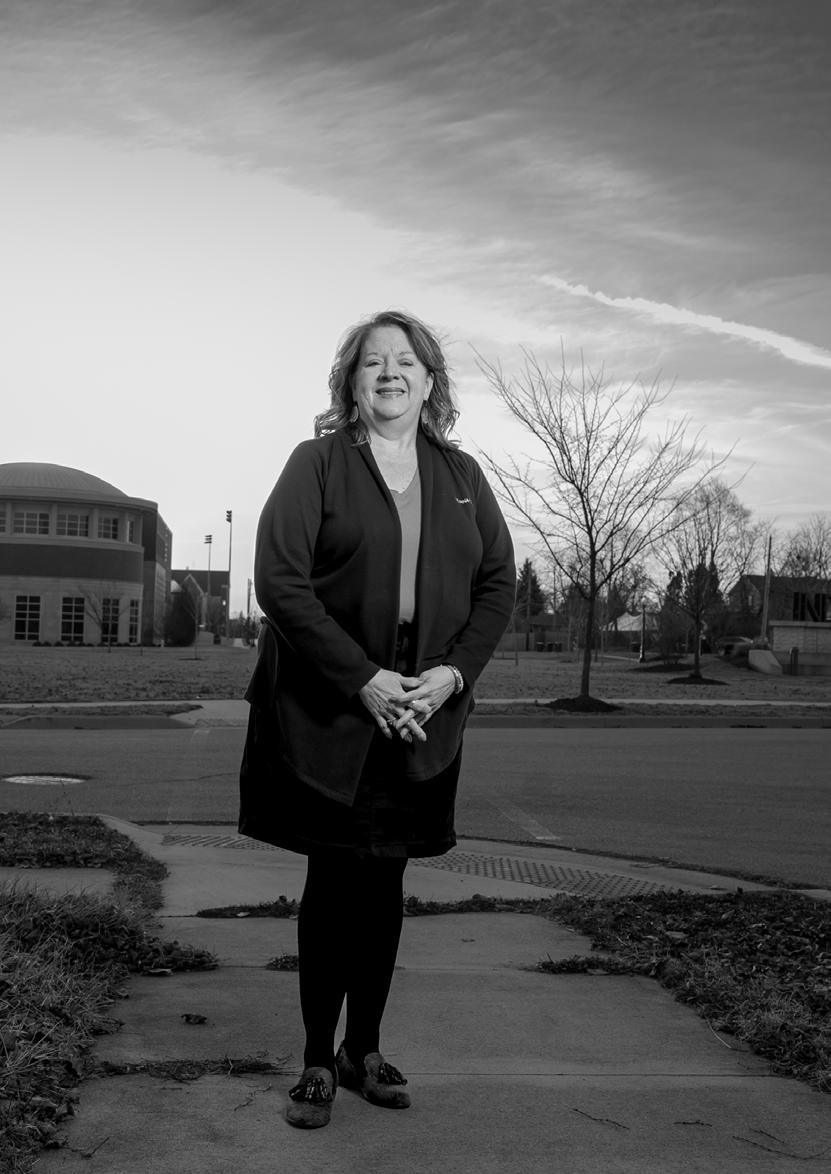
”Indiana Tech is proud to stand alongside the East Central Neighborhood. We see limitless potential in what this community can become as it embraces its identity, honors its history, and moves boldly toward a future full of opportunity.
Judy Roy - Indiana Tech Executive Vice President for Finance and Administration
